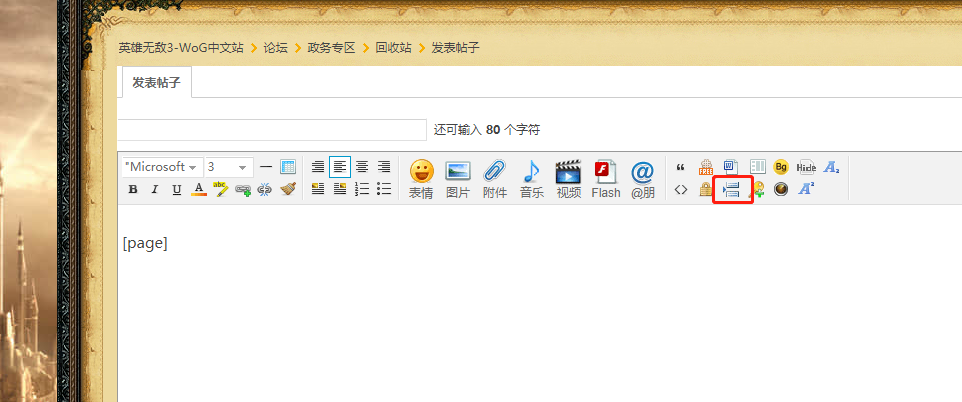Hota自带了超强的随机模板编辑,对于每个项目都有详细的解释。目前只有英文版,且对电脑分辨率要求较高,我的笔记本电脑居然无法完整显示。 我已经把它提取出来作为独立版使用. 可点此下载. 本人刚开始摸索,可以在现有模板基础上进行简单修改. 可以在每个区域或线条上右键进行详细设置. 可以精确到允许哪些物品出现, 允许多少怪物等. 强烈建议有,英文基础的玩家深入研究。 详细说明见此链接 https://h3hota.com/en/templates 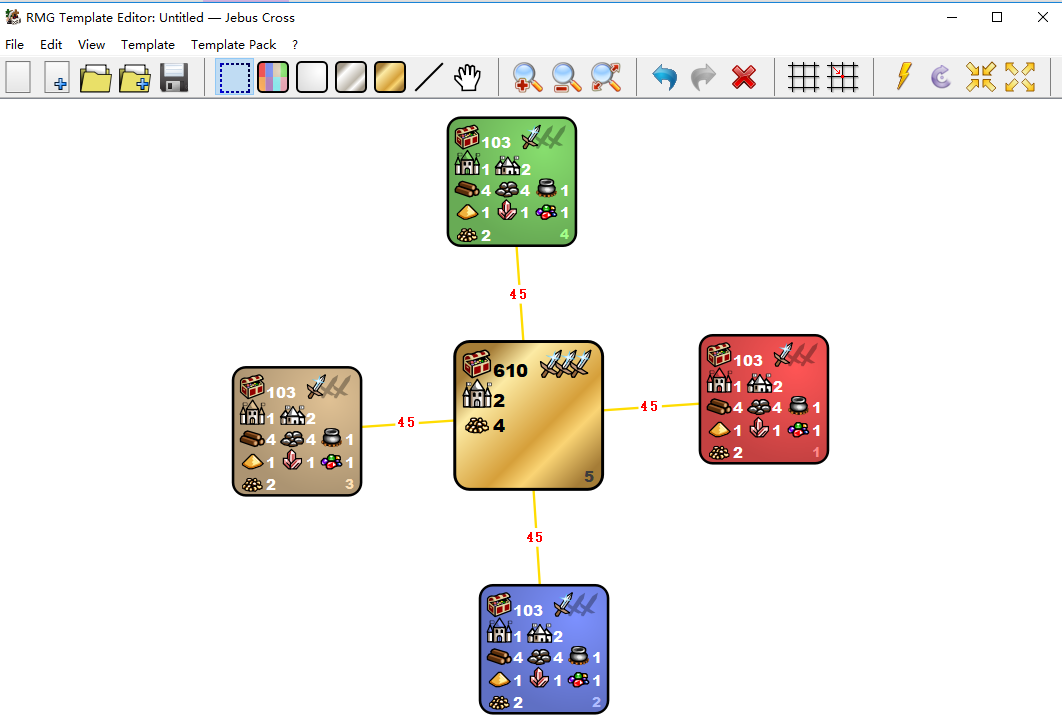 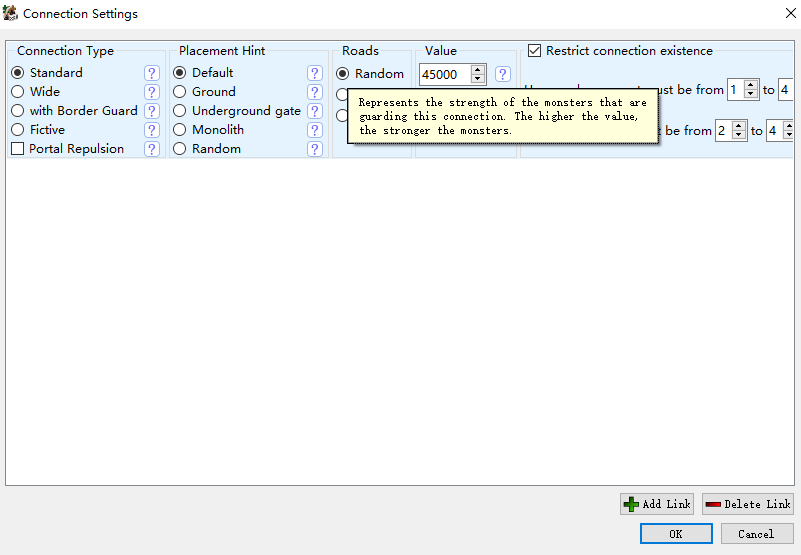 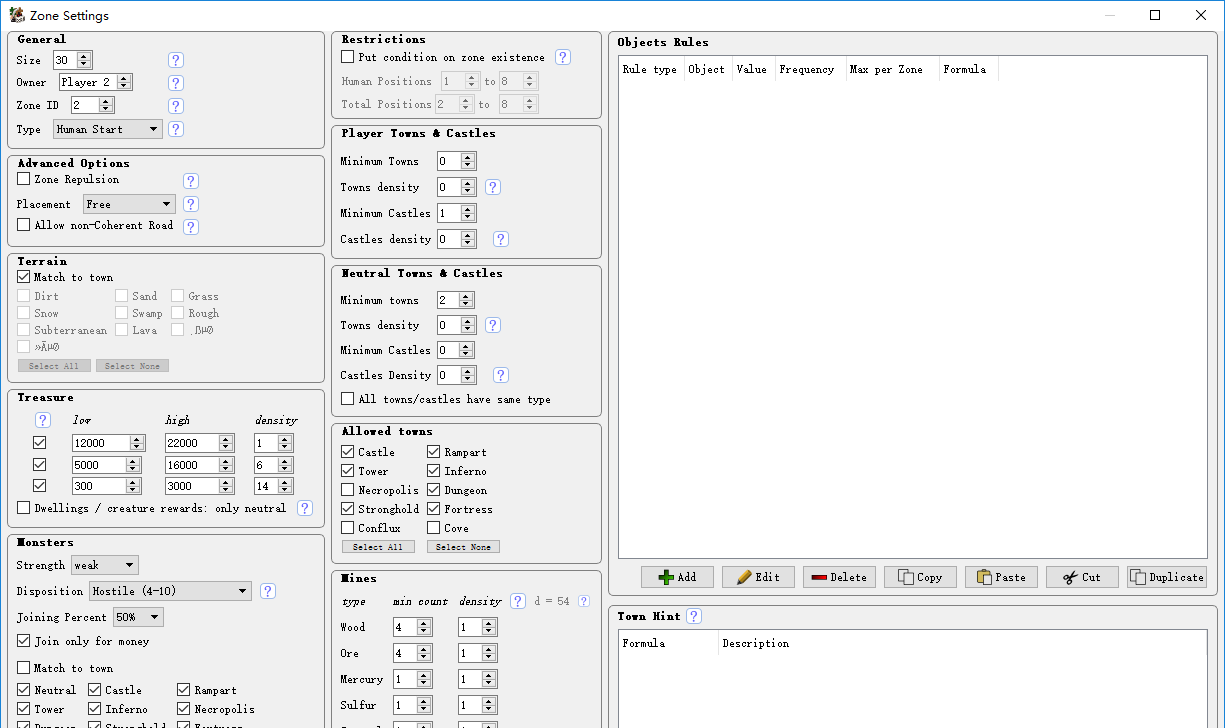 Random map templatesIntroduction Every random map is generated following a certain template. The template prescribes, how many zones should map be divided into, how these zones should be interconnected, and certain details regarding zones and connections as well, while majority of objects and precise location of zones is selected randomly. This article presents you description and layouts of default HotA templates. NotationZonesGeneralZones are denoted by squares with rounded corners. Square size shows the relative size of the zone with respect to other zones on the template (however, actual size of the zone depends on the variety of factors and may not correspond to the size displayed on the layout).  Zone color corresponds to a player whose starting town is located in this zone: this rule is held if only the first colors are selected by players (e.g., red and blue for two players), otherwise zone colors don’t correspond to players’ colors. 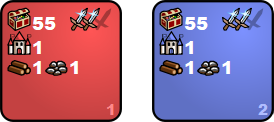 Zones not occupied by players are colored white (for content-poor zones), silver (for content-rich zones) or gold (for vastly content-rich zones).  There is a number located at the bottom right corner of the square, which is this zone’s ID. PC icon located alongside zone number signifies that the player starting in this zone is imperatively AI-controlled. 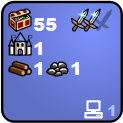 There is a number at the top left corner, near the chest icon, which denotes the richness of this zone’s contents. The bigger is this number, the more precious objects this zone will generate (and the heavier will be the guards). This number alone specifies, if the zone will be colored white, silver or gold. Each zone’s contents are characterized by three (or less) content types. Each of these types is described by three numbers: minimum group value, maximum group value and relative frequency of occurrence. From now on each content type will be denoted as ([minimum value]–[maximum value], [frequency]). The most frequently used content-wise zones are:
The asterisk above the richness number signifies that this zone uses custom rules for objects generation. 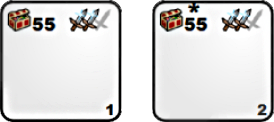 Swords icon(s) at the top right corner denote the guards’ relative power. Absence of swords means that the objects in this zone are not guarded at all. Otherwise, 1, 2 or 3 swords correspond to weak, medium or strong guards respectively.  There can be multiple towns in the zone. Town type (castles — with Fort; non-fortified, aka villages — without Fort) and amount is denoted by town icon(s) (castles — with windows; villages — without) and number(s) alongside them. Neutral and player-controlled towns are distinguished as well (neutral towns have grey tower tops, while player-controlled towns have tower tops of corresponding color). 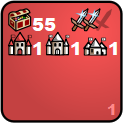 The amount of every type of mines is located alongside the corresponding resource icon. 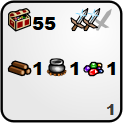 Basic connection between two zones is denoted by a single black line. The number on it is connection value, which specifies the power of units guarding it. Connection with a Border Guard is crossed by another shorter line in place of the number. 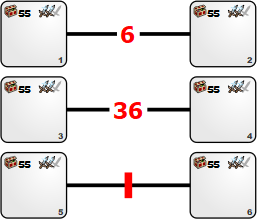 Wide connection is denoted by thick grey line. This connection is never guarded, and, if zones connected with it have a common land border, they will be connected for the majority of this border’s width.  Thin dashed line denotes fictive connection: the zones will not be actually connected, but despite this fact, the generator will try to place these zones close to each other, if possible.  If the connection has an obligatory road, thin white dashed line is added inside the connection line. Note that if several connections with obligatory roads occur between the same pair of zones, only one road will be generated.  Imperatively roadless connections are denoted by thick dashed lines.  Mirror templates have their underground layer generated as an exact copy of the surface level. On the template layouts surface zones are drawn at the left and the underground ones — to the right. Each surface zone #x has its underground copy as zone #100+x. Note that the right side of the layout is turned upside-down — if some zone is found on the top of the surface part, its copy will be at the bottom of underground part. Connections between two mirror layers are marked red. 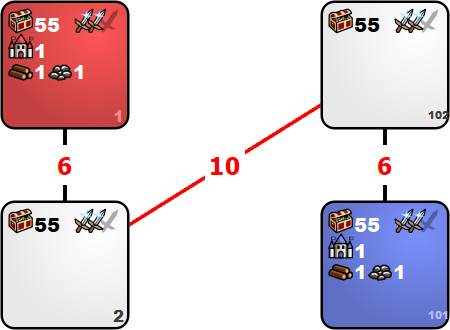 Some zones and/or connections on the template may have a yellow outline. It means that this zone or connection may or may not appear during generation, depending on the map settings selected before start (number of players, map size). This way several templates may be configured differently, depending on the number of players or on the map size.  If you want more detailed view on any of the templates, you may open it using built-in template editor. To do so you need to run Rmg Template Editor.exe in the root directory of HotA, press Open and select HotA_RMGTemplates[template name]\rmg.txt. Note that there are multiple view modes, that may be switched using buttons 1–5. 1 — standard view, described above. 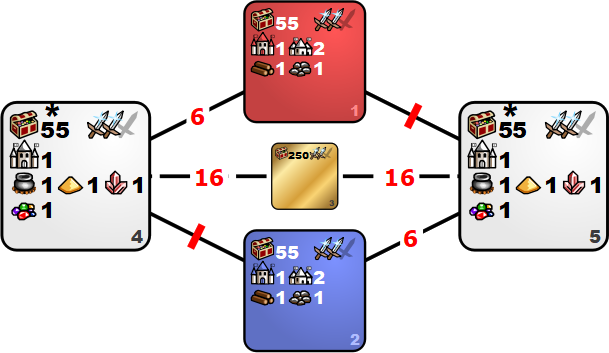 2 — towns and castles view. In this mode each zone displays all towns and castles total number, maximum allowed number of towns (if more than standard amount may be generated), allowed towns and castles alignment and notification if all the towns and castles in the zone must belong to the same alignment. 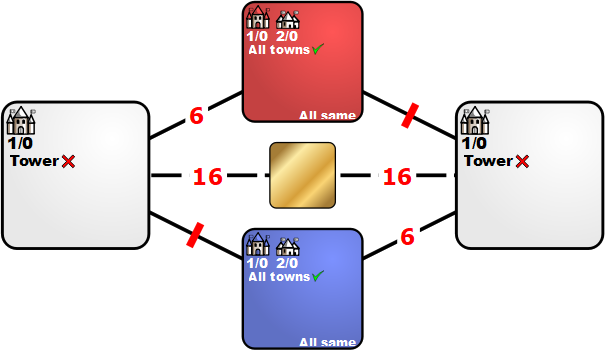 3 — treasure view. In this mode each zone displays detailed view of its contents: minimum/maximum value and frequency for up to 3 types of treasures. Asterisk, as in the Standard view, signifies the custom settings or restrictions of certain objects generation. 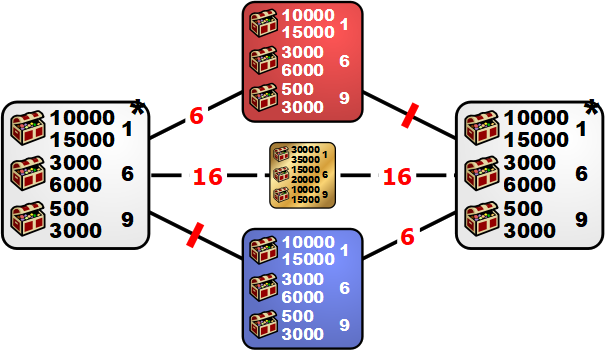 4 — terrain/placement view. In this mode each zone displays allowed terrain types, as well as placement options, like forced underground/surface level or zone repulsion. 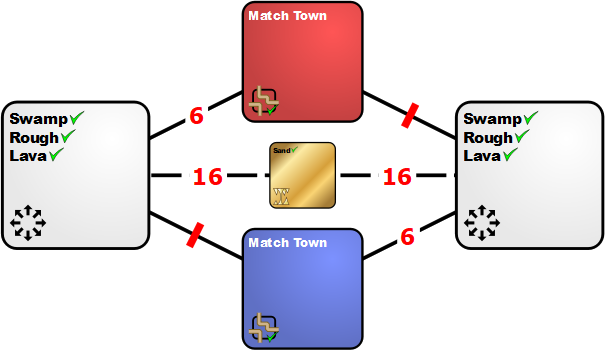 5 — IDs view. In this mode each zone’s ID is displayed in large scale.  Double-clicking any zone or connection allows you to edit it. General settings can be viewed in the following tabs: Template pack -> Settings and Template pack -> Settings. Protection from modificationsHost player templates are used to generate map during multiplayer session. Therefore joining players must have means to ensure the template doesn’t contain any unknown modifications. At the beginning of new map generation all players have their templates compared between each other and with the reference template on HotA server. If no message appears after the check is performed, it means that host uses the template that is either to your corresponding template or corresponding reference template. Assuming that joining player has default template, it means that the host has also used the default template for map generation, and the players are free to proceed. Otherwise the user is shown a message describing inconsistency type and possible solutions to this issue. Original template packThis template pack is also known as Default template. It is a template pack that consists of multiple different templates suitable for various map configurations in terms of size and amount of players. Before generation starts, if this pack is used, one template is randomly selected from all the templates corresponding to the selected configuration. Although extensive, this template pack is believed to be not quite optimized for multiplayer sessions. Mirror templatesh3dm1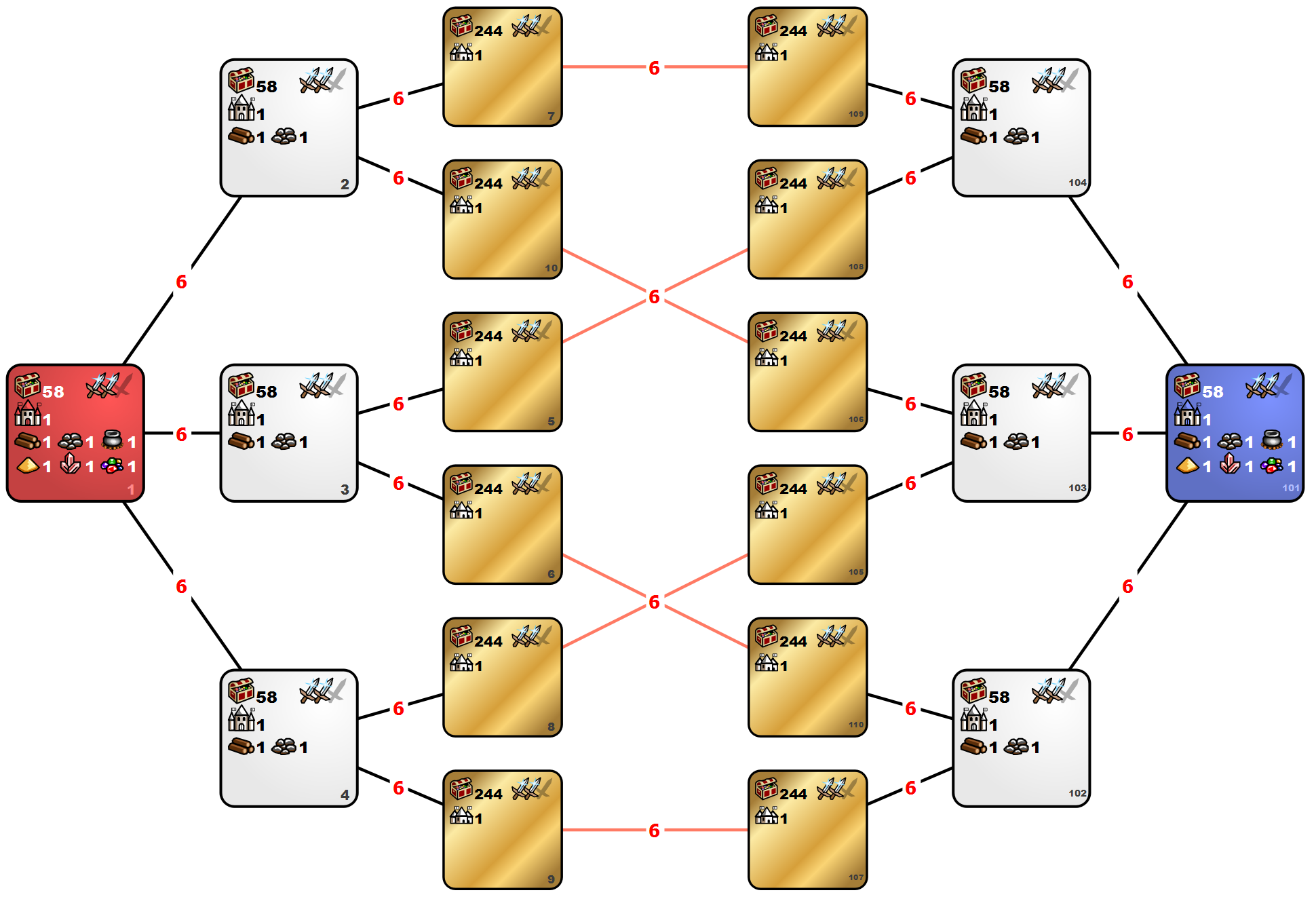
Specifications:
Suggested rules and settings: mt_Diamond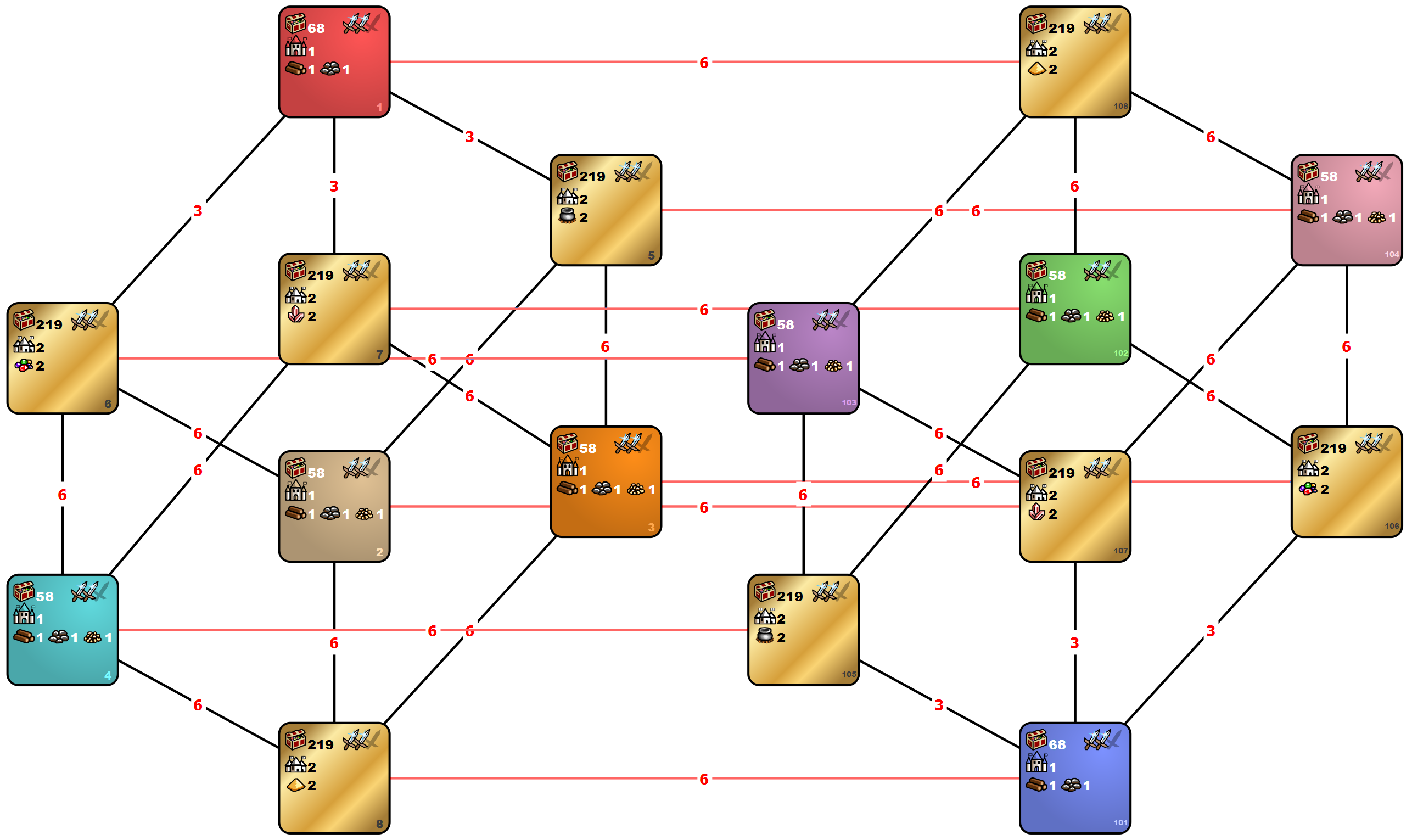
Specifications:
Suggested rules and settings: mt_Jebus
Specifications:
Suggested rules and settings: mt_TeamJebus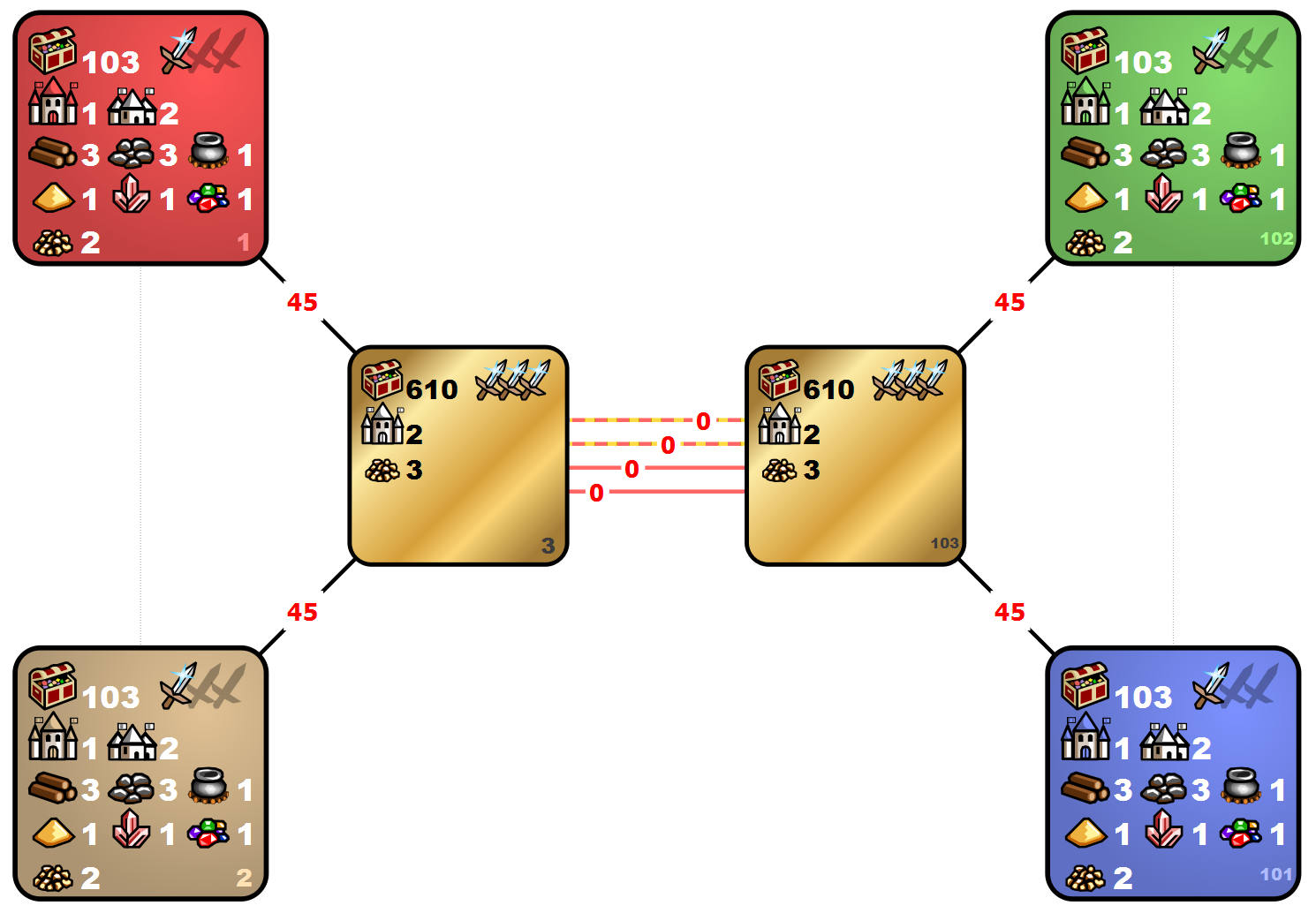
Specifications:
Suggested rules and settings: mt_Andromeda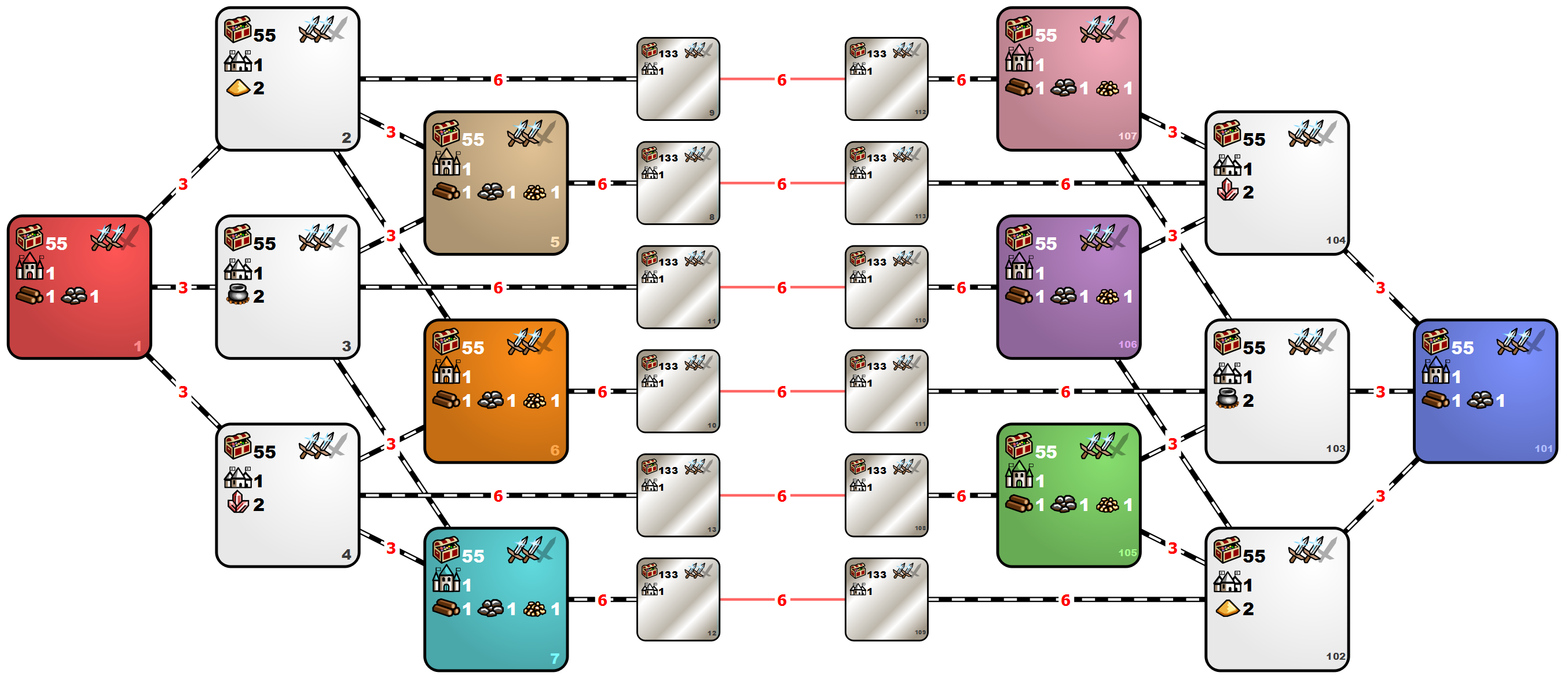
Specifications:
Suggested rules and settings: mt_Antares
Specifications:
Suggested rules and settings: mt_Firewalk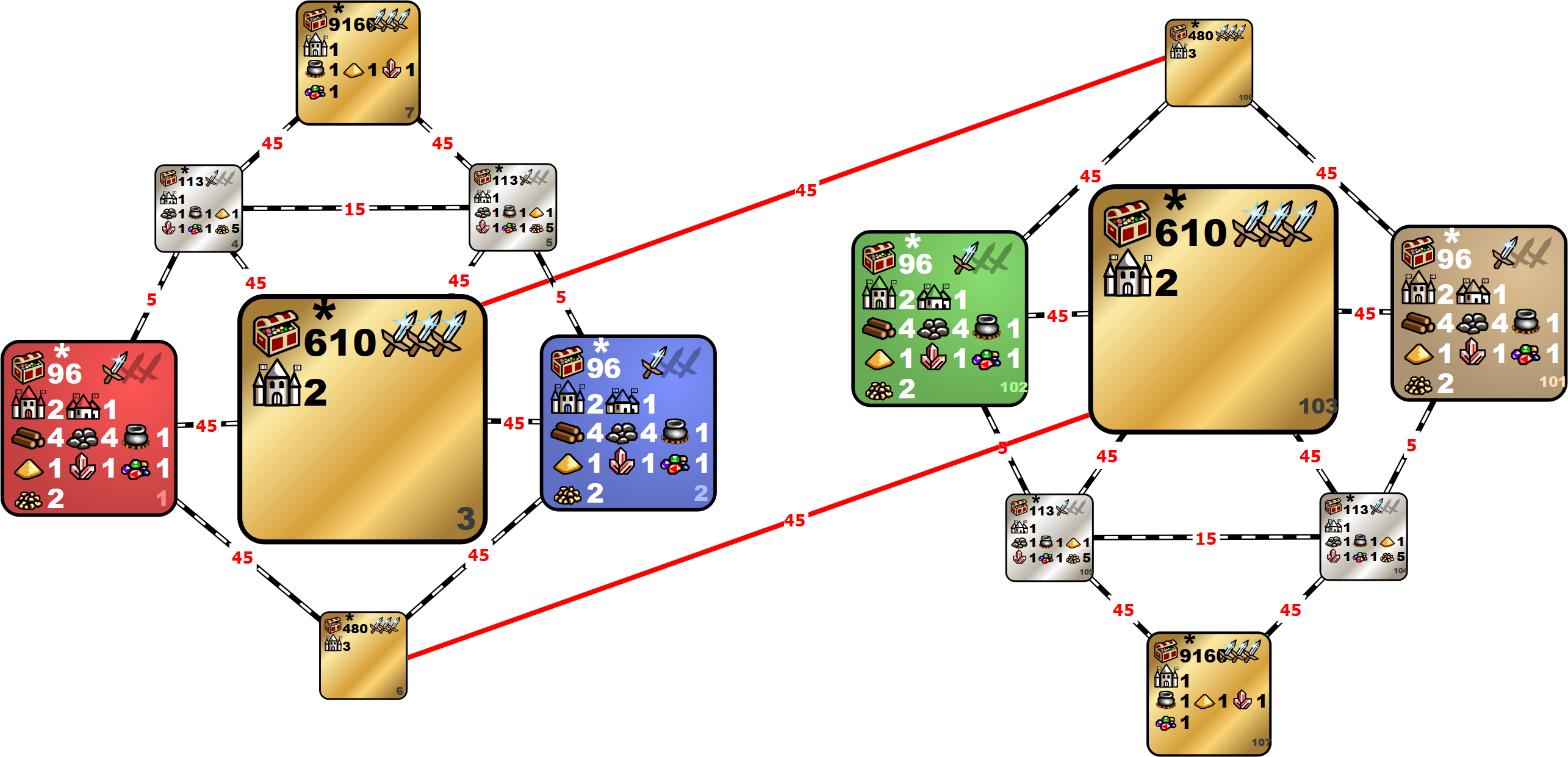
General specifications:
Suggested rules and settings: Custom object generation rules: Zones 1, 101 and 2, 102. Player and AI zones. unfold Zones 3 and 103. Big sand zones. unfold Zones 4, 104 and 5, 105. White zones, dirt. unfold Zones 6 and 106. Army bank zones, lava. unfold Zones 7 and 107. Dragon utopias zones, sand. unfold XL+U templates6lm10a 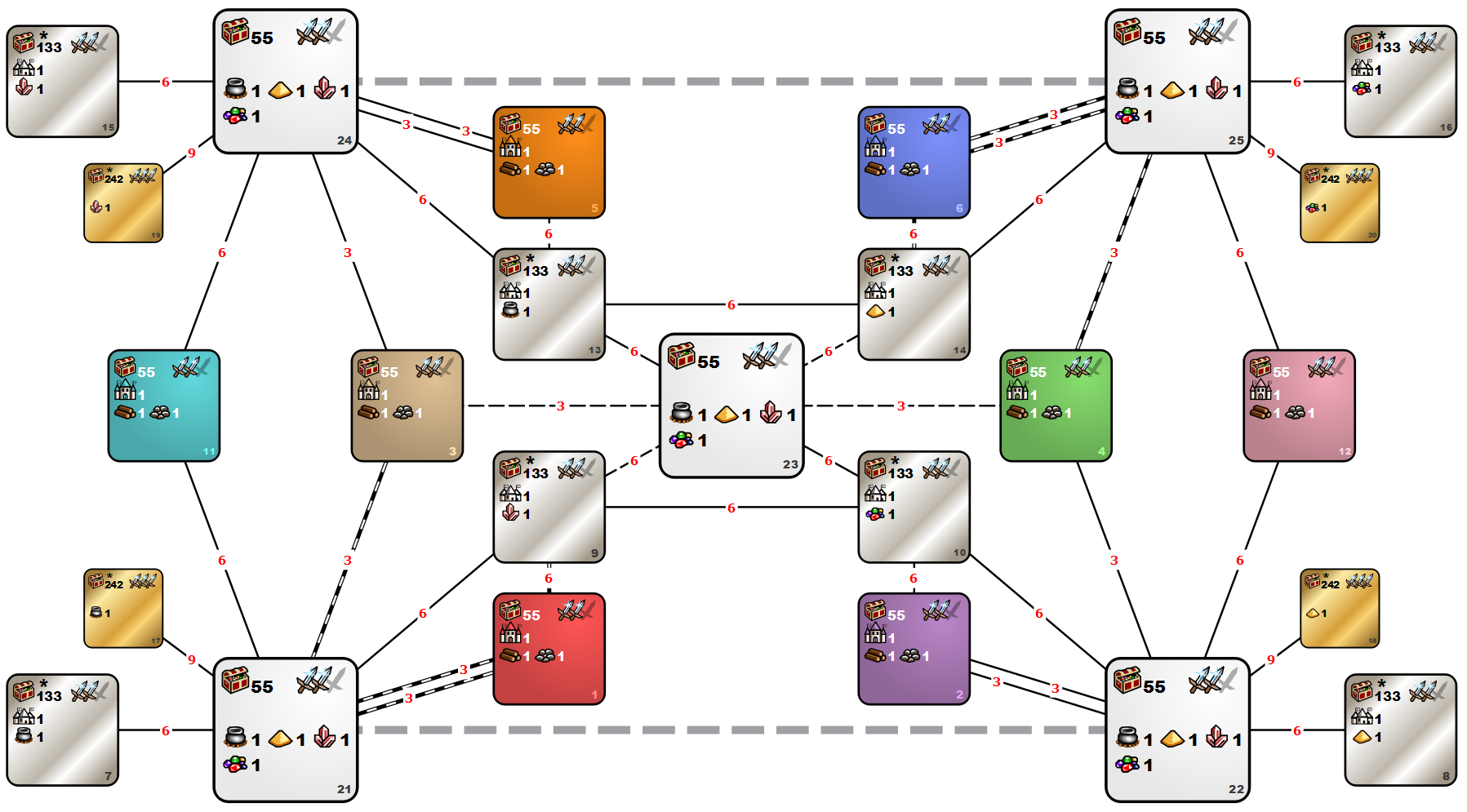
Specifications:
Other differences from SoD version:
Suggested rules and settings: 8mm6a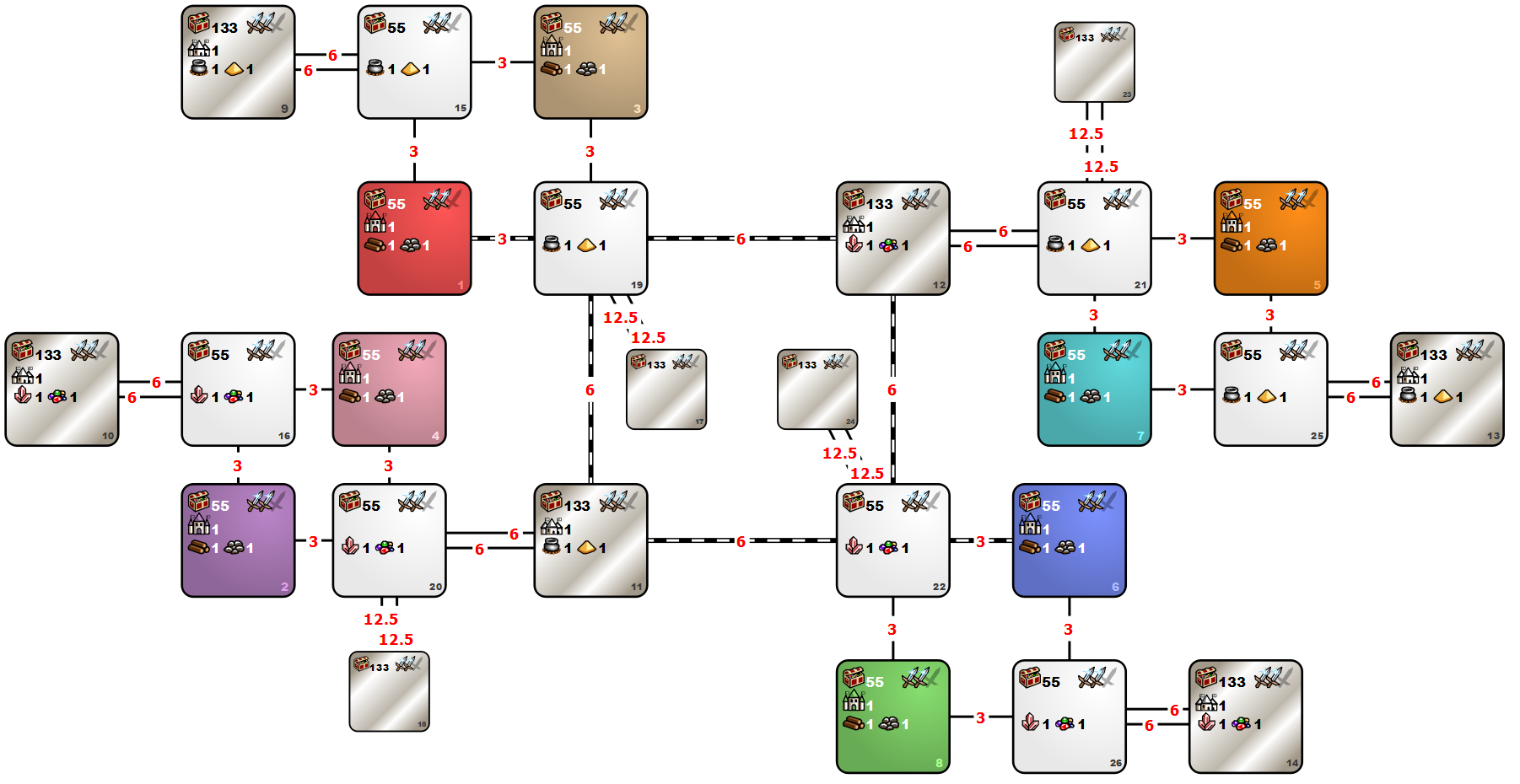
Specifications:
Differences from SoD version:
Suggested rules and settings: 8xm12a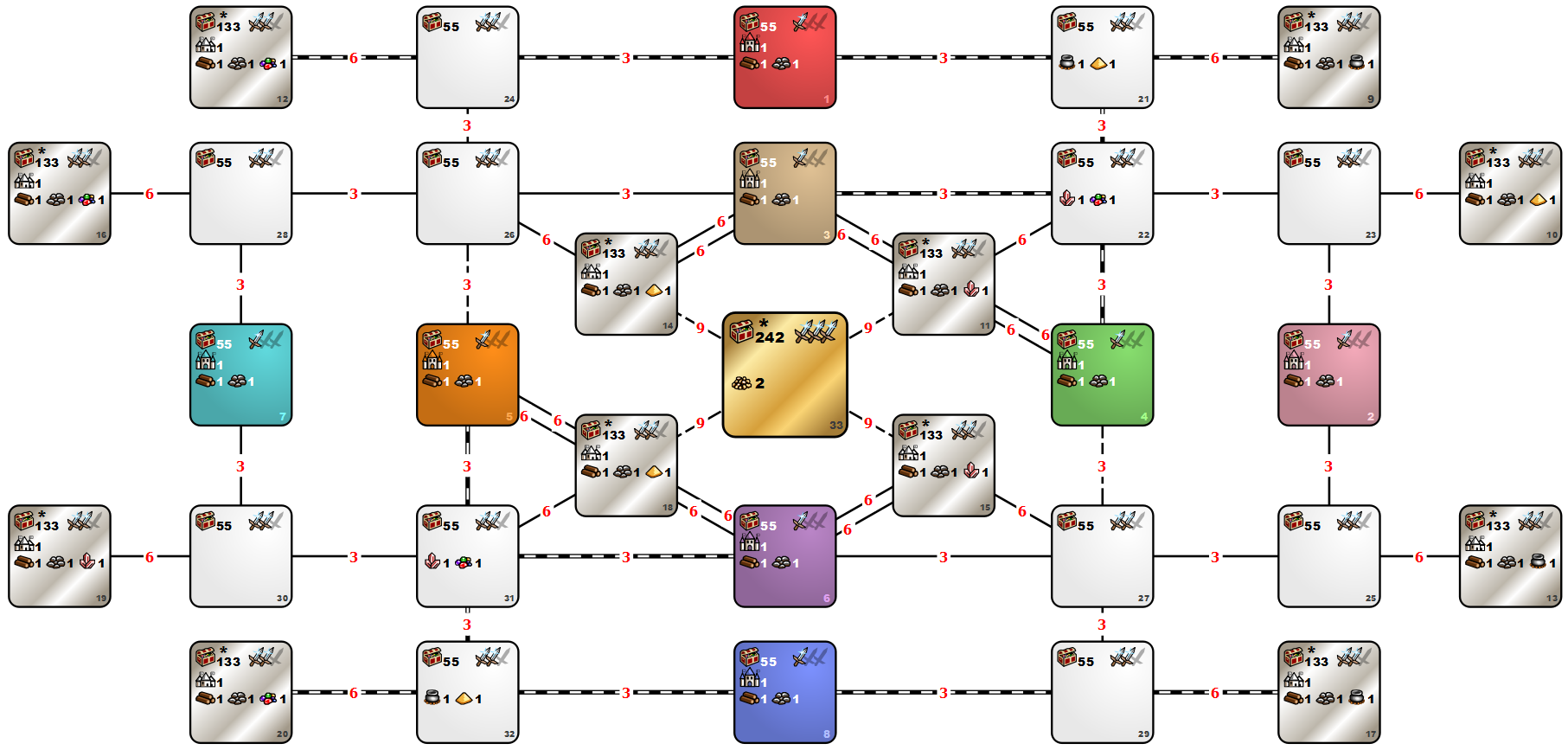
Specifications:
Other differences from SoD version:
Suggested rules and settings: Spider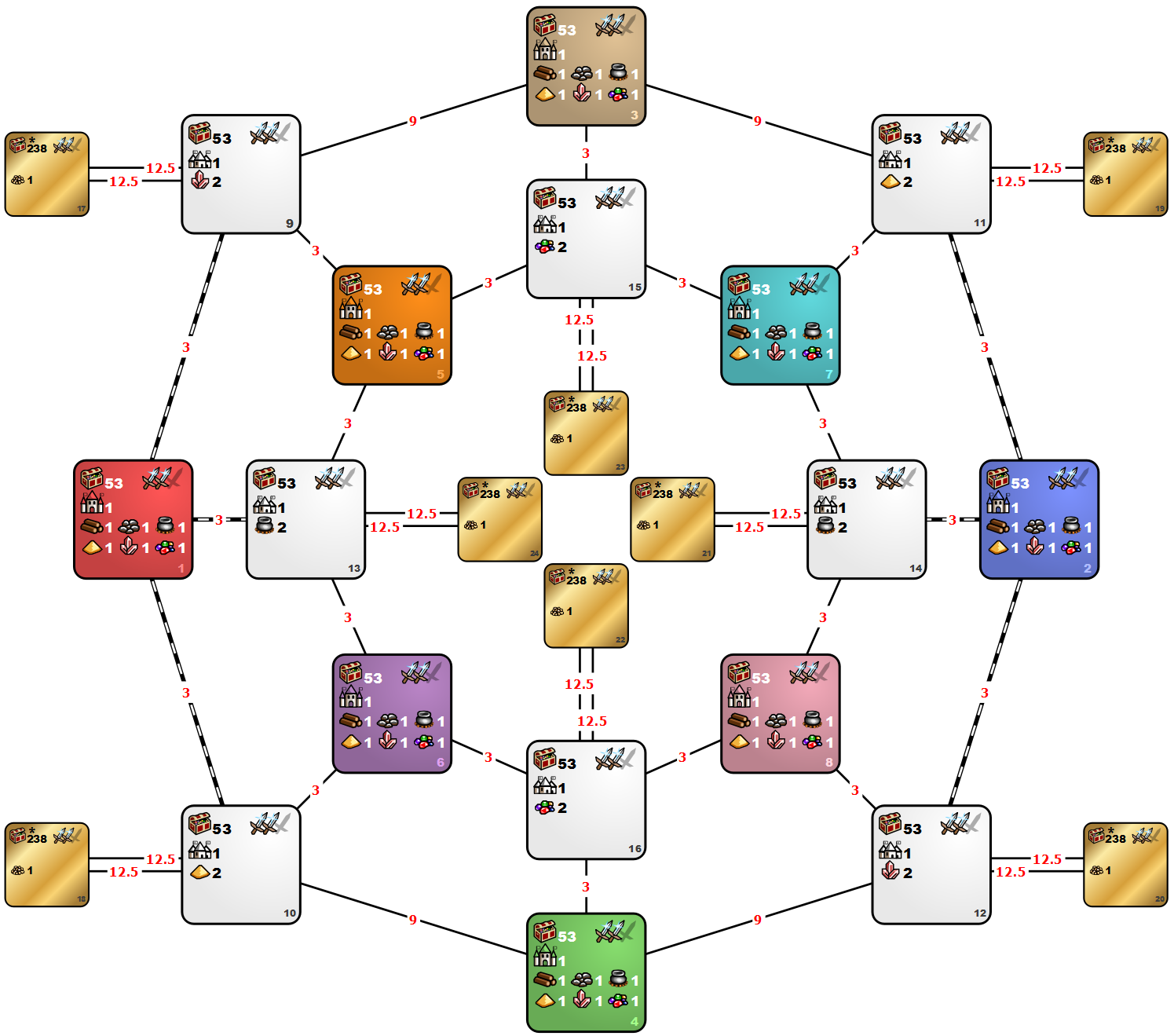
Specifications:
Other differences from SoD version:
Suggested rules and settings: Nostalgia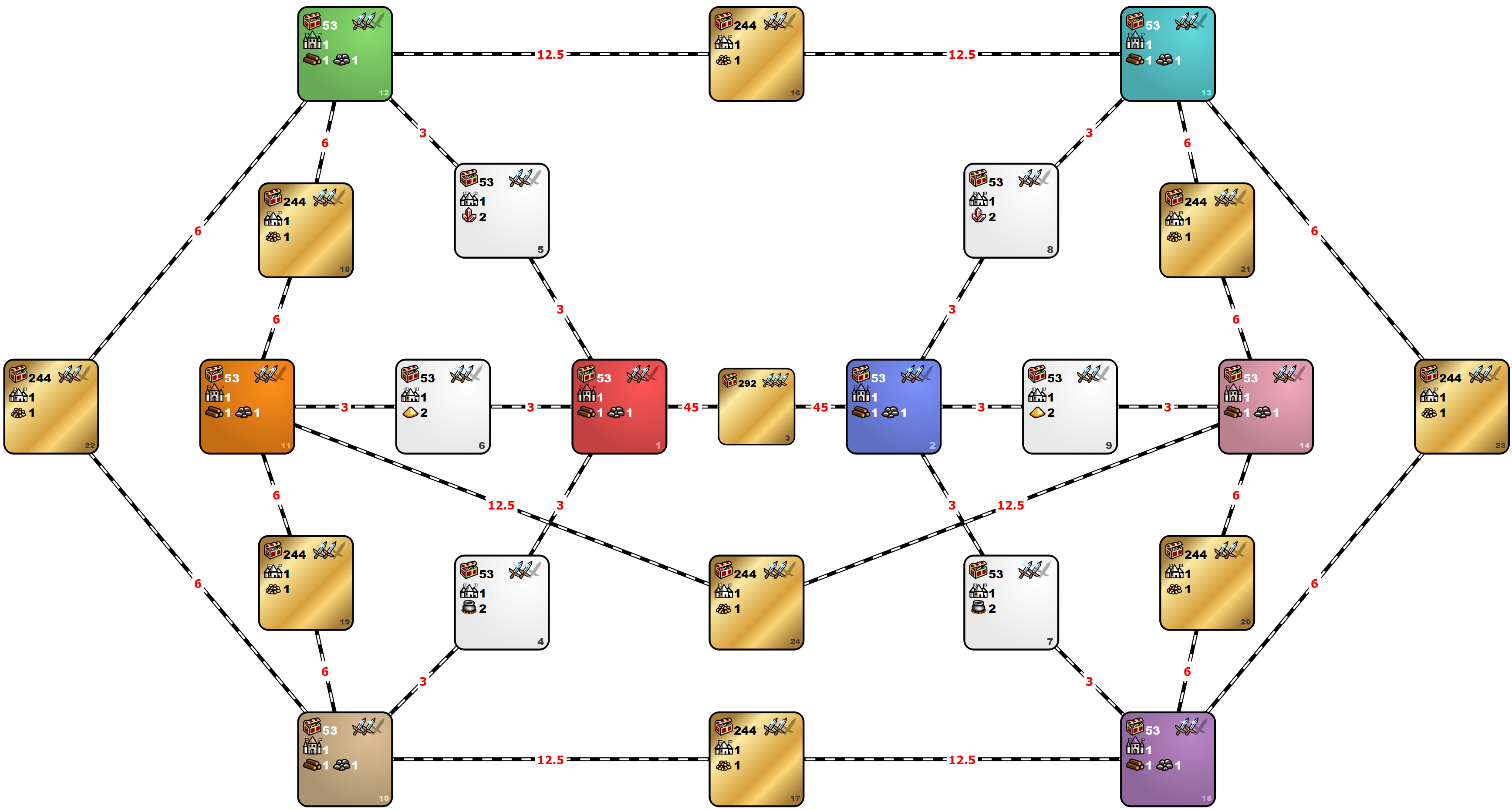
Specifications:
Other differences from SoD version:
Suggested rules and settings: Kerberos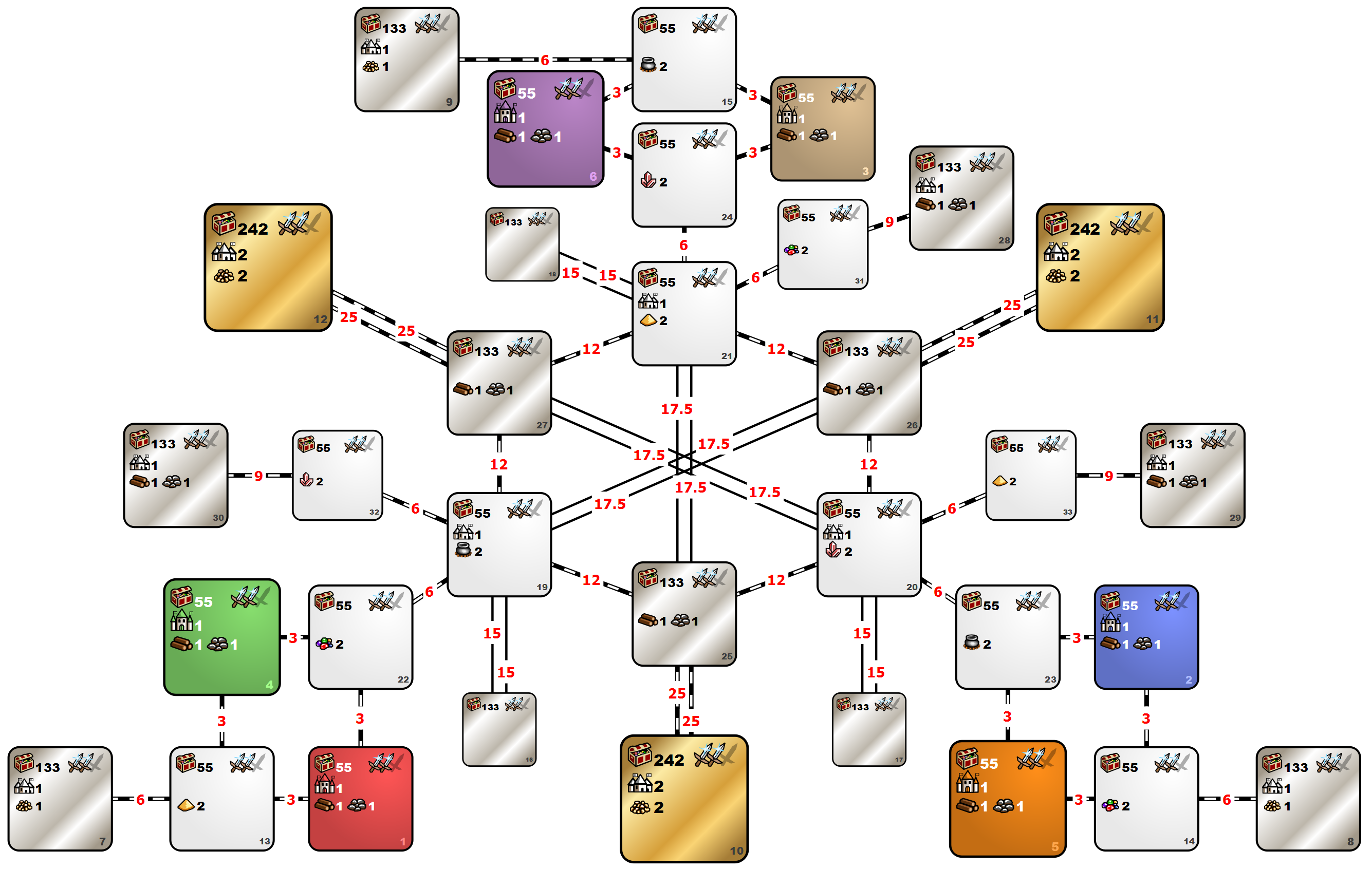
Specifications:
Suggested rules and settings: Clash of Dragons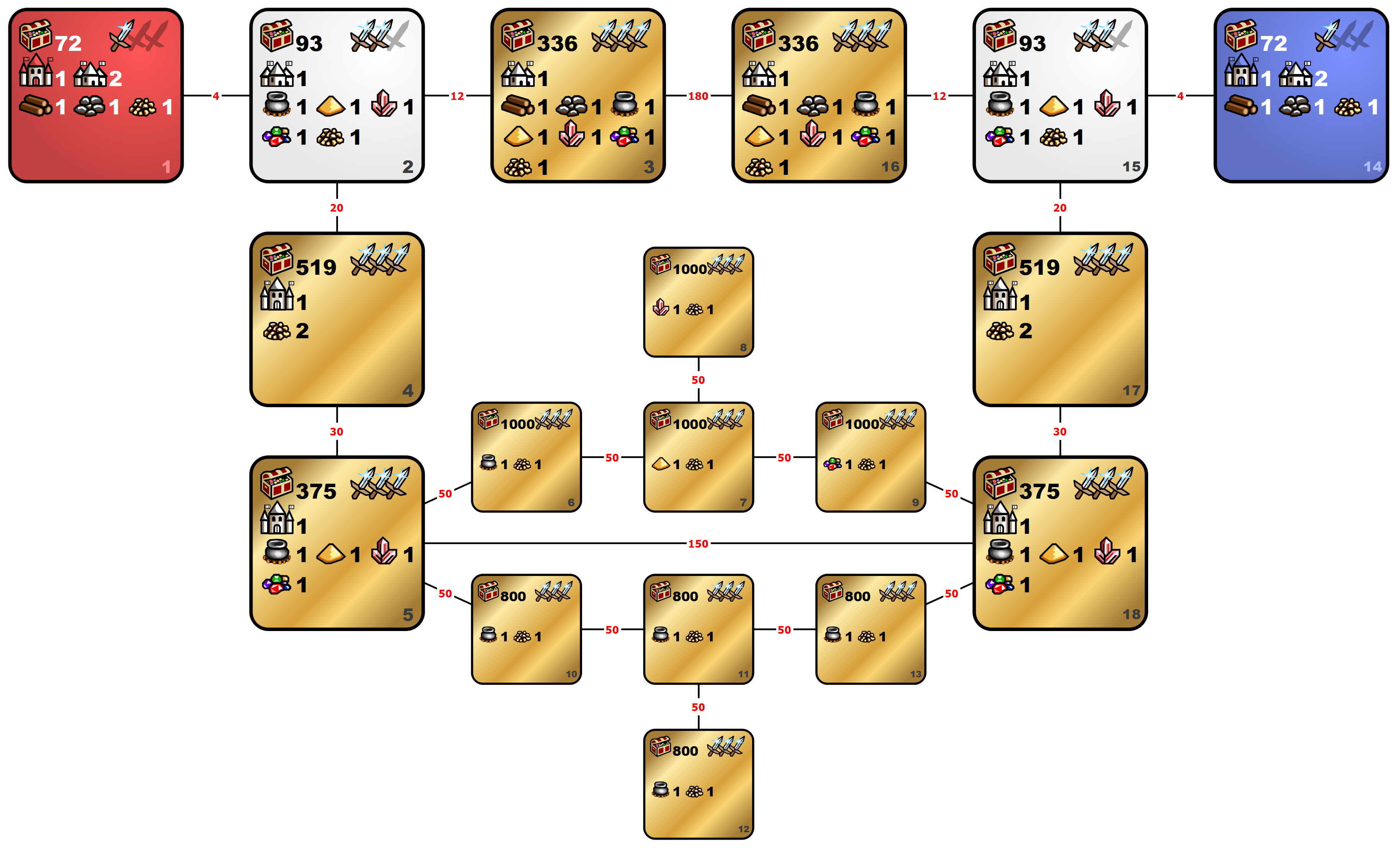
Specifications:
Other differences from SoD version:
Suggested rules and settings:
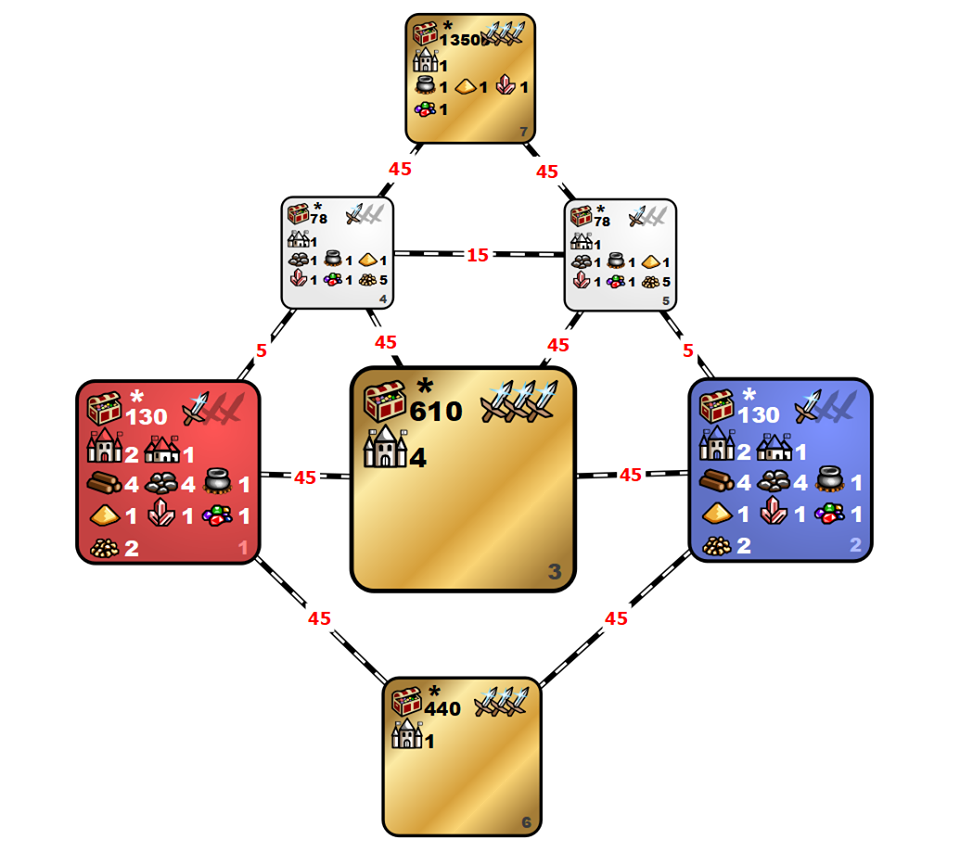
General specifications:
Suggested rules and settings: Custom object generation rules: Zones 1 and 2. Player zones. unfold Zone 3. Big sand zone. unfold Zones 4 and 5. White zones, dirt. unfold Zone 6. Army zone, lava. unfold Zone 7. Dragon utopias zone, sand. unfold XL-U templatesJebus Cross 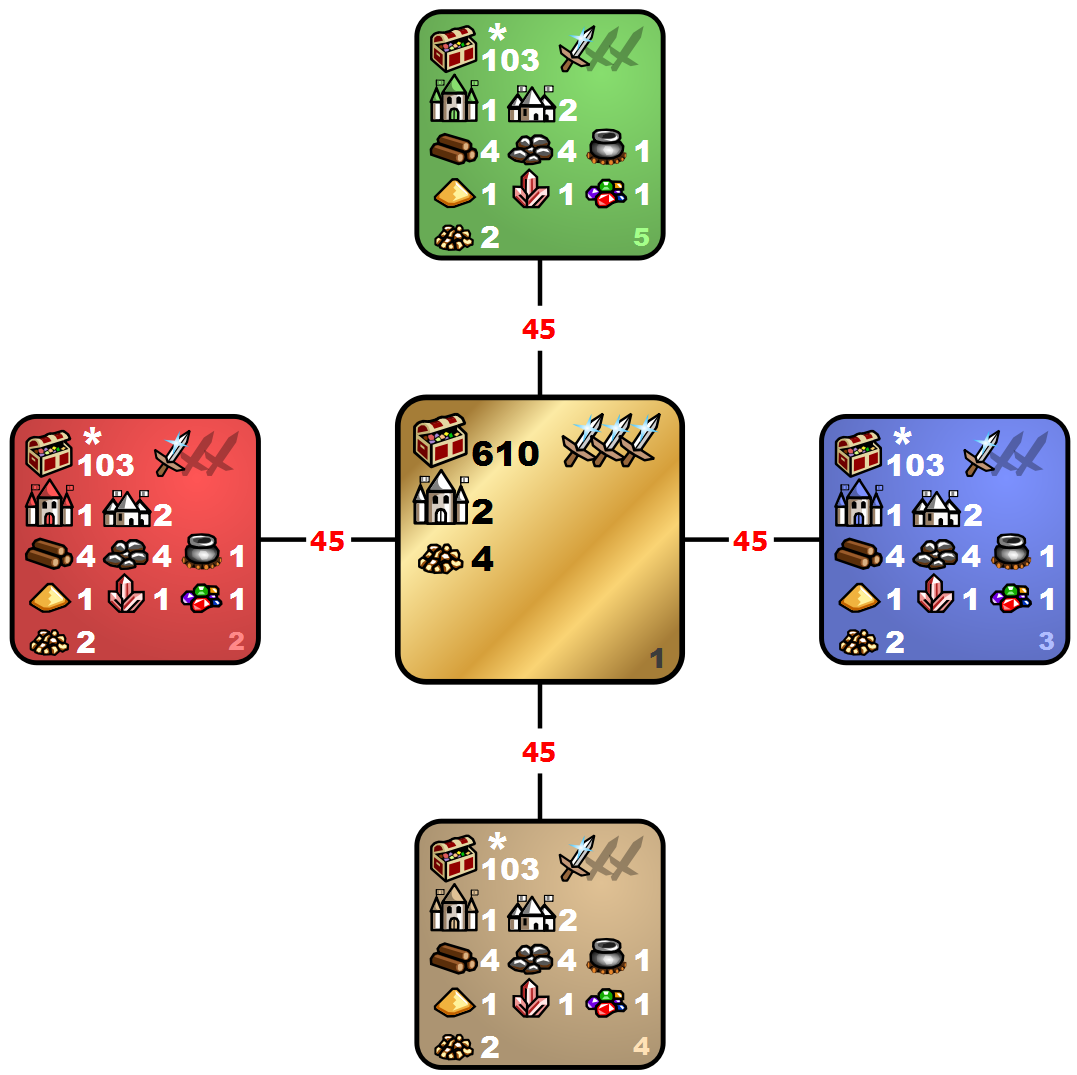
Specifications:
Other differences from SoD version:
Suggested rules and settings: L+U templates2sm4d(3)
Specifications:
Differences from SoD version:
Suggested rules and settings: Mini-Nostalgia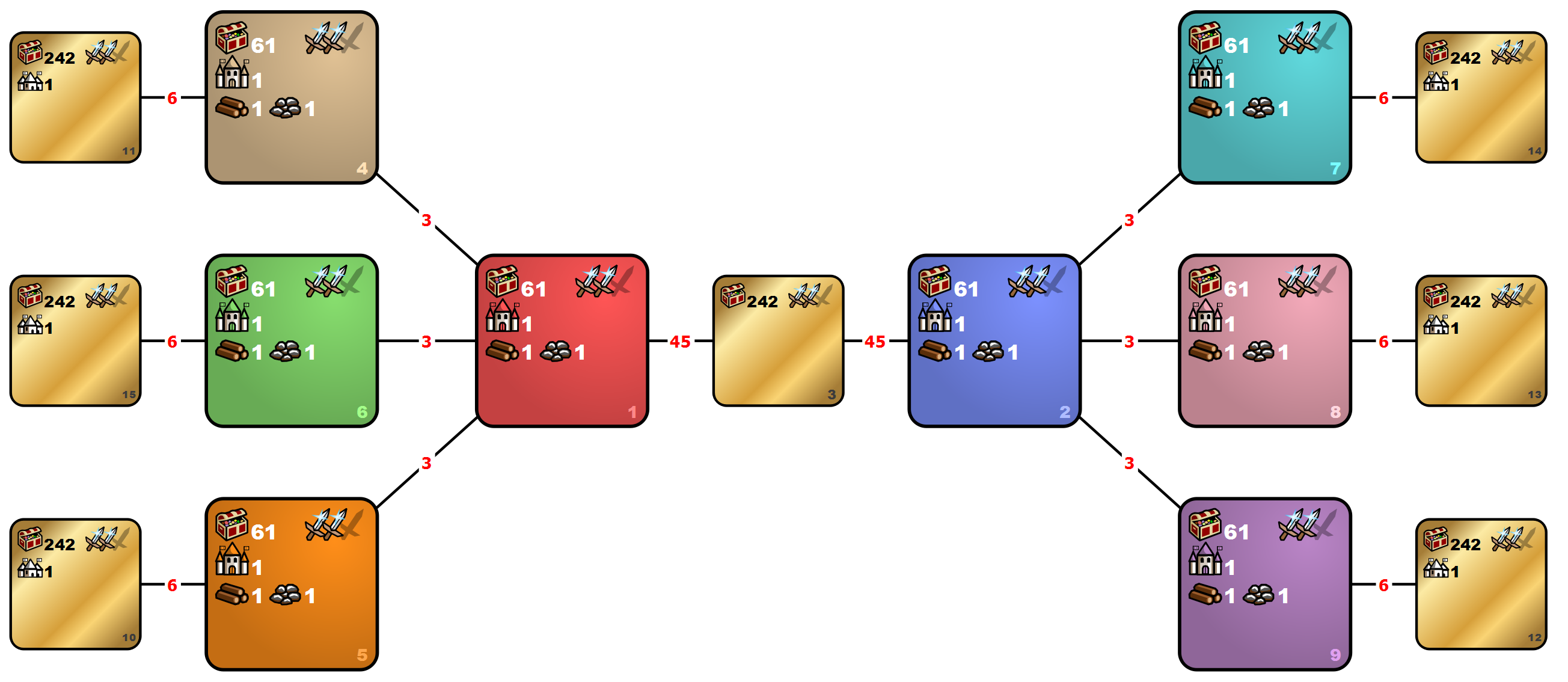
Specifications:
Differences from SoD version:
Suggested rules and settings: Diamond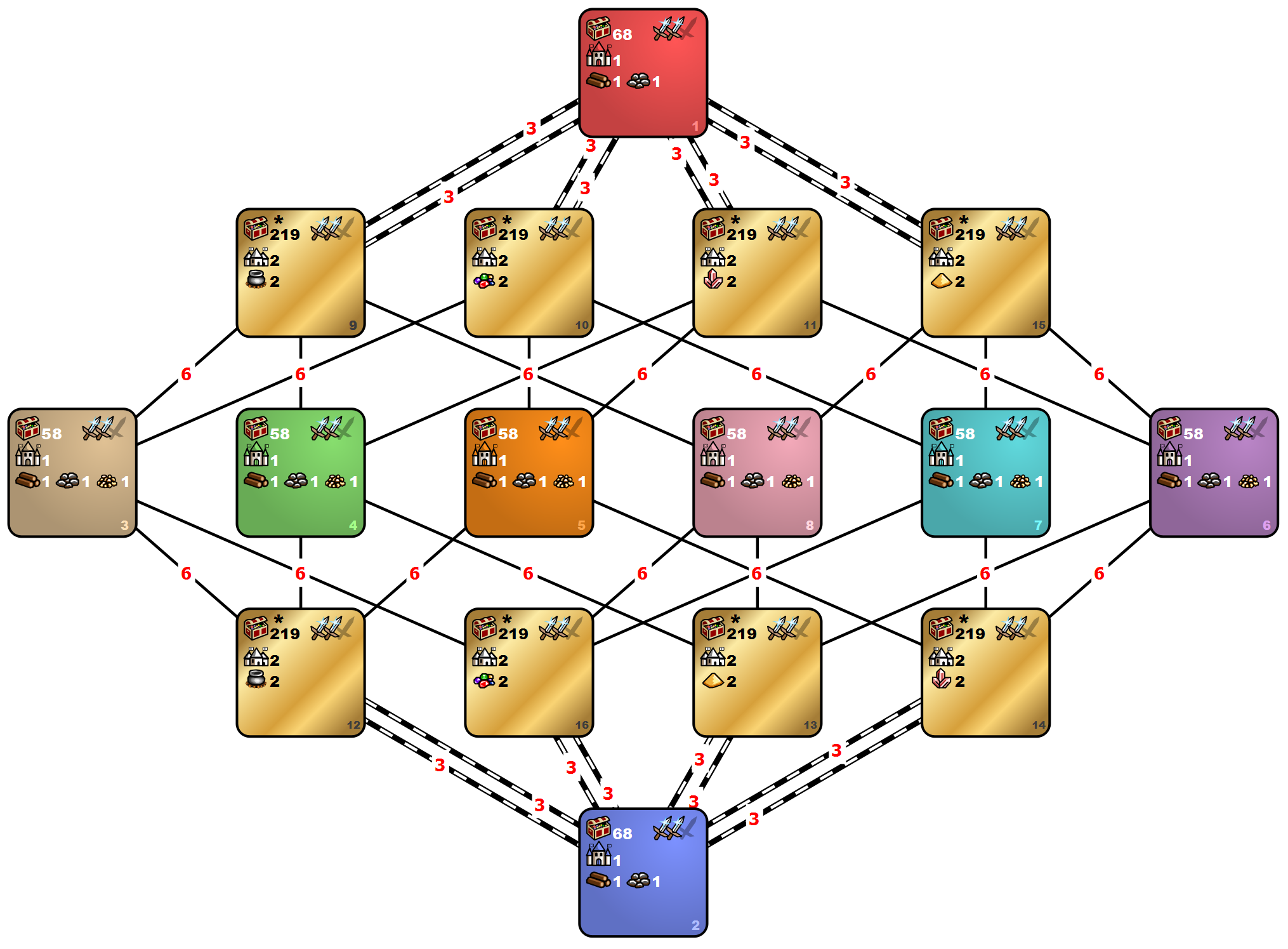
Specifications:
Other differences from SoD version:
Suggested rules and settings: Boomerang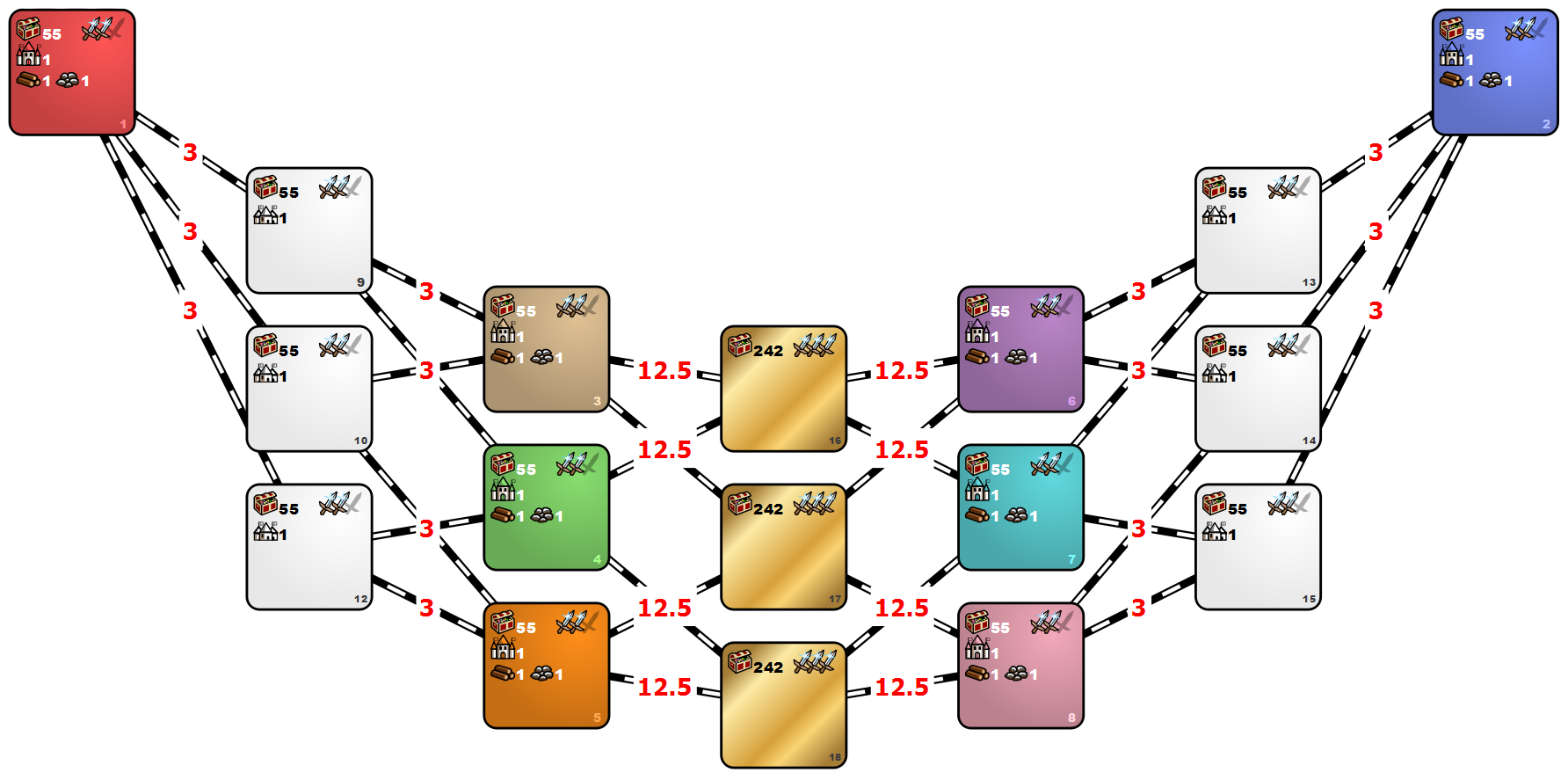
Specifications:
Suggested rules and settings: Apocalypse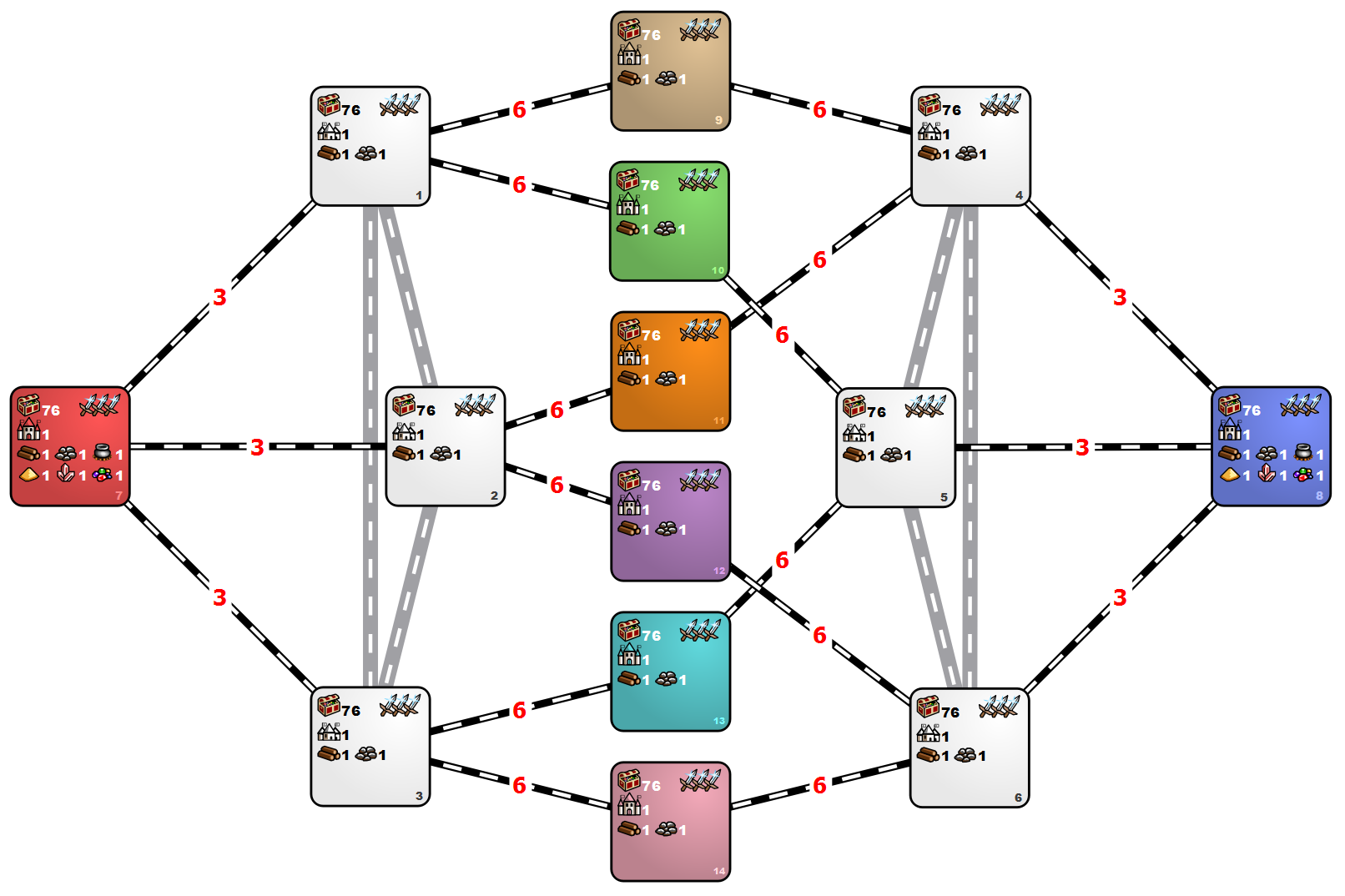
Specifications:
Suggested rules and settings: Anarchy
General specifications:
Differences from SoD version:
Suggested rules and settings: Particular templates layouts and specifications: unfoldBlack’n’Blue 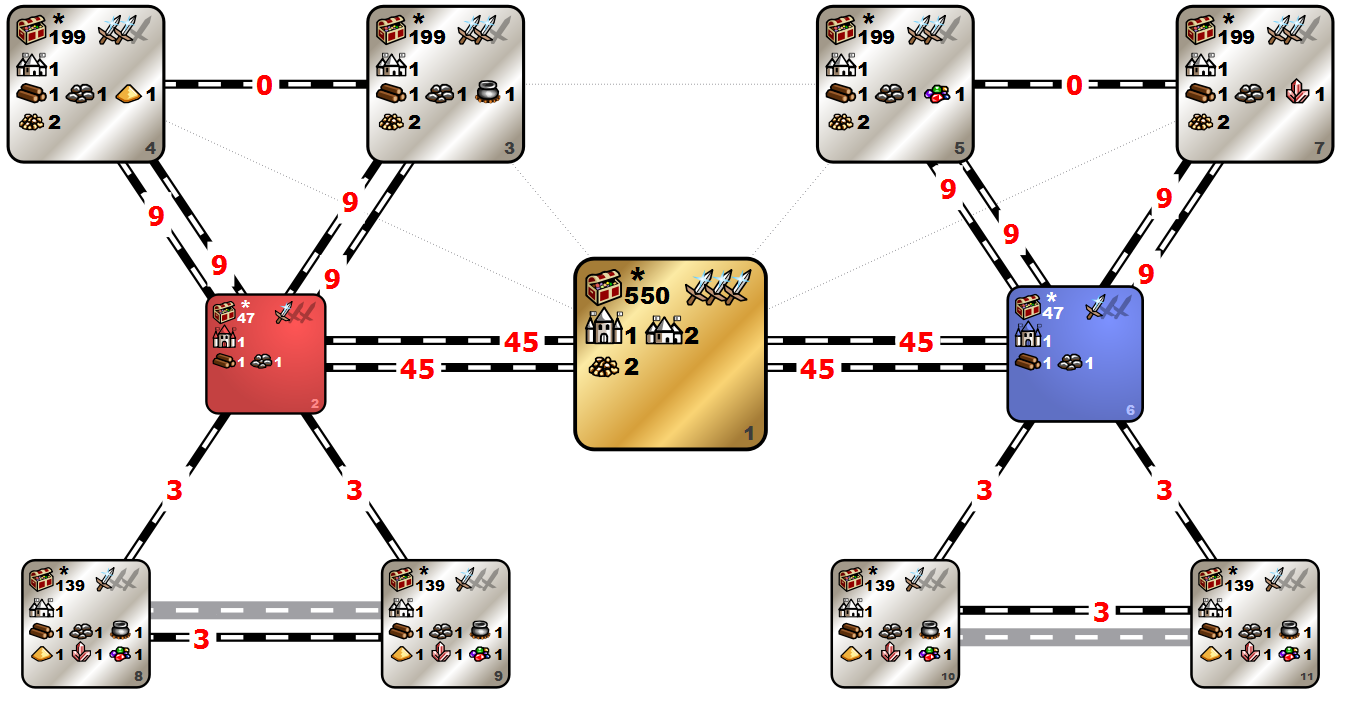
General specifications:
Suggested rules and settings: Custom object generation rules: As a general rule: all objects are banned. Allowed objects are set separately for each zone.
Zone 1. Central treasure zone, sand. unfold Zones 2 and 6. Starting zones for red and blue players. unfold Zones 3, 4, 5 and 7. Medium treasure zones, snow. unfold Zones 8, 9, 10 and 11. Lesser treasure zones, underground. unfold M200 templates2sm2c(2) 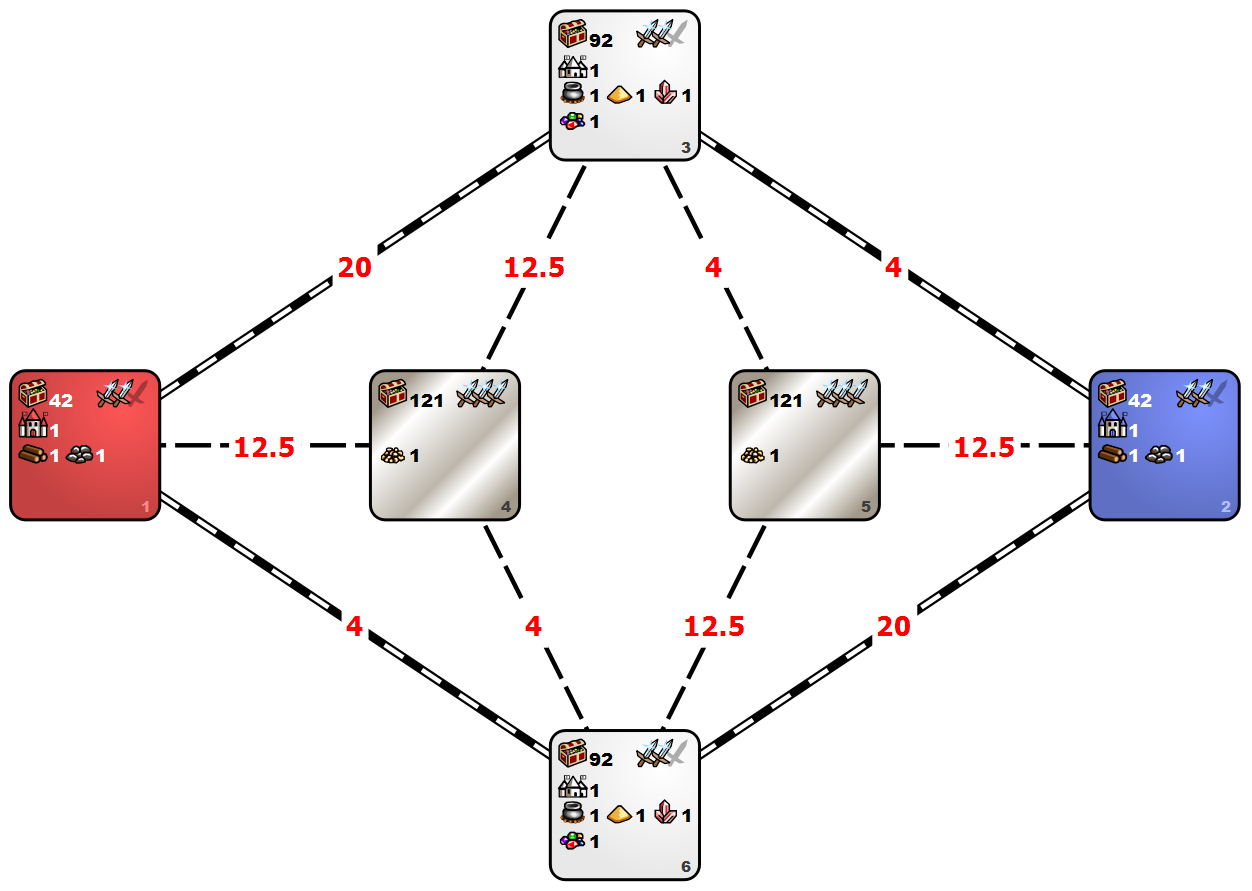
Specifications:
Suggested rules and settings: Skirmish(M)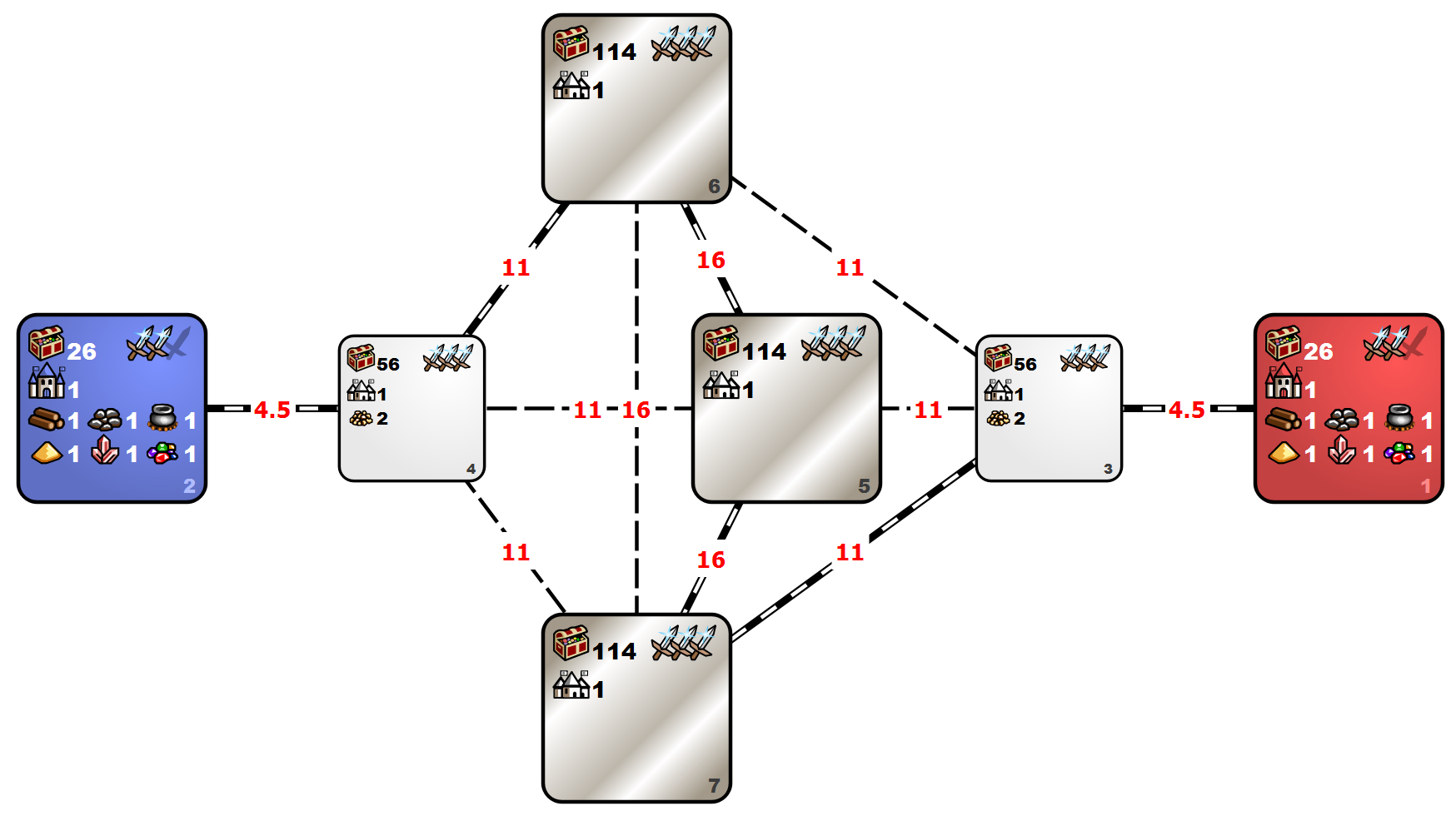
Specifications:
Suggested rules and settings: Nine-day Wonder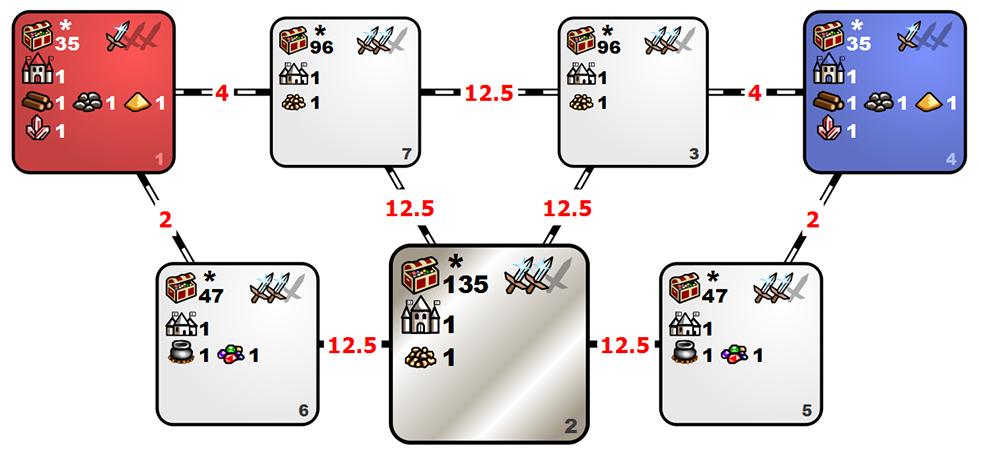
General specifications:
Suggested rules and settings: Custom object generation rules:
General template rules: fold Banned: Quest artifact for Seer Hut of any kind (therefore Seer Hut itself) Obelisk Trading Post Experimental Shop Tree of Knowledge Freelancer’s Guild Lean To Temple of Loyalty Allowed with custom map limits: Maximum per map — 4: Cyclops Stockpile Allowed with custom zone limits: Maximum per zone — 1: Shrines of all levels, School of War, Prisons — 0, 5000 and 15000 XP heroes. Allowed with custom value/frequency/limits: Imp Cache, value: 750, frequency: 30, maximum per zone: 2 Univers |
发表评论
最新评论
- 引用 13872408990
- 没有文化真可怕 一句没看懂
- 引用 songfx
- 模板介绍(看不懂的可以看下一楼的机翻中文)IntroductionRandom maps are not fully random. Behind every random map, there is a template that describes the structure and the main features of the map.Horn of the Abyss expansion offers both:
- An editor to create custom templates;
- An extension to the original template format, allowing for deeper customization of random maps;
- Various bugfixes of the original random map generator (RMG).
Templates are packed in text files called “template packs”. A pack can contain one or more templates. To create a random map, the random map generator takes a template pack as input. When you press “Begin” to start a game, RMG randomly picks from the pack a template that matches the game settings (map size, number of players, etc). Then the random map is generated based on this particular template.RMG template editor only creates template packs. But most of the time, for custom templates, a pack contains only a single template. So the notions of template pack and template are often mixed (including in game interface), and “template packs” are simply called “templates”. In this article, both concepts will be clearly separated.Disclaimer: water mapsDespite the fact that water objects are supported by RMG, and despite the fact this article frequently describes how certain options work with water maps, it should be kept in mind that the mechanism of water generation on random maps is imperfect and usually creates non-playable maps. At the moment, it is hardly possible to create a worth-playing template for water maps.Template pack settingsIn addition to template pack name and description, this section contains some settings that may restrict the choice of starting options that is performed by player before the template is chosen from template pack.NameThe name is the identifier of the templates pack, just like non-random maps have their own name. It is displayed in the description of the generated map, along with the name of the particular template selected for this map. However, in the future, the name of the template pack may be used more extensively in the template selection menu (unlike the name of the template, which is only needed to show which template was selected from the pack). If the template pack is added to the HoMM 3 HD selection list, it is recommended that the template pack name matches the template folder name. Currently, only the template folder name is displayed in the selection list in HD. If the template pack contains only one template, it is recommended that both the template and the pack have the same name.DescriptionThe template description is intended to play the same role as the map description does for non random maps. If it is non-empty, it is displayed in game on the place of the map description.Allowed TownsThis setting allows you to restrict the towns that can be selected at the start of the game, before generating the map. It applies equally to all players.Note that it only restricts the starting towns that can be selected. All towns can still appear on the map, and all towns remain available as starting towns if the player selects “Random”. To completely ban a town from the template pack, you need to ban it from all zones of all templates of the pack.It is recommended to synchronize the list of banned towns of the pack with the list of banned towns of every starting zone of every template.If all towns are banned, the Castle will automatically be allowed.HeroesThis setting controls which heroes can:- Be selected (randomly or not) at the start of the game;
- Appear in taverns or prisons.
By default, the following are banned:- Campaign Heroes: Adrienne, Catherine, Dracon, Gelu, Kilgore, Haart Lich, Mutare, Roland, Mutare Drake, Boragus, Xeron, Bidley and Tark;
- Galthran and Sir Mullich;
- Thorgrim;
- Sylvia, Voy and Elmore if a random map is generated with “Water content: No”;
- Beatrice, Kinkeria and Derek if a random map is generated “Water content: Normal” or “Water content: Islands”.
Any hero can be allowed or banned. Template pack settings always take precedence over default settings (regardless what the “water content” is). However, the choice of the starting hero will always be limited to a list of 16. If the heroes count is higher for a town, only the first 16 will be available for manual selection. The others will still available through random selection, though.You can ban any number of heroes, but if the total heroes count is not greater than 10 * (number of players) + 48 heroes, no Prisons will be generated. And if the total count is smaller, there may be a situation where you can hire only one hero from the Tavern, or where you just cannot hire any. If all heroes of a certain class are banned, heroes from other classes will be generated instead.If the hero Gem is allowed, her starting spell will be either “Summon Boat”, if water content is “Normal” or “Islands”, or “Bless”, if water content is “No”.In case Interference secondary skill is disabled and Resistance secondary skill is enabled all heroes with starting Interference (except ones with Interference speciality) will have Interference replaced by Resistance.Max Battle RoundsIf the option is turned on, any battle involving a player and lasting more rounds than the limit setup will be forcibly terminated. The attacking player will be invited to retreat, surrender, or end with quick combat. The availability of retreat and surrender depends on whether they were available in the first place (except Shackles of War are now ignored). Quick combat is only available in a battle against AI. During finishing with the quick combat a hero of the human player does not cast spells. By default, there is no battle round limit.Template SettingsA template defines the structure and main features of a random map. One of them is randomly selected from the pack before map generation.Special WeeksThis setting allows you to enable or disable the weeks and months of monsters (except when Deity of Fire is constructed), as well as the months of the plague. By default, special weeks are enabled.Spell ResearchThis setting allows you to enable or disable spell research, which allows you to change spells in the Guild of Mages for a cost. It applies equally to all towns and players. By default, spell research is turned on.
Rock BlocksBy default, zones will always stretch to cover the entire non-underground area of the map. RMG proceeds in two steps. First, zones are laid out without forcing all the space to be occupied. At this stage, zones tend to have regular, circular shapes, and do not cover the whole map: there are usually unoccupied cells next to the border and at the corners of the map. In a second step, all unoccupied cells are claimed by the nearby zones. As a result, these zones may expand significantly, regardless their size setting. When “rock blocks radius” option is enabled, some of the unoccupied cells are filled with obstacles, so they do not contribute to extend the playable area of the nearby zones. It results in zones that are more uniform in size and shape. The “rock block radius” setting controls the relative radius of the playable zone. Default value is 1.0. The smaller the value, the more cells are filled with obstacles, resulting in smaller playable zones, but with more regular shape. However, if the value is too small, the option will be automatically disabled.For underground zones, a similar algorithm is always enabled, with a radius of 4.0. This value will be overwritten by “rock blocks radius” value, if enabled.For templates with water content, water will be generated instead of obstacles. Water zones are not affected by rock block radius option.Rock block radius can be tuned, by trial and error, to adjust zone sizes and/or zone size ratios. Note that a radius value will only be suitable for a given map size and a given template structure. If you change these, you may have to manually adjust the radius again.
Zone sparsenessWhen creating zones, RMG sets a reference square, and tries to ensure, as much as possible, that all zone shapes individually fit into it. Zone sparseness option allows to adjust the size of this reference square by a scaling factor. Default value is 1.0. If value is less than 1.0, zones will be constrained to individually fit into a smaller reference square, so they will tend to be more even and more circular and proportionally sized, but there will be less diversity in shapes and less randomness in placement. If value is more than 1.0, zone shapes will be less constrained, so there will be more randomness in shapes and placement, but zones will tend to be less circular and to have irregular sizes.Zones sparseness can be tuned, by trial and error, to adjust zone sizes and/or zone size ratios. Note that effect depends on template structure, map size, and water content. So if you change those, you may have to manually adjust zone sparseness again.AnarchyThis option reconfigures the object groups in such way that some objects may be reachable without fighting the monsters: the free cells around the objects are added, allowing take objects with Fly; and the fix of the misplaced object guard bug is turned off.ArtifactsThis setting controls which artifacts can, or cannot, appear during the game. Banned artifact will not appear on the map, nor in any situation, including: as random artifact on map, as starting artifact, in map objects and Artifact Merchants, and as quest artifact for Seer’s Hut. Special artifacts (Spellbook, Spell Scrolls, War Machines and Grail) are not affected by this setting. By default, the following artifacts are prohibited:- All assembled artifacts (they can be assembled from component parts, but they can not be found on the map already assembled);
- Vial of Dragon Blood, Armageddon’s Blade and Horn of the Abyss;
- Recanter’s Cloak and Orb of Inhibition;
- Garniture of Interference, Surcoat of Counterpoise, and Boots of Polarity;
- Sea Captain’s Hat, Necklace of ocean guidance, Boots of Levitation, if the random map is generated with “water content: No”.
Any artifact can be allowed or banned. Template settings always take precedence over default settings (regardless the water level). However, it should be noted that if spell “Summon Boat” or “Scuttle Boat” is banned, then the Captain’s Hat is automatically banned. Also, quest artifacts for Seer’s Huts are automatically disabled on the map and exist only in a single copy.At least one artifact must be allowed. If all artifacts are banned, the Blackshard of the Dead Knight will automatically be allowed. If all artifacts of a certain class are banned, then artifacts of other classes will be generated instead (except for quest artifacts for Seer’s Huts, which can only belong to “treasure artifacts” class).SpellsThis setting controls which spells can or cannot appear. Banned spells will not appear in Mage Guilds, Shrines, Pyramids, Spell Scrolls, Pandora’s Boxes and Scholars, and will not be granted by Tomes of magic school and Spellbinder’s Hat. But they will still be available as heroes starting spell. In particular, note that if the hero “Gem” is allowed, her starting spell will always be “Summon Boat” if water content setting is “Normal” or “Islands”, and “Bless” otherwise. Special spells (Titans Lightning Bolt and creature abilities: Stone, Poison, Bind, Disease, Paralyze, Aging, Death Cloud, Thunderbolt (Thunder Birds), Dispel Good, Death Stare and Acid Breath) are not affected by this setting. By default, the following spells are disabled:- Summon Boat, Scuttle Boat and Water Walk if a random card is generated with water content: “No”.
Any spell can be allowed or banned. Template settings always take precedence over default settings (regardless the water level). If Summon Boat or Scuttle Boat are banned, the Sea Captain’s Hat it automatically banned.At least least one spell of each level should always be allowed. If you ban all spells of a level, one of those will automatically be enabled:- Level 1: Magic Arrow;
- Level 2: Lightning;
- Level 3: Fireball;
- Level 4: Chain Lightning;
- Level 5: Implosion.
Pandora’s Box and Spell Scroll types that contain only forbidden spells will be automatically banned.Secondary skillsThis setting controls which secondary skills can be learned. Banned skills will not appear when a hero levels up, nor anywhere else on the map, including Witch Huts, Universities and Scholars, but they will still be available as heroes starting skills. By default, the following skills are banned:- Resistance;
- Navigation if a random map is generated with a water level of “No”.
Any secondary skill can be allowed or banned. Template settings always take precedence over default settings (regardless the water level).At least four secondary skills should always be allowed. If less than four skills are allowed, the missing ones will automatically be taken from the beginning of the list.In case Interference secondary skill is disabled and Resistance secondary skill is enabled all heroes with starting Interference (except ones with Interference speciality) will have Interference replaced by Resistance.Zone SettingsRandom maps are made of interconnected zones. Each zone is a self-coherent piece of land, containing a single terrain type. Zone settings control zone size, location, terrain, objects content, and much more.SizeControls the relative size of the zone. The actual size depends on additionnal factors such as:- Map size;
- Nubmer of zones;
- Sizes of other zones;
- Zone sparseness setting;
- Rock blocks setting.
So zone size must be adjusted by trial and error until the right size is obtained. Adjusting zone sparseness and rock blocks may also help to have better control over zone sizes.
PlacementThis option allows you to specify on which level of the map (ground or underground) the zone must be generated. By default, zones can be generated on any level, except player’s starting zones, that can be generated only on ground level for non-evil factions. When playing without underground, placement option is ignored. If placement is set to “ground only” or “underground only”, it takes precedence over default behavior, forcing zone to belong to the specified level.
Allow non-Coherent RoadsBy default, all the roads passing through a zone are connected: all road tails, towns and shipyards can be accessed without leaving the road and without leaving the zone. Enabling the option “Allow non-coherent roads” will allow disconnected roads to coexist in the same zone. In most cases, all roads of the zone will still be connected, but if there are many zones with several towns in the template, zones with disconnected roads may appear frequently, making the entire road network of the template more unpredictable.
Zone RepulsionIf Zone Repulsion is enabled, RMG will try to place this zone as far as possible (by summary travel distance) from all other zones where “Zone Repulsion” is also turned on. Note that zone location depends on many other factors, including connections with other zones. Of all these factors, Zone Repulsion is the one with the lowest priority. So if zone location is already very constrained, this option may have no tangible effect. See advanced zone placement for more details about how the RMG prioritizes constraints.Town Type Hint- The option allows setting up zone town type selection. Town type can be set to coincide the type of another town (in the same or different zone), or to be distinct from it.
- Player towns of a single zone are set up together (they will have the same type). Neutral town types are set up separately.
- One can set up complex constraints on town type selection by using this option for several zones. When the map is generated, RMG selects a town type set that satisfies all conditions (if possible).
- Option limits:
- If the fields “town density / castle density” are used, any extra town/castle created beyond “minimum towns / minimum castles” may not have the right type.
- If the zone is so small that not all towns/castles planned by “minimum towns / minimum castles” can be created, the missing towns will still put constraints on other towns, even though they are not created.
- In some rare cases, the algorithm used for town type solving may not be able to succeed within a reasonable timeframe, even though a valid town type distribution exists. This may happen if the number of valid town type distributions is very low and the total number of town type distributions is very high.
- If anything goes wrong (that is, if not all constraints are met), one will always get a warning when the random map is generated. It is also possible to check for errors using template editor.
Force Neutral CreaturesThis option is labeled as “Dwellings / creature rewards: only neutral” in template editor.
When enabled, it sets the zone faction to be neutral:- only dwellings of neutral creatures can be generated
- only neutral creatures can be found in Pandora’s Boxes that contain creatures
- if the prize for a Quest Artifact generated in this zone is creatures, they can only be neutral (note that the Seer’s Hut for this artifact will be located in another zone, see here for more information about quest artifacts mechanism).
In case this option is not activated, zone faction is determined by the default rules and depends on main town type or terrain type.Monster settingsStrength- “None” setting means that treasures of this zone will be unguarded.
- In other cases a presence and size of guard of each object group is defined by common rules and depends on the monster strength selected.
- Presence and size of zone connections’ guards are not affected by this setting.
- Each monster on the map has a score, between 0 and 10, which quantifies how likely the monsters are to join player’s army, 0 being “always join” and 10 being “never join”.
- The setting “Compliant” points that monsters always join hero army. The setting “Savage” points that monsters never join hero army.
- The settings “Friendly (1–7)”, “Aggressive (1–10)”, and “Hostile (4–10)” define a score range: for each monster, a random number will be drawn within the range (potentially not the same for each monster).
- Custom settings define the score directly (score is the same for all monsters).
- This option affects all monsters on zone cells, including zone connection guards.
- Sets the fraction of monsters that will join hero army in case of acceptance. The remaining monsters disappear. If the monsters join for money, player will have to pay the cost of full group anyway.
- This option affects all monsters on zone cells, including zone connection guards.
- If the option is turned on, the monsters in zone will join hero army only for money. Otherwise they may join for free.
- This option affects all monsters on zone cells, including zone connection guards.
- The option sets the available factions of monsters in zone. The faction can be linked to zone town type.
- This option affects all monsters on zone cells, including zone connection guards.
Connections are ways to move from one zone to another. It includes direct land contact between zones, but also contact through underground gates or monoliths. On maps with water, it also includes contact through shipyards. However, this last type of connection often violates the structure of the map and will not be considered in detail in this article.Connection Types
The only possible connections between zones are the ones described in the template.- Standard connections are typically guarded by monsters, whose strength depends on connection value. If the value is too low, monsters may not be generated. If the connection takes the form of a direct land contact between zones, there may be, depending on the length of the common boundary, several contact points, each of them being guarded by its own monster stack. If the connection takes the form of a monolith, there always will be a single monolith guarded from both sides. Idem for underground gates.
- Wide connections are never guarded. If the connection takes the form of a direct land contact, then the passage between zones is wide, practically covering the entire common boundary. In any other case, the connection is similar to a standard connection without monsters.
- Connections with Border Guard are blocked by two successive Border Guard objects, with different colors (instead of normal monsters guard). Both zones will have the Keymaster’s Tent (without monster protection) that unlocks the Border Guard of the opposite side. So in order to pass through, one must first visit the Keymaster’s Tent on the other side (as well as the local one). In the case of a direct land connection, more than two colors of Border Guard can be used. The number of Border Guard colors is limited. If there are no colors left, the remaining border guard connections will be generated as standard connections (you can set the value for these links). Note that each Border Guard color can only be dedicated to a single purpose, which is either guarding a connection or guarding Keymaster Tent treasure (see here). In case there are not enough Border Guard colors available to fulfill the template needs, Border Guards dedicated to connections will take precedence over the ones dedicated to treasure. Using Border Guard connections is not recommended.
- Fictive connections, unlike regular connections, will not materialize into some way of traveling from one zone to another. However, like other connections, they will affect the placement of zones, increasing the chances for connected zones to be close to each other (given that they have adequate zone placement settings, and compatible connection placement settings).
PlacementPlacement setting affects the location of the connected zones. Note that in most cases, this setting only acts as a hint: there is no guarantee that zones will actually meet the requested placement (RMG may not always be able to fulfill you requests). However, RMG creates zones one after another, in ascending zone number, so choosing adequate zone ID is often an efficient way to achieve the desired placement. For example, connected zones that have successive numbers are more likely to follow the placement request.Placement options are:- Free: This is the default setting. RMG tries to place connected zones either next to each other with direct land contact, or one on top of the other with underground gate contact. Monoliths are avoided as much as possible.
- Ground: RMG will try to place zones on the same level, next to each other so they can have direct land connection. If a zone has both “Ground” and “Free” connections, “Ground” setting takes precedence for zone placement.
- Underground: RMG will try to place connected zones one under the other so that they can be connected by an Underground Gate. If a zone has both “Underground” and “Free” connections, “Underground” setting takes precedence for zone placement. If the map has no underground level, this setting is automatically replaced by “Free”.
- Monolith: connection will not affect zone placement, and zones will always be connected via a monolith (even if they are close enough to be connected by direct land connection or Underground Gate).
- Random: connection will not affect zones placement. If zones end up being close enough, they will be connected by direct land contact or underground gates. Otherwise, they will be connected via a monolith.
The more links with “Ground” or “Underground” option, the more difficult it will be for RMG to comply with all the placement hints, and the more difficult it will be to lay out zones tightly (as a result, zone sizes will fluctuate more). “Monolith” and “Random” options, on the contrary, simplify RMG’s task, favoring the respect of other placement constraints, and allowing tight zone placement.RoadsThis setting allows to control the generation of roads from one zone to another.Roads options are:- “Random” (default): the roads a generated under the default mechanism. The possibility of their presence depends on the template structure and includes a random element.
- “Yes” (obligatory road): if the connection is part of a simple path (without zone and connection reoccurrence) between two zones with towns, and all the connections along this path have their road option set to “Yes”, then a road will always go through this path. Otherwise this setting works like “Random”. Less formal, obligatory roads must always connect zones with towns (possibly through intermediate zones without towns), otherwise they are ignored.
- “No”: no roads will pass through this connection. This option is automatically turned on for connections through water (from shipyard to shipyard).
RMG firs creates obligatory roads. Then it connects resulting road networks with each other and with remaining towns and shipyards with the default algorithm (one that connects towns in the original game) using some of the connections with “Random” road setting.In case there are several parallel connections between two zones, they are considered one connection with the “maximum” road option (“Yes” > “Random” > “No”) from all gathered connections.For connections that take the form of a one-way monolith, a road will go to their enters.By default, all the roads passing through a single zone are connected: all road tails, towns and shipyards can be accessed without leaving the road and without leaving the zone. If the option allow non-coherent roads in zone settings is turned on this rule can be not fulfilled. In this case obligatory roads connect the closest towns or shipyards of the zones, and all other towns and shipyards are connected to the road network with the default algorithm.Portal RepulsionWhen this option is enabled and if the connection materializes as a monolyth, the monolyth will be placed as far as possible from towns, ground connection guards, underground gates and other monoltyhs.
Advanced zone placementControlling zones placement is one of the most difficult tasks when creating a template. By nature, zones are randomly laid out, based on template structure, and template format does not offer direct control over zone placement. However, several tricks can be used to control zone placement better, improving the playability of the map:- For any zone, you can specify whether it should be generated on the ground or underground. Unlike other placement options, this one always works. It is thus an efficient way to separate zones.
- You can ask the generator to place zones side by side by using standard or fictive connections together with placement hints “Default”, “Ground” or “Underground Gate”. Note that zone placement will be much more strongly affected by placement hints “Ground” and “Underground gate” than “Default”. Connections with placement hint “Ground” or “Underground gate” put strong placement constraints on the RMG, and should be used carefully: it should be always possible for RMG to fulfill these hints. Otherwise RMG may sacrifice other important layout constraints in order to meet those, which could lead to unreliable map generation.
- Zone numbering is important. RMG creates zones one after another, in ascending zone number order. Each zone is placed as best as possible considering its relationship with zones already in place. After laying down all zones, RMG randomly mixes them, but only if it helps to implement connection settings better. Thus, in a number of cases, it is possible to mentally picture zone layout process, and choose zone numbers so that each zone ends up in a well-known position, clearly identified by the connections.
- Zone locations are affected by zone sparseness setting. If RMG finds several layouts that equally fulfill connection settings, the final layout is chosen either randomly (if there are few enough zones), or in such way that the largest zone dimension (height or width) is minimal. “Zone sparseness” setting affects the point from which zones will begin to be packed more tightly. If zone sparseness is small enough, the first two zones will always be placed diagonally from each other (since such configuration best fits into a square).
- Zones can have the zone repulsion option. The RMG will try to place them as far as possible from each other. This option has the lowest priority: when laying a the zone, the generator first selects, among all possible locations, the ones that implement connection settings best. Then, it selects, among these locations, the ones where the zone best fits into the reference square controlled by zone sparseness. Then only comes zone repulsion: the final location is the one that, among the remaining locations, has the largest sum of (travel) distances to other zones that also have zone repulsion turned on.
Let us illustrate some of these mechanisms by an example. Let us assume that we want to create a map without underground, where a central zone is surrounded by peripheral zones laid out in a predetermined order.A first obvious way to achieve this is to create fictive connections between the central zone and peripheral zones, and between adjacent peripheral zones. However, this will not work as expected unless proper zone numbering is set. For example, if the central zone has the largest number, then peripheral zones will be laid out first, and map configuration will unlikely be exactly a central zone surrounded by a ring of peripheral zones. With a small “zone sparseness” settings, zones will be packed tightly together without large gaps, so the central zone will not fit in the middle: it will be put on the side. During zone shuffling process, RMG may manage to fix the layout — and is actually likely to succeed for simple configurations — but in our case there are too many constraints to fulfill them with the simple shuffling.So the right approach is to give central zone the smallest number. But the numbering of other zone matters, too. Lets us assume that the next two zones (by numbers) are peripheral zones that are not adjacent in the connection circle. After laying out the first two zones (the center and one peripheral zone), the third one can be placed anywhere around the center, including near the second zone. In fact, with a small zone sparseness setting, third zone will always be next to the second zone. In such case, it becomes impossible for zone 2 and 3 to have two neighbors each, so RMG will have to tear off some zones from the center, which will disrupt zones layout.In order to avoid that, peripheral zones must be numbered so that adjacent zones have consecutive numbers. This way, RMG will always place peripheral zones correctly in its first attempt. Every peripheral zone will have a common boundary with the previous one, as well as free boundary available to welcome the next zone.There is one more difficulty with such circular zone layout: to ensure that all zones are placed in a circle around the center and there are no gaps between them, you need to choose appropriate zone dimensions. In practice, due to the random factor, it is almost impossible to avoid a gap between zones. Thus, with the numbering approach described above, one of the fictive connections will not be implemented properly. To avoid this, you must first select a pair of adjacent peripheral zones and remove their fictive connection (or put the recommended location to “Random”, if the connection is not fictive). It will result in a gap between these two zones, and both will have an increased size, because they will spread over some of the cells of this gap. From this point, zone sizes can be adjusted in order to make the gap as small as possible, in such way that most cells from the gap are distributed to peripheral zones and not the center, without affecting the appearance of the map. But enough gap should be kept to eliminate the chance that peripheral zones will not fit around the central zone.This method works if there are at least 6 peripheral zones. If there are less, you have to make the central zone small enough, otherwise is will take the most of the cells of the gap between the peripheral zones.If you want to solve a similar problem for 4 peripheral zones around a central zone, you can use the option “Zone Repulsion”. Zone numbering should then be as follows: the first zone is the centeral one, the second one is any of the peripheral zones, and the third one is on the opposite side of the second one. All zones except the center must use the option “Zone Repulsion”. “Zone Sparseness” of the template must be large enough. Links between peripheral zones must either be removed or set to “Random” placement. Each peripheral zone must be connected to the center by a normal or fictive connection.With such zone numbering, RMG will first lay down the central zone and the first peripheral zone. Then, the second peripheral zone will be placed on the opposite side (due to zone repulsion option). The third peripheral zone will be put in between the first and second, and the fourth in the remaining spot.If you choose the appropriate zone dimensions and if you use a small enough Zone Sparseness, you can force peripheral zones to be located in the corners: the first peripheral zone will be placed diagonally from the center due to the small Zone Sparseness, and the second peripheral zone will be put in the adjacent corner, due to both Zone Sparseness and Zone Repulsion settings.About objects and guardsTo effectively control how objects appear on a map, one must understand the general principles of object generation. They are described in this section.Object OptionsGeneralEach object has the following set of parameters:- Value: it defines both the protection of the object and the treasure range required for a zone to be able to host the object. In essence, it usually represents how valuable the object is to the player.
- Frequency: determines the probability of an object to be selected over other objects of similar value.
- Maximum number on the map.
- Maximum number in the zone.
- Allowed terrain types: determines what type of terrain the object can appear on.
Object settings can be defined either at template level (whole map) or at zone level (zone only). Rules defined at zone level prevail over rules definied at template level.Value and frequency can be customized for most objects. Maximum number per zone/map can be customized, but some objects have hard-coded count limitations that cannot be exceeded. Allowed terrains cannot be customized. Object-specific restrictions are listed below. Some objects are disabled by default: they will never appear on the map unless you explicitly enable them.The default object settings are listed below.
Object TypesOrdinary objects.- Altar of Sacrifice
- Value: 100.
- Frequency: 20.
- Maximum on the map: unlimited.
- Maximum per zone: 1 (cannot be increased).
- Terrain types: any except water.
- Arena
- Value: 3000.
- Frequency: 50.
- Maximum on the map: 32 (cannot be increased).
- Maximum per zone: unlimited.
- Terrain types: any except water.
- Black Market
- Value: 8000.
- Frequency: 20.
- Maximum on the map: unlimited.
- Maximum per zone: unlimited.
- Terrain types: any except water.
- Buoy
- Value: 100.
- Frequency: 100.
- Maximum on the map: unlimited.
- Maximum per zone: unlimited.
- Terrain types: water.
- Campfire
- Value: 2000.
- Frequency: 500.
- Maximum on the map: unlimited.
- Maximum per zone: unlimited.
- Terrain types: any except water.
- Swan Pond
- Value: 100.
- Frequency: 100.
- Maximum on the map: unlimited.
- Maximum per zone: 1 (cannot be increased).
- Terrain types: dirt, grass, swamp.
- Veil of Darkness (disabled by default)
- Value: 500.
- Frequency: 25.
- Maximum on the map: unlimited.
- Maximum per zone: 1.
- Terrain types: any except water.
- Corpse
- Value: 500.
- Frequency: 100.
- Maximum on the map: 32 (cannot be increased).
- Maximum per zone: unlimited.
- Terrain types: sand, rough.
- Marletto Tower
- Value: 1500.
- Frequency: 100.
- Maximum on the map: 32 (cannot be increased).
- Maximum per zone: unlimited.
- Terrain types: any except water.
- Eye of the Magi (disabled by default)
- Value: 100.
- Frequency: 50.
- Maximum on the map: unlimited.
- Maximum per zone: 1.
- Terrain types: any except water.
- Faerie Ring
- Value: 100.
- Frequency: 100.
- Maximum on the map: unlimited.
- Maximum per zone: 1 (cannot be increased).
- Terrain types: dirt, grass, swamp, highlands.
- Flotsam
- Value: 500.
- Frequency: 1000.
- Maximum on the map: unlimited.
- Maximum per zone: unlimited.
- Terrain types: water.
- Fountain of Fortune
- Value: 100.
- Frequency: 100.
- Maximum on the map: unlimited.
- Maximum per zone: 1 (cannot be increased).
- Terrain types: dirt, grass, swamp.
- Fountain of Youth
- Value: 100.
- Frequency: 50.
- Maximum on the map: unlimited.
- Maximum per zone: 1 (cannot be increased).
- Terrain types: dirt, grass, swamp, water.
- Garden of Revelation
- Value: 1500.
- Frequency: 100.
- Maximum on the map: 32 (cannot be increased).
- Maximum per zone: unlimited.
- Terrain types: dirt, grass, swamp, subterranean, highlands.
- Hut of the Magi (disabled by default)
- Value: 100.
- Frequency: 25.
- Maximum on the map: unlimited.
- Maximum per zone: 1.
- Terrain types: any except water.
- Idol of Fortune
- Value: 100.
- Frequency: 100.
- Maximum on the map: unlimited.
- Maximum per zone: 1 (cannot be increased).
- Terrain types: any except water.
- Lean To
- Value: 500.
- Frequency: 100.
- Maximum on the map: 32 (cannot be increased).
- Maximum per zone: unlimited.
- Terrain types: snow.
- Library of the Enlightenment
- Value: 12,000.
- Frequency: 20.
- Maximum on the map: 32 (cannot be increased).
- Maximum per zone: unlimited.
- Terrain types: any except water.
- School of Magic
- Value: 1000.
- Frequency: 50.
- Maximum on the map: 32 (cannot be increased).
- Maximum per zone: unlimited.
- Terrain types: any (including water).
- Magic Spring (this object has several trigger cells, so it is never guarded even if value is increased, and it can not be part of an object group)
- Value: 500.
- Frequency: 50.
- Maximum on the map: 32 (cannot be increased).
- Maximum per zone: 1 (cannot be increased).
- Terrain types: rough.
- Magic Well
- Value: 250.
- Frequency: 100.
- Maximum on the map: unlimited.
- Maximum per zone: 1 (cannot be increased).
- Terrain types: any except water.
- Mercenary Camp
- Value: 1500.
- Frequency: 100.
- Maximum on the map: 32 (cannot be increased).
- Maximum per zone: unlimited.
- Terrain types: any except water.
- Mermaids
- Value: 100.
- Frequency: 100.
- Maximum on the map: unlimited.
- Maximum per zone: unlimited.
- Terrain types: water.
- Mystical Garden
- Value: 500.
- Frequency: 30.
- Maximum on the map: 32 (cannot be increased).
- Maximum per zone: unlimited.
- Terrain types: dirt, grass, swamp.
- Oasis (this object has several trigger cells, so it is never guarded even if value is increased, and it can not be part of an object group)
- Value: 100.
- Frequency: 50.
- Maximum on the map: unlimited.
- Maximum per zone: 1 (cannot be increased).
- Terrain types: sand.
- Obelisk
- Value: 350.
- Frequency: 200.
- Maximum on the map: 48 (cannot be increased).
- Maximum per zone: 1 (cannot be increased).
- Terrain types: any except water.
- Star Axis
- Value: 1500.
- Frequency: 100.
- Maximum on the map: 32 (cannot be increased).
- Maximum per zone: unlimited.
- Terrain types: any except water.
- Pyramid
- Value: 5000.
- Frequency: 20.
- Maximum on the map: unlimited.
- Maximum per zone: unlimited.
- Terrain types: sand.
- Rally Flag
- Value: 100.
- Frequency: 100.
- Maximum on the map: unlimited.
- Maximum per zone: 1 (cannot be increased).
- Terrain types: any except water.
- Random treasure artifact
- Value: 2000.
- Frequency: 150.
- Maximum on the map: unlimited.
- Maximum per zone: unlimited.
- Terrain types: any except water.
- Random minor artifact
- Value: 5000.
- Frequency: 150.
- Maximum on the map: unlimited.
- Maximum per zone: unlimited.
- Terrain types: any except water.
- Random major artifact
- Value: 10,000.
- Frequency: 150.
- Maximum on the map: unlimited.
- Maximum per zone: unlimited.
- Terrain types: any except water.
- Random relic artifact
- Value: 20,000.
- Frequency: 150.
- Maximum on the map: unlimited.
- Maximum per zone: unlimited.
- Terrain types: any except water.
- Random resource (at the start of the game, this object is randomly replaced by any specific resource, among wood, ore, mercury, crystal, sulfur, gem and gold. Objects for specific resources also exist, with other generation parameters)
- Value: 1500.
- Frequency: 2000.
- Maximum on the map: unlimited.
- Maximum per zone: unlimited.
- Terrain types: any except water.
- Refugee Camp
- Value: 5000.
- Frequency: 20.
- Maximum on the map: unlimited.
- Maximum per zone: unlimited.
- Terrain types: any except water.
- Sanctuary (disabled by default)
- Value: 100.
- Frequency: 50.
- Maximum on the map: unlimited.
- Maximum per zone: 1 (cannot be increased).
- Terrain types: any except water.
- Scholar
- Value: 1500.
- Frequency: 100.
- Maximum on the map: unlimited.
- Maximum per zone: unlimited.
- Terrain types: any except water.
- Sea Chest
- Value: 1500.
- Frequency: 500.
- Maximum on the map: unlimited.
- Maximum per zone: unlimited.
- Terrain types: water.
- Shipwreck Survivor
- Value: 1500.
- Frequency: 50.
- Maximum on the map: unlimited.
- Maximum per zone: unlimited.
- Terrain types: water.
- Shrine of Magic Incantation
- Value: 500.
- Frequency: 50.
- Maximum on the map: 32.
- Maximum per zone: unlimited.
- Terrain types: any (including water).
- Shrine of Magic Gesture
- Value: 2000.
- Frequency: 100.
- Maximum on the map: 32 (cannot be increased).
- Maximum per zone: unlimited.
- Terrain types: any (including water).
- Shrine of Magic Thought
- Value: 3000.
- Frequency: 50.
- Maximum on the map: 32 (cannot be increased).
- Maximum per zone: unlimited.
- Terrain types: any (including water).
- Shrine of Magic Mystery
- Value: 7000.
- Frequency: 100.
- Maximum on the map: 32.
- Maximum per zone: 1.
- Terrain types: any except water.
- Mermaids
- Value: 100.
- Frequency: 20.
- Maximum on the map: 32 (cannot be increased).
- Maximum per zone: unlimited.
- Terrain types: water.
- Stables
- Value: 200.
- Frequency: 40.
- Maximum on the map: unlimited.
- Maximum per zone: 1 (cannot be increased).
- Terrain types: dirt, grass, rough.
- Tavern
- Value: 100.
- Frequency: 20.
- Maximum on the map: unlimited.
- Maximum per zone: 1.
- Terrain types: any (including water).
- Temple
- Value: 100.
- Frequency: 100.
- Maximum on the map: unlimited.
- Maximum per zone: 1 (cannot be increased).
- Terrain types: any except water.
- Den of Thieves
- Value: 100.
- Frequency: 100.
- Maximum on the map: unlimited.
- Maximum per zone: 1 (cannot be increased).
- Terrain types: any except water.
- Trading Post
- Value: 3000.
- Frequency: 100.
- Maximum on the map: unlimited.
- Maximum per zone: 1 (cannot be increased).
- Terrain types: dirt, grass, snow, rough, highlands.
- Learning Stone
- Value: 1500.
- Frequency: 200.
- Maximum on the map: 32 (cannot be increased).
- Maximum per zone: unlimited.
- Terrain types: any except water.
- Treasure Chest
- Value: 1500.
- Frequency: 1000.
- Maximum on the map: unlimited.
- Maximum per zone: unlimited.
- Terrain types: any except water.
- Tree of Knowledge
- Value: 2500.
- Frequency: 50.
- Maximum on the map: 32 (cannot be increased).
- Maximum per zone: unlimited.
- Terrain types: dirt, grass, snow.
- University
- Value: 2500.
- Frequency: 20.
- Maximum on the map: 32 (cannot be increased).
- Maximum per zone: unlimited.
- Terrain types: any except water.
- Wagon
- Value: 500.
- Frequency: 50.
- Maximum on the map: 32 (cannot be increased).
- Maximum per zone: unlimited.
- Terrain types: rough.
- School of War
- Value: 1000.
- Frequency: 50.
- Maximum on the map: 32 (cannot be increased).
- Maximum per zone: unlimited.
- Terrain types: any except water.
- Warrior’s Tomb
- Value: 6000.
- Frequency: 20.
- Maximum on the map: 32 (cannot be increased).
- Maximum per zone: unlimited.
- Terrain types: any except water.
- Water Wheel
- Value: 750.
- Frequency: 30.
- Maximum on the map: 32 (cannot be increased).
- Maximum per zone: unlimited.
- Terrain types: dirt, grass, snow, swamp.
- Watering Hole (this object has several trigger cells, so it is never guarded even if value is increased, and it can not be part of an object group)
- Value: 500.
- Frequency: 50.
- Maximum on the map: unlimited.
- Maximum per zone: 1 (cannot be increased).
- Terrain types: rough.
- Windmill
- Value: 2500.
- Frequency: 90.
- Maximum on the map: 32 (cannot be increased).
- Maximum per zone: unlimited.
- Terrain types: any except water.
- Witch Hut
- Value: 1500.
- Frequency: 80.
- Maximum on the map: 32 (cannot be increased).
- Maximum per zone: 3 (cannot be increased).
- Terrain types: any except water.
- Freelancer’s Guild
- Value: 100.
- Frequency: 50.
- Maximum on the map: unlimited.
- Maximum per zone: 1 (cannot be increased).
- Terrain types: any except water.
- Temple of Loyalty
- Value: 100.
- Frequency: 20.
- Maximum on the map: unlimited.
- Maximum per zone: 1.
- Terrain types: any except water.
- Skeleton Transformer
- Value: 500.
- Frequency: 15.
- Maximum on the map: unlimited.
- Maximum per zone: 1.
- Terrain types: subterranean.
- Colosseum of the Magi
- Value: 3000.
- Frequency: 50.
- Maximum on the map: 32 (cannot be increased).
- Maximum per zone: unlimited.
- Terrain types: any except water.
- Watering Place
- Value: 500.
- Frequency: 50.
- Maximum on the map: unlimited.
- Maximum per zone: 1.
- Terrain types: rough.
- Mineral Spring
- Value: 500.
- Frequency: 50.
- Maximum on the map: unlimited.
- Maximum per zone: 1.
- Terrain types: highlands.
- Hermit’s Shack
- Value: 1500.
- Frequency: 80.
- Maximum on the map: 32 (cannot be increased).
- Maximum per zone: 1.
- Terrain types: highlands.
- Gazebo
- Value: 1500.
- Frequency: 50.
- Maximum on the map: 32 (cannot be increased).
- Maximum per zone: unlimited.
- Terrain types: highlands.
- Junkman
- Value: 200.
- Frequency: 40.
- Maximum on the map: unlimited.
- Maximum per zone: 1.
- Terrain types: highlands.
- Derrick
- Value: 750.
- Frequency: 30.
- Maximum on the map: unlimited.
- Maximum per zone: unlimited.
- Terrain types: wasteland.
- Warlock’s Lab
- Value: 10000.
- Frequency: 100.
- Maximum on the map: unlimited.
- Maximum per zone: 1.
- Terrain types: snow, wasteland.
- Prospector
- Value: 500.
- Frequency: 30.
- Maximum on the map: unlimited.
- Maximum per zone: unlimited.
- Terrain types: wasteland.
- Trailblazer
- Value: 200.
- Frequency: 40.
- Maximum on the map: unlimited.
- Maximum per zone: 1.
- Terrain types: wasteland.
- Ancient Lamp (disabled by default)
- Value: 7000.
- Frequency: 10.
- Maximum on the map: unlimited.
- Maximum per zone: unlimited.
- Terrain types: sand, snow.
- Sea Barrel
- Value: 500.
- Frequency: 400.
- Maximum on the map: unlimited.
- Maximum per zone: unlimited.
- Terrain types: water.
- Jetsam
- Value: 500.
- Frequency: 600.
- Maximum on the map: unlimited.
- Maximum per zone: unlimited.
- Terrain types: water.
- Vial of Mana
- Value: 3000.
- Frequency: 50.
- Maximum on the map: unlimited.
- Maximum per zone: unlimited.
- Terrain types: water.
- Seafaring Academy
- Value: 8000.
- Frequency: 20.
- Maximum on the map: unlimited.
- Maximum per zone: 1.
- Terrain types: none (this object is temporarily not available: it will never be generated).
- Observatory
- Value: 500.
- Frequency: 20.
- Maximum on the map: unlimited.
- Maximum per zone: 1.
- Terrain types: water.
- Altar of Mana (this object has several trigger cells, so it is never guarded even if value is increased, and it can not be part of an object group)
- Value: 100.
- Frequency: 20.
- Maximum on the map: unlimited.
- Maximum per zone: 1.
- Terrain types: water.
- Town Gate
- Value: 10,000.
- Frequency: 20.
- Maximum on the map: unlimited.
- Maximum per zone: 1.
- Terrain types: any except water.
- Grave (this object has no trigger cells, so it is never guarded even if value is increased, and it can not be part of an object group)
- Value: 500.
- Frequency: 30.
- Maximum on the map: unlimited.
- Maximum per zone: unlimited.
- Terrain types: wasteland.
Pandora’s Box.- Maximum on the map: 200 (common count for all kinds of content, can not be increased).
- Maximum per zone: unlimited.
- Terrain types: any except water.
Pandora’s Box with creatures.
There is one kind of Pandora’s Box object per creature type. The amount of creatures inside the box depends on the creature level and the creature AI Value. It is adjusted in such way that the stack of creatures has roughly the same total AI Value that depends on the creature level. Pandora’s Box with creatures can only be generated in zones where zone faction is the same as creatures’ faction. It is recommended to enable/disable entire levels of creatures, rather than individual creatures for this object.- Value cannot be changed, calculated as: (AI Value of the creature)*(Number of creatures)*(1 + n/N), where:
- N is the number of zones with at least one town or castle;
- n is the number of zones with the main town faction the same as dwelling’s faction.
- Frequency: 3.
Pandora’s Box with experience.- 5,000 experience
- Value: 6000.
- Frequency: 20.
- 10,000 experience
- Value: 12,000.
- Frequency: 20.
- 15,000 experience
- Value: 18,000.
- Frequency: 20.
- 20,000 experience
- Value: 24,000.
- Frequency: 20.
- You can also add Pandora’s Box with custom experience amount, from 0 to 99,999,999, but there are no default settings for such object.
Pandora’s Box with gold.- 5,000 gold
- Value: 5000.
- Frequency: 5.
- 10,000 gold
- Value: 10000.
- Frequency: 5.
- 15,000 gold
- Value: 15,000.
- Frequency: 5.
- 20,000 gold
- Value: 20000.
- Frequency: 5.
- You can also add Pandora’s Box with custom amount of gold, from 0 to 99,999, but there are no default settings for such object.
Pandora’s box with spells.- All 1st level spells
- Value: 5,000.
- Frequency: 2.
- All 2nd level spells
- Value: 7,500.
- Frequency: 2.
- All 3rd level spells
- Value: 10,000.
- Frequency: 2.
- All 4th level spells
- Value: 12,500.
- Frequency: 2.
- All 5th level spells
- Value: 15,000.
- Frequency: 2.
- All Air spells
- Value: 15,000.
- Frequency: 2.
- All Water spells
- Value: 15,000.
- Frequency: 2.
- All Fire spells
- Value: 15,000.
- Frequency: 2.
- All Earth spells
- Value: 15,000.
- Frequency: 2.
- All spells
- Value: 30,000.
- Frequency: 2.
- You can also add a Pandora’s Box with a custom level range and a custom set of magic schools, but there are no default settings for such object.
If all spells of some Pandora’s Box are banned at template level, then that Pandora’s Box is automatically banned too.
Keymaster’s Tent (disabled by default). When generating a Keymaster’s Tent in a zone, a reward is created in another zone, behind a Border Guard that matches the color of the tent. The reward is a group of objects, with a value equal to 1.5 times the value of the Keymaster’s Tent itself. Objects are generated according to the rules of the zone where the Keymaster’s Tent is, without consideration for the terrain type, object rules, and treasure value ranges of the zone that hosts the objects. There can be only one tent of each color per map. There are no restrictions on the amount of tents per zone. Tents can be generated on any terrain except water. The frequency is 10 (all colors together). Default values of Kaymaster’s Tents are:- 5000
- 7500
- 10000
- 15000
- 20000
- You can also use a custom value, but there are no default settings for such object.
Using this object is not recommended.Cartographer (disabled by default). The maximum amount per map is not limited. The maximum number per zone is 1 (cannot be increased).- Ground Cartographer
- Value: 10000.
- Frequency: 20.
- Terrain types: any except subterranean and water.
- Underground Cartographer
- Value: 7500.
- Frequency: 20.
- Terrain types: subterranean.
- Water Cartographer
- Value: 5000.
- Frequency: 20.
- Terrain types: water.
Creature Banks.- Derelict Ship
- Value: 4000.
- Frequency: 20.
- Maximum on the map: unlimited.
- Maximum per zone: unlimited.
- Terrain types: water.
- Dragon Utopia
- Value: 10000.
- Frequency: 100.
- Maximum on the map: unlimited.
- Maximum per zone: unlimited.
- Terrain types: any except water.
- Crypt
- Value: 1000.
- Frequency: 100.
- Maximum on the map: unlimited.
- Maximum per zone: unlimited.
- Terrain types: dirt, sand, grass, snow, swamp.
- Shipwreck
- Value: 2000.
- Frequency: 100.
- Maximum on the map: unlimited.
- Maximum per zone: unlimited.
- Terrain types: water.
- Cyclops Stockpile
- Value: 3000.
- Frequency: 100.
- Maximum on the map: unlimited.
- Maximum per zone: unlimited.
- Terrain types: any except water.
- Dwarven Treasury
- Value: 2000.
- Frequency: 100.
- Maximum on the map: unlimited.
- Maximum per zone: unlimited.
- Terrain types: any except water.
- Griffin Conservatory
- Value: 2000.
- Frequency: 100.
- Maximum on the map: unlimited.
- Maximum per zone: unlimited.
- Terrain types: any except water.
- Imp Cache
- Value: 5000.
- Frequency: 100.
- Maximum on the map: unlimited.
- Maximum per zone: unlimited.
- Terrain types: any except water.
- Medusa Stores
- Value: 1500.
- Frequency: 100.
- Maximum on the map: unlimited.
- Maximum per zone: unlimited.
- Terrain types: any except subterranean and water.
- Naga-Bank
- Value: 3000.
- Frequency: 100.
- Maximum on the map: unlimited.
- Maximum per zone: unlimited.
- Terrain types: any except water.
- Dragon Fly Hive
- Value: 9000.
- Frequency: 100.
- Maximum on the map: unlimited.
- Maximum per zone: unlimited.
- Terrain types: any except water.
- Beholders’ Sanctuary
- Value: 2500.
- Frequency: 100.
- Maximum on the map: unlimited.
- Maximum per zone: unlimited.
- Terrain types: any except water.
- Temple of the Sea
- Value: 10000.
- Frequency: 100.
- Maximum on the map: unlimited.
- Maximum per zone: unlimited.
- Terrain types: water.
- Pirate Cavern (disabled by default)
- Value: 3500.
- Frequency: 100.
- Maximum on the map: unlimited.
- Maximum per zone: unlimited.
- Terrain types: rough.
- Mansion
- Value: 5000.
- Frequency: 50.
- Maximum on the map: unlimited.
- Maximum per zone: unlimited.
- Terrain types: any except water.
- Spit (disabled by default)
- Value: 1500.
- Frequency: 100.
- Maximum on the map: unlimited.
- Maximum per zone: unlimited.
- Terrain types: swamp.
- Red Tower
- Value: 4000.
- Frequency: 20.
- Maximum on the map: unlimited.
- Maximum per zone: 1.
- Terrain types: any except water.
- Black Tower
- Value: 1500.
- Frequency: 100.
- Maximum on the map: unlimited.
- Maximum per zone: unlimited.
- Terrain types: any except water.
- Ivory Tower (disabled by default)
- Value: 7000.
- Frequency: 100.
- Maximum on the map: unlimited.
- Maximum per zone: unlimited.
- Terrain types: sand, snow.
- Churchyard
- Value: 1500.
- Frequency: 100.
- Maximum on the map: unlimited.
- Maximum per zone: unlimited.
- Terrain types: any except water.
- Experimental Shop
- Value: 3500.
- Frequency: 80.
- Maximum on the map: unlimited.
- Maximum per zone: unlimited.
- Terrain types: any except water.
- Wolf Raider Picket
- Value: 9500.
- Frequency: 70.
- Maximum on the map: unlimited.
- Maximum per zone: unlimited.
- Terrain types: any except water.
- Ruins
- Value: 1000.
- Frequency: 100.
- Maximum on the map: unlimited.
- Maximum per zone: unlimited.
- Terrain types: highlands.
Creature Dwellings (each dwelling is a separate object). The amount per map and per zone is not limited. Dwellings can be generated on any type of terrain (except water), but each zone can only host dwellings from a single faction, in accordance with its zone faction. It is recommended to enable or disable entire levels of creatures, rather than individual dwellings.- Value cannot be changed, calculated as: (AI Value of the creature)*((Creature growth)*(1 + n/N) + n/2), where:
- N is the number of zones with at least one town or castle;
- n is the number of zones with the main town faction the same as dwelling’s faction;
- total value is tripled for the Estate (Vampires’ dwelling) and the Hovel (Peasants’ dwelling).
- Frequency: 40.
Some creatures have several dwelling types with different images. Maximum amount per map and per zone is common for all dwellings of the creature and the density set up for creature dwellings is divided to the amount of this creature dwelling types. Thus different dwellings of one creature are counted as single object type.Composite Creature Dwellings (Golem Factory and Elemental Conflux). The amount per map and per zone is not limited. Can be generated on any land except water. Can be generated only in zones that have the same zone faction as (at least one of the) creatures.- Value: half-sum of the values of the dwelling creatures, each calculated same as regular dwellings. It cannot be changed.
- Frequency: 20.
Hill Fort. The maximal map count is not limited, the maximum count per zone is 1 and cannot be increased (there can be only one version of Hill Fort per zone).- Hill Fort for 1–7 level creatures, with reduced cost for 1–4 level creatures (this object is disabled by default)
- Value: 7000.
- Frequency: 20.
- Terrain types: dirt, grass, snow.
- Fort on Hill for 1–5 level creatures, with double cost
- Value: 7000.
- Frequency: 20.
- Terrain types: any except water.
Observation towers. Value is 750. Frequency is 100. The amount on the map is not limited. Maximum per zone is 1 (cannot be increased).- Redwood Observatory
- Terrain types: any except subterranean and water.
- Terrain types: any except subterranean and water.
- Pillar of Fire
- Terrain types: subterranean.
- Terrain types: subterranean.
- Observation Tower
- Terrain types: water.
- Terrain types: water.
Prison. The amount per map is limited in such way that remaining free heroes count is at least 10*(number of players) + 48. The amount per zone is not limited. It can be generated on any terrain except water.- Hero of level 1 (0 experience)
- Value: 2,500.
- Frequency: 30.
- Hero of level 5 (5000 experience)
- Value: 5,000.
- Frequency: 30.
- Hero of level 10 (15000 experience)
- Value: 10,000.
- Frequency: 30.
- Hero of level 20 (90000 experience)
- Value: 20,000.
- Frequency: 30.
- Hero level 30 (500000 experience)
- Value: 30,000.
- Frequency: 30.
- You can also add a Prison with a hero with any other amount of experience (0–99,999,999), but for this object there are no default settings.
Resource. The amount on map and per zone is not limited. It can be generated on any terrain except water.- Wood
- Value: 1400.
- Frequency: 300.
- Mercury
- Value: 2000.
- Frequency: 300.
- Ore
- Value: 1400.
- Frequency: 300.
- Sulfur
- Value: 2000.
- Frequency: 300.
- Crystal
- Value: 2000.
- Frequency: 300.
- Gems
- Value: 2000.
- Frequency: 300.
- Gold
- Value: 750.
- Frequency: 300.
There is also a Random Resource object, with its own settings, which is replaced by a specific resource at the start of the game.
Quest Artifact for a Seer’s Hut. This object is a random artifact of level 1 (treasure artifact), which is not part of any compound artifact. This artifact is unique on the map. When this object is generated, an unguarded Seer’s Hut is created in another zone on the map, looking for the artifact. This object is divided in several categories depending on the reward given by the Seer’s Hut.- Maximum on the map: unlimited.
- Maximum per zone: unlimited.
- Terrain types: any except water.
Seer’s hut with creature reward (one object for each type of creature).
The amount of creatures depends on the creature level and the creature AI Value. It is adjusted in such way that the stack of creatures has roughly the same total AI Value that depends on the creature level. Seer’s Huts with creature reward can only be generated in zones where zone faction is the same as creature faction. It is recommended to enable/disable entire levels of creatures, rather than individual creatures for this object.- Value cannot be changed, calculated as: (2*(AI Value Creatures)*(Number of creatures)*(1 + n/N) - 4000) / 3, where:
- N is the number of zones with at least one town or castle;
- n is the number of zones with the main town faction the same as dwelling’s faction.
- Frequency: 3.
Seer’s hut with experience reward.- 5,000 experience
- Value: 2000.
- Frequency: 10.
- 10,000 experience
- Value: 5333.
- Frequency: 10.
- 15,000 experience
- Value: 8666.
- Frequency: 10.
- 20,000 experience
- Value: 12000.
- Frequency: 10.
- You can also add an object with custom experience reward (from 0 to 99,999,999), but there are no default settings for such object.
Seer’s hut with gold reward.- 5,000 gold
- Value: 2000.
- Frequency: 10.
- 10,000 gold
- Value: 5333.
- Frequency: 10.
- 15,000 gold
- Value: 8666.
- Frequency: 10.
- 20,000 gold
- Value: 12000.
- Frequency: 10.
- You can also add an object with custom gold reward (from 0 to 99,999), but there are no default settings for such object.
Spell Scroll. The amount on the map / per zone is not limited. It can be generated on any terrain except water.- Level 1 spell
- Value: 500.
- Frequency: 30.
- Maximum per zone: 6.
- Level 2 spell
- Value: 2000.
- Frequency: 30.
- Maximum per zone: 5.
- Level 3 spell
- Value: 3000.
- Frequency: 30.
- Maximum per zone: 4.
- Level 4 spell (except Town Portal and Water Walk)
- Value: 8000.
- Frequency: 30.
- Maximum per zone: 3.
- Level 5 spell (except for the Dimension Door and Fly)
- Value: 10000.
- Frequency: 30.
- Maximum per zone: 2.
- Spell Scroll with Town Portal, Water Walk, Dimension Door, or Fly
- Value: 20000.
- Frequency: 30.
- Maximum per zone: 1.
If all spells of one of these categories are disabled, the spell scroll for this category is automatically disabled.War Machine shops. The amount on the map is unlimited, the maximum per zone is 1 (there can be only one type of machine shop per zone). It can be generated on any terrain except water.- War Machine Factory
- Value: 1500.
- Frequency: 50.
- Cannon Yard
- Value: 3000.
- Frequency: 25.
Warehouse. The amount on the map is not limited. It can be generated on any terrain except water.- Wood
- Value: 2250.
- Frequency: 30.
- Maximum per zone: 1.
- Mercury
- Value: 2500.
- Frequency: 25.
- Maximum per zone: 1.
- Ore
- Value: 2250.
- Frequency: 30.
- Maximum per zone: 1.
- Sulfur
- Value: 2500.
- Frequency: 25.
- Maximum per zone: 1.
- Crystal
- Value: 2500.
- Frequency: 25.
- Maximum per zone: 1.
- Gems
- Value: 2500.
- Frequency: 25.
- Maximum per zone: 1.
- Gold
- Value: 6000.
- Frequency: 15.
- Maximum per zone: 1.
Mines. Mines are not part of the standard object settings system, and are configured separately. But each mine has a value that defines its protection, like for regular objects. Each mine can be surrounded by 1–3 resources of its own type. These resources are not guarded.- Sawmill
- Value: 1500.
- Value: 1500.
- Alchemist’s Lab
- Value: 3500.
- Value: 3500.
- Ore Pit
- Value: 1500.
- Value: 1500.
- Sulfur Dune
- Value: 3500.
- Value: 3500.
- Crystal Cavern
- Value: 3500.
- Value: 3500.
- Gem Pond
- Value: 3500.
- Value: 3500.
- Gold Mine
- Value: 7000.
- Value: 7000.
Creature count in Pandora’s Box and Seer’s HutThe total AI Value of the awarded creature stack depends on creature level:- Level 1: 5,000
- Level 2: 7,000
- Level 3: 9,000
- Level 4: 12,000
- Level 5: 16,000
- Level 6: 21,000
- Level 7: 27,000
First, a preliminary creature count is calculated as (total AI Value) / (single creature AI Value). Result is rounded down, but is always at least 1.Then, creature count is rounded using the following rules:- 1–5: no extra rounding.
- 6–12: rounded up to the even number.
- 13–50: rounded to the nearest multiple of 5.
- More than 50: rounded to the nearest multiple of 10 (multiples of 5 are rounded to the larger nearest multiple of 10).
If this count exceeds 150, the actual creature count will be reduced to 150, but the value of Pandora’s Box will still be calculated based on the raw count.Zone faction — conditions for the generation of dwellings and Pandora’s Boxes and Quest Artifacts for the Seer’s Hut with creaturesEach zone has a town faction that determines:- Which dwelling objects can be hosted.
- Which kind of creature can be found in Pandora’s Box.
- Which kind of creature reward can be obtained from Quest artifacts generated in this zone (the reward is located in another zone).
Zone faction is determined as follows:- If zone has towns/castles: faction is the same as the main town/castle (one that is located in zone center);
- If zone has no towns/castles, but some town types are allowed in zone settings: faction is chosen randomly among allowed town types;
- If zone has no towns/castles and there are no allowed town types:
- Zone faction has a 25% chance of being neutral;
- Zone faction has a 75% chance of being randomly chosen based on terrain:
- Dirt: Castle, Rampart, Necropolis.
- Sand: Stronghold, Cove.
- Snow: Tower.
- Grass: Castle, Rampart, Necropolis.
- Swamp: Fortress, Necropolis, Cove.
- Rough: Stronghold.
- Subterranean: Inferno, Necropolis, Dungeon.
- Lava: Inferno.
- Highlands: Conflux.
- Wasteland: Stronghold.
- If force neutral creatures is checked in zone settings, zone faction is always neutral, regardless the above criteria.
Note that the value calculation of dwellings, Pandora’s Boxes with creatures and quest artifacts for Seers’ Huts with creatures counts only zones with towns and the types of the main towns of the zones. Zone faction does not influence value, although it is usually the same as zone main town type.
Treasure GenerationZone treasures are generated as groups of objects. All objects of a group are adjacent, and share the same protection (if any). Each group falls into one of the three treasure categories that you can specify in zone settings. Each category is defined by a value range and a frequency. Value range control the value of the object group (defined as the sum of individual object values), and frequency controls the amount of object groups that will be generated (the amount of object groups is proportionnal to the frequency, but it also depends on zone size).Each group is generated as follows. A random number total_value is generated within the value range of the group’s treasure category. Then, an object with a value between total_value / 4 and total_value is randomly selected among valid objects for this zone. The probability for an object to be selected is proportionnal to its frequency.Then, as long as the value sum group_value of already generated objects meets one of the conditions total_value - group_value < 1500 or group_value < total_value / 2, another object with a value between 0.25*(total_value) and 1.25*(total_value - group_value) is randomly selected and added to the group. This process is reapeated until none of the 2 conditions are met, or no valid object can be found within the requested value range. Object groups can be made of a single object.
Object and Connection GuardsObjects and connections protection is calculated as follows.A protection index is calculated as protection_index = monsters_strength_zone + monsters_strength_map, where:- monsters_strength_zone is 0 for connections, and depends on the “monsters strength” option of zone settings for objects:
- if weak, -1;
- if average, 0;
- if strong, 1;
- monsters_strength_map depends on the monsters strength set in game menu, before starting the game:
- if weak, 2;
- if normal, 3;
- if strong, 4.
The protection_index varies from 1 to 5, and fully determines monsters strength, regardless the terms it derives from.The monster stack is generated based on a total AI value, calculated as follows: total_Ai_Value = (object_value - minimal_value_1)*coefficent_1 + (object_value - minimal_value_2)*coefficent_2object_value is the value of the protected object, group of objects, or connection.Minimal values and coefficents depends on the protection_index:minimal_value_1- 1: 2500
- 2: 1500
- 3: 1000
- 4: 500
- 5: 0
coefficient_1- 1: 0.5
- 2: 0.75
- 3: 1
- 4: 1.5
- 5: 1.5
minimal_value_2- 1: 7500
- 2: 7500
- 3: 7500
- 4: 5000
- 5: 5000
coefficient_2- 1: 0.5
- 2: 0.75
- 3: 1
- 4: 1
- 5: 1.5
object_value - minimal_value is nulled if negative.If total_Ai_Value is less than 2000, then no guard is generated. Otherwise, a random type of monster is selected, and an average monsters count is calculated as total_Ai_Value / monster_AI_value. If the average number of monsters is less than ((minimal_random_monster_count + maximal_random_monster_count) / 2 rounded down) or greater than or equal to 100, then the monster type is invalid and another one is chosen. The minimum and maximum random monsters counts are monster-specific. They can be retrieved, for example, in map editor, by right clicking a monster in the monster selection panel.After the type of monster is selected, the actual monsters count is set as follows:- an Average_count is calculated as total_Ai_Value / monster_AI_value, rounded to the nearest whole number (rounded up if equally close to upper and lower whole numbers).
- If Average_count < 4, then the actual number of monsters is Average_count.
- Otherwise, the number of monsters is Average_count + random_number_1 - random_number_2. Both random numbers are generated within the range from 0 to Average_count / 4 (rounded down). Thus, the actual monster count can be from 75% to 125% of the average, with a higher probability of being close to the average.
Example 1.- Global monsters strength: Strong, Monsters strength in zone: Strong, Object: Serpent Fly Hive (value 9000).
- protection_index = 1 + 4 = 5.
- 9000 > minimal_value_1 (0), 9000 > minimal_value_2 (5000).
- total_Ai_Value = (9000 - 0)*1.5 + (9000 - 5000)*1.5 = 19500.
- 19500 > 2000, so monsters are generated. For example, 26 Zealots (single creature AI Value: 750).
Example 2.- Global monsters strength: Weak, Monsters strength in zone: Weak, Object: Serpent Fly Hive (value 9000).
- protection_index = -1 + 2 = 1.
- 9000 > minimal_value_1 (2500), 9000 > minimal_value_2 (7500).
- total_Ai_Value = (9000 - 2500)*0.5 + (9000 - 7500)*0.5 = 4000.
- 4000 > 2000, so monsters are generated. For example, 26 Harpies (single creature AI Value: 154).
Example 3.- Global monsters strength: Normal, Monsters strength in zone: Average. Object: Gold mine (value 7000).
- protection_index = 0 + 3 = 3.
- 7000 > minimal_value_1 (1000), 7000 < minimal_value_2 (7500).
- total_Ai_Value = (7000 - 1000)*1 = 6000.
- 6000 > 2000, so monsters are generated. For example, 24 Wight (single creature AI Value: 252).
Example 4.- Global monsters strength: Weak, Monsters strength in zone: Weak. Object: Prison with a level 5 hero (value 5000).
- protection_index = -1 + 2 = 1.
- 5000 > minimal_value_1 (2500), 5000 < minimal_value_2 (7500).
- total_Ai_Value = (5000 - 2500)*0.5 = 1250.
- 1250 < 2000, so no protection is generated.
Example 5- Global monsters strength: Strong. Connection with a value of 6000.
- protection_index = 4.
- 6000 > minimal_value_1 (500), 6000 > minimal_value_2 (5000).
- total_Ai_Value = (6000 - 500)*1.5 + (6000 - 5000)*1 = 9250.
- 9250 > 2000, so monsters are generated. For example, 56 Stone Gargoyles (single creature AI Value: 165).
The list of allowed objects can be customized, as well as object generation parameters. Object customization can be set at template level — settings will apply to the whole map — and/or at zone level. It takes the form of an ordered list of rules.RMG has an intitial, default list of available objects, along with default parameters for objects. You can add custom rules to amend this list or/and these parameters. There are two types of rules you can add:- “Disable” rules: remove an object (or a group of objects) from the list;
- “Enable / Edit” rules: add an object to the list and/or change the parameters for this object.
Rules are applied in the order they are listed, each rule taking precedence over the previous ones. In some cases, rules order matters. For example, if you want to disable all objects except a few, you need to first add a “disable everything” rule, and then add rules to re-allow specific objects. Whereas if the “disable everything” rule is at the end of the list, all objects will be disabled regardless what the previous rules are.
Rules defined at template level apply before rules defined at zone level. It means that zone-specific rules always override general rules.Rules of type “Disable” can target a single object, but also groups of objects of the same kind (for exmple, all Pandora’s Boxes, all Creature Banks, etc). You can also disable all objects at once.However, only objects that follow the regular generation process can be disabled. Object rules cannot be used to disable:- Towns/castles;
- Mines and the few resources that come with — those will not be affected even if the resource type is disabled;
- Unprotected Keymaster’s Tents dedicated to zone connections — but Keymaster’s Tents dedicated to protect valuable objects can be disabled.
These objects are managed using other zone and connection settings.
In addition, via zone settings it is not possible to preclude Seers’ Huts and groups of objects that may appear due to the presence of Keymaster’s Tent located in another zone (unless, of course, by disabling Seer’s Hut quest artifacts or Keymaster’s Tent for the entire template).
Rules of type “Allow / Edit” require to set object parameters: value, frequency, maximum count on the map and per zone (maximum count on the map can only be set at template level, and not at zone level). If the object is already part of the allowed objects list, then its parameters will be overridden by the custom ones. Otherwise, the object will be added to the list with the custom parameters.Parameters can be left unchanged by setting them to “default”. A parameter set to “default” will not be changed when the rule is applied. If the new object is added, “defaulted” parameters will have the values from the template settings (the list of objects that is created by adjusting only template level rules to default list). If there is no such object in this list, “defaulted” parameters will have the default, hard-coded value (see here). Thus, by setting all parameters to “default”, you can simply allow the object to be generated in a standard way.Dwellings, Pandora’s Boxes with creature reward, and Quest Artifacts for Seer’s hut with creature reward can be disabled, enabled, or customized individually (for each creature type), but also by entire level. If so, parameters defined for an entire creature level will be individually applied to each object, for each creature. It is recommended to use this mechanism instead of customizing individual objects, because each zone can only host objects with creatures from a single faction.RestrictionsAdding an object to the list of allowed objects does not guarantee that it will actually appear on the map / in the zone. Here are some of the limitations that should be considered when managing objects:- Many objects can only be generated on specific terrain types (see this section). This cannot be changed. However, it is possible to select appropriate terrain types in zone settings, in order to guarantee that a specific object can be hosted in a specific zone.
- Many objects have restrictions on the maximal count on the map and per zone. These cannot be changed.
- As stated in this previous section, objects are always selected within a range of values. If an object has a value that exceeds all three treasure ranges of a zone, then the object cannot be selected when filling the zone. And even if object value exactly matches the maximum of the treasure range, the chances for the object to be selected for this range are very small, unless both minimum and maximum values of the treasure range are the same. If an object has a value lower than one quarter of the lowest treasure maximum, then the object cannot be generated as “first choice”, but only as a complement for an object group. If the minimum value of all ranges is greater than 500, then objects of value 100 are almost never generated, because they cannot be selected as “first choice”, and can hardly be selected as a complement for an object group, due to the generation rules described before.
- When setting the list of objects in a zone, one must ensure that for any value in any treasure range, there is at least one object that fits beetween 25% and 100% of this value, and is not limited in number. Otherwise, RMG may not be able to create any object for a given random value, and after several failed attempts, zone filling will stop, even if more objects could eventually have been generated with other random values. To avoid such situation, it is recommended to always enable a sufficient number of objects of different values. It is also recommended to avoid very wide treasure ranges (like 100–30000), because it increases the chances of randomly picking a value that is not suitable for any object. Instead, try to use several shorter ranges that match the values of allowed objects.
- It is recommended to ensure that in each zone, there is a sufficient number of one-cell objects — that is, with a single trigger cell and without obstacle cells (for example, Resources, Artifacts, Pandora’s Boxes, Serpent Fly Hive) — that are allowed and fit into treasure ranges. Otherwise, due to the amount of obstacles in the zone, RMG cannot place large objects properly, and may interrupt object generation, leaving some areas empty.
- For external Dwellings, for Pandora’s Boxes with creatures, and for Quest Artifacts for Seer’s Huts with creatures, value cannot be customized. It is calculated based on the number of zones with towns/castles of different factions. But you can adjust the treasure ranges of zones so they include required values.
- External Dwellings, Pandora’s Boxes with creatures and Quest Artifacts for Seer’s Huts with creatures can be generated only in zones where zone faction is the same as creature faction. But it is possible to force zone faction to be neutral.
- Sometimes an object is rarely generated due to its low frequency. Increasing object frequency increases the probability of generation.
- 引用 songfx
- 本楼为上一楼的 机翻中文
模板创建:新功能介绍随机图不是完全随机的。每张随机地图的后面都有一个模板,用于描述地图的结构和主要特征。深渊之角的扩展同时提供:- 创建自定义模板的编辑器;
- 原始模板格式的扩展,可以更深入地定制随机地图;
- 原始随机图生成器(RMG)的各种错误修正。
模板打包在称为“模板包”的文本文件中。一个包可以包含一个或多个模板。要创建随机图,随机图生成器将模板包作为输入。当您按“开始”开始游戏时,RMG会从包装中随机选择一个与游戏设置(地图尺寸,玩家人数等)匹配的模板。然后根据该特定模板生成随机图。RMG模板编辑器仅创建模板包。但是在大多数情况下,对于自定义模板,一个包仅包含一个模板。因此,模板包和模板的概念经常混合在一起(包括在游戏界面中),“模板包”简称为“模板”。在本文中,两个概念将被清楚地分开。免责声明:水图尽管RMG支持水对象,并且尽管本文经常描述某些选项如何与水图一起使用,但应记住随机图上的水生成机制并不完善,通常会产生不可玩性地图。目前,几乎不可能为水图创建值得一玩的模板。模板包设置除了模板包名称和描述之外,本节还包含一些设置,这些设置可能会限制玩家在从模板包中选择模板之前执行的启动选项的选择。名称名称是模板包的标识符,就像非随机映射有其自己的名称一样。它显示在生成的地图的说明中,以及为此地图选择的特定模板的名称。但是,将来,模板包的名称可能会在模板选择菜单中更广泛地使用(与模板名称不同,模板名称仅需要显示从包中选择了哪个模板)。如果将模板包添加到HoMM 3 HD选择列表中,建议模板包名称与模板文件夹名称匹配。当前,HD的选择列表中仅显示模板文件夹名称。如果模板包仅包含一个模板,则建议模板和包具有相同的名称。描述模板描述旨在起到与非随机地图的地图描述相同的作用。如果它是非空的,它将在游戏中的地图描述位置显示。允许的城镇通过此设置,您可以限制在游戏开始前可以生成地图的城镇。它同样适用于所有玩家。请注意,它仅限制可以选择的起始城镇。如果游戏者选择“随机”,则所有城镇仍然可以显示在地图上,并且所有城镇仍可作为起始城镇。要完全禁止模板包中的某个城镇,您需要禁止该包中所有模板的所有区域。建议将包的禁用镇列表与每个模板每个起始区域的禁用镇列表同步。如果所有城镇都被禁止,则城堡将自动被允许。英雄此设置控制哪些英雄可以:- 在游戏开始时被选中(随机或不随机);
- 出现在酒馆或监狱中。
默认情况下,禁止以下行为:- 竞选英雄:艾德丽安(Adrienne),凯瑟琳(Catherine),德拉肯(Dacon),盖鲁(Gelu),基尔戈尔(Kilgore),哈特·利奇(Haart Lich),穆塔雷(Merare),罗兰(Roland),穆塔雷·德雷克(Mutare Drake),布劳格斯(Boragus),赛隆(Xeron),比德利(Bidley)和塔克(Tark);
- 加思兰和穆里希爵士;
- 索格瑞姆
- Sylvia,Voy和Elmore,如果生成带有“水含量:否”的随机图;
- 比阿特丽斯,肯克里亚和德里克(如果生成了随机地图“水含量:正常”或“水含量:离岛”)。
任何英雄都可以被允许或被禁止。模板包设置始终优先于默认设置(无论“含水量”是什么)。但是,起始英雄的选择将始终仅限于16个列表。如果某个城镇的英雄数量更高,则只有前16个可供手动选择。不过,其他的仍然可以通过随机选择获得。您可以禁止任何数量的英雄,但是如果英雄总数不超过10 *(玩家数量)+ 48位英雄,则不会生成任何监狱。如果总人数较少,则可能会出现您只能从小酒馆雇用一位英雄,或者根本无法雇用任何英雄的情况。如果某个类别的所有英雄都被禁止,则会生成其他类别的英雄。如果允许英雄宝石,则其起始咒语将是“召唤船”(如果水含量为“正常”或“岛屿”)或“祝福”(如果水含量为“否”)。如果禁用了干扰辅助技能并启用了抗性辅助技能,则所有具有初始干扰的英雄(具有特殊干扰能力的英雄除外)都将被抗性替换为干扰。最大战斗回合如果打开该选项,则任何涉及玩家且持续超过局限的回合的战斗都会被强制终止。攻击者将被邀请撤退,投降或以快速战斗结束。撤退和投降的可用性取决于它们是否一开始就可用(战争Sha锁现在被忽略了)。快速战斗仅在与AI的战斗中可用。在完成快速战斗后,人类玩家的英雄不会施法。默认情况下,没有战斗回合限制。范本设定模板定义了随机图的结构和主要特征。在生成地图之前,从包中随机选择其中之一。特别周此设置使您可以启用或禁用怪物的星期和月份(建造“火神”时除外)以及瘟疫的月份。默认情况下,启用特殊星期。咒语研究此设置允许您启用或禁用咒语研究,从而允许您付费更改魔法协会中的咒语。它同样适用于所有城镇和参与者。默认情况下,拼写研究处于打开状态。
岩石块默认情况下,区域将始终拉伸以覆盖地图的整个非地下区域。RMG分两步进行。首先,在不强制占用所有空间的情况下布置区域。在此阶段,区域往往具有规则的圆形形状,并且无法覆盖整个地图:通常在地图的边界和角落处都没有人居住的单元格。第二步,附近区域对所有未占用的牢房进行索取。结果,这些区域可能会显着扩展,而不管其大小设置如何。启用“岩块半径”选项后,一些未占用的单元将充满障碍物,因此它们不会有助于扩展附近区域的可玩区域。这会导致区域的大小和形状更加均匀。“岩块半径”设置控制可玩区域的相对半径。预设值为1。0。值越小,障碍物填充的单元越多,可玩区域越小,但形状越规则。但是,如果值太小,该选项将被自动禁用。对于地下区域,始终启用半径为4.0的类似算法。如果启用,此值将被“岩石块半径”值覆盖。对于含水量的模板,将生成水而不是障碍物。水区不受岩块半径选项的影响。可以通过反复试验来调整岩块半径,以调整区域大小和/或区域大小比率。请注意,半径值仅适用于给定的地图尺寸和给定的模板结构。如果更改这些设置,则可能必须再次手动调整半径。
区域稀疏在创建区域时,RMG会设置一个参考正方形,并尝试尽可能确保所有区域形状单独适合其中。区域稀疏选项允许通过比例因子来调整此参考正方形的大小。默认值为1.0。如果值小于1.0,则区域将被约束为单独适合较小的参考正方形,因此它们将趋向于更均匀,更圆形和成比例地大小,但形状上的多样性更少并且放置的随机性更少。如果该值大于1.0,则区域形状的约束将较少,因此形状和放置的随机性会更大,但是区域的圆形程度会降低,并且具有不规则的大小。可以通过反复试验来调整区域稀疏度,以调整区域大小和/或区域大小比率。请注意,效果取决于模板结构,地图大小和水含量。因此,如果更改这些设置,则可能必须再次手动调整区域稀疏性。无政府状态此选项重新配置对象组,以便可以在不与怪物战斗的情况下到达某些对象:添加对象周围的自由单元格,从而允许使用Fly捕获对象;并关闭了放错位置的对象防护错误的修复程序。伪像此设置控制游戏期间可以出现或不能出现哪些伪像。被禁止的伪像将不会出现在地图上,也不会在任何情况下出现,包括:作为地图上的随机伪像,作为初始伪像,在地图对象和伪像商人中以及作为Seer's Hut的追求伪像。特殊工件(“魔法书”,“魔法卷轴”,“战争机器”和“圣杯”)不受此设置的影响。默认情况下,禁止以下工件:- 所有组装好的工件(它们可以从组成部分组装而成,但是在已经组装好的地图上找不到);
- 龙血之瓶,世界末日之刃和深渊之角;
- 雷肯特的披风和禁制宝珠;
- 干扰物,平衡物表面和极性靴子;
- 海上船长的帽子,海洋引导项链,升空之靴,如果随机地图生成时带有“水含量:否”。
任何工件都可以被允许或禁止。模板设置始终优先于默认设置(无论水位如何)。但是,应该注意的是,如果禁止使用“召唤船”或“盾牌船”,则将自动禁止上尉的帽子。同样,在地图上自动禁用了Seer's Huts的任务神器,并且仅存在于单个副本中。必须至少允许一个工件。如果所有文物都被禁止,则将自动允许死亡骑士的黑碎片。如果某个类别的所有工件都被禁止,则将生成其他类别的工件(除了Seer's Huts的任务工件(只能属于“宝物”)之外)。法术此设置控制可以显示或不显示哪些咒语。被禁止的法术不会出现在法师行会,神社,金字塔,法术卷轴,潘多拉魔盒和学者中,并且不会被魔法学校的书呆子和法术结合者的帽子所授予。但是它们仍然可以作为英雄开始咒语使用。特别要注意的是,如果允许英雄“宝石”使用,则如果含水量设置为“正常”或“岛屿”,则其起始咒语将始终为“召唤船”,否则为“祝福”。特殊法术(泰坦闪电和生物能力:石,毒药,绑定,疾病,麻痹,衰老,死亡云,雷电(雷鸟),驱散善良,死亡凝视和酸呼吸)不受此设置影响。默认情况下,禁用以下拼写:- 如果随机生成了含水量为“否”的卡片,则召唤船,短桨船和水上漫步。
可以允许或禁止任何咒语。模板设置始终优先于默认设置(无论水位如何)。如果召唤船或盾牌船被禁止,它将自动被禁止。每个级别至少应允许至少一个咒语。如果您禁止某个级别的所有咒语,则会自动启用其中之一:- 1级:魔法箭;
- 第2级:闪电;
- 3级:火球;
- 4级:连锁闪电;
- 级别5:内爆。
仅包含禁止的咒语的Pandora的Box和Spell Scroll类型将被自动禁止。中学技能此设置控制可以学习哪些中学技能。当英雄升级时,被禁止的技能不会出现,在地图上其他任何地方(包括巫婆小屋,大学和学者)也不会出现,但仍可作为英雄的入门技能来使用。默认情况下,禁止以下技能:- 抵抗性;
- 导航是否生成了水位为“否”的随机地图。
任何中学技能都可以被允许或被禁止。模板设置始终优先于默认设置(无论水位如何)。至少应允许四个中学技能。如果允许的技能少于四个,则缺少的技能将从列表的开头自动获取。如果禁用了干扰辅助技能并启用了抗性辅助技能,则所有具有初始干扰的英雄(具有特殊干扰能力的英雄除外)都将被抗性替换为干扰。区域设定随机图由相互连接的区域组成。每个区域都是一块自相关的土地,只包含一个地形类型。区域设置可控制区域大小,位置,地形,对象内容等。尺寸控制区域的相对大小。实际大小取决于其他因素,例如:
放置此选项允许您指定必须在地图的哪一层(地面或地下)上生成区域。默认情况下,可以在除玩家的起始区域之外的任何级别上生成区域,该区域只能在地面上为非邪恶派系生成。在没有地下游戏的情况下,放置选项将被忽略。如果放置设置为“仅地面”或“仅地下”,则它优先于默认行为,从而迫使区域属于指定级别。
允许非连贯道路默认情况下,所有通过区域的道路都是连通的:所有道路的尾部,城镇和造船厂都可以在不离开道路且不离开区域的情况下进入。启用“允许非连贯道路”选项将允许断开连接的道路在同一区域中共存。在大多数情况下,区域中的所有道路仍将保持连通,但是如果模板中有许多具有多个城镇的区域,则道路不相连的区域可能会频繁出现,从而使模板的整个道路网络更加不可预测。
区域排斥如果启用了区域排斥,则RMG会尝试将该区域放置在与所有其他同时启用了“区域排斥”的区域相同的位置(按总行驶距离)。请注意,区域位置取决于许多其他因素,包括与其他区域的连接。在所有这些因素中,区域排斥是优先级最低的一个。因此,如果区域位置已经非常受限制,则此选项可能没有任何实际效果。有关RMG如何确定约束优先级的更多详细信息,请参见高级区域放置。城镇类型提示- 该选项允许设置区域城镇类型选择。可以将城镇类型设置为与另一个城镇的类型相同(在相同或不同区域中)或与之区别。
- 单个区域的玩家城镇将一起设置(它们将具有相同的类型)。中性城镇类型是单独设置的。
- 通过对多个区域使用此选项,可以对城镇类型选择设置复杂的约束。生成地图后,RMG将选择一个满足所有条件的城镇类型集(如果可能)。
- 选项限制:
- 如果使用“城镇密度/城堡密度”字段,则在“最小城镇/最小城堡”之外创建的任何额外城镇/城堡都可能没有正确的类型。
- 如果区域太小,以至于不能创建“最小城镇/最小城堡”计划的所有城镇/城堡,那么即使没有创建,缺失的城镇仍将对其他城镇构成约束。
- 在极少数情况下,即使存在有效的城镇类型分布,用于城镇类型求解的算法也可能无法在合理的时间内成功执行。如果有效的城镇类型分布的数量非常少且城镇类型分布的总数非常高,则可能会发生这种情况。
- 如果发生任何错误(也就是说,如果未满足所有约束),则在生成随机映射时将始终收到警告。也可以使用模板编辑器检查错误。
强制中立生物在模板编辑器中,此选项标记为“住宅/生物奖励:仅中立”。
启用后,它将区域派系设置为中立:- 只能生成中立生物的住所
- 在潘多拉魔盒中只能找到中性生物
- 如果在此区域生成的任务神器的奖励是生物,则它们只能是中立的(请注意,此神器的先知小屋将位于另一个区域,有关任务神器机制的更多信息,请参见此处)。
如果未激活此选项,则区域派系由默认规则确定,并取决于主要城镇类型或地形类型。怪物设定强度性格- 地图上的每个怪物都有一个分数,介于0到10之间,用于量化这些怪物加入玩家军队的可能性,0为“始终加入”,10为“从不加入”。
- 设置“合规”表示怪物总是加入英雄军队。设置“野人”表示怪物永远不会加入英雄军队。
- 设置“友好(1–7)”,“攻击性(1–10)”和“敌对(4–10)”定义了得分范围:对于每个怪物,都会在该范围内绘制一个随机数(可能不每个怪物都一样)。
- 自定义设置直接定义得分(所有怪物的得分均相同)。
- 此选项会影响区域单元上的所有怪物,包括区域连接防护装置。
- 设置在被接受的情况下将加入英雄军队的怪物比例。剩下的怪物消失了。如果这些怪物为了钱而加入,无论如何,玩家将不得不支付全部团体的费用。
- 此选项会影响区域单元上的所有怪物,包括区域连接防护装置。
- 如果启用该选项,区域中的怪物将仅出于金钱目的加入英雄军。否则,他们可以免费加入。
- 此选项会影响区域单元上的所有怪物,包括区域连接防护装置。
- 该选项设置区域中怪物的可用派系。派系可以链接到区域城镇类型。
- 此选项会影响区域单元上的所有怪物,包括区域连接防护装置。
连接是从一个区域移动到另一个区域的方法。它不仅包括区域之间的直接陆地接触,还包括通过地下大门或整体结构的接触。在有水的地图上,它还包括通过造船厂进行的联系。但是,最后一种连接类型通常会违反地图的结构,因此本文将不对其进行详细介绍。连接类型
区域之间唯一可能的连接是模板中描述的连接。- 标准连接通常由怪物保护,怪物的强度取决于连接值。如果该值太低,则可能不会生成怪物。如果连接采取区域之间直接陆地接触的形式,则取决于公共边界的长度,可能会有几个接触点,每个接触点都由自己的怪物堆栈保护。如果连接采用整体形式,则始终会从两侧保护单个整体。同上地下大门。
- 宽泛的连接永远不会受到保护。如果连接采用直接接触的形式,则区域之间的通道很宽,实际上覆盖了整个公共边界。在任何其他情况下,该连接都类似于没有怪物的标准连接。
- 与边境守卫的连接被两个连续的边境守卫对象阻止,它们具有不同的颜色(而不是普通的怪物守卫)。两个区域都将具有Keymaster的帐篷(无怪物保护),可以解锁对面的边防部队。因此,要通过该通道,必须首先访问另一端(以及本地端)的Keymaster帐篷。在直接接地连接的情况下,可以使用两种以上的边防警卫队颜色。边防警卫队颜色的数量是有限的。如果没有颜色,则剩余的边防警戒连接将作为标准连接生成(您可以为这些链接设置值)。请注意,每种边防警卫颜色只能专用于一个目的,既可以保护连接,也可以保护Keymaster Tent珍宝(请参阅此处))。如果没有足够的边防卫队颜色来满足模板需求,则专用于连接的边防卫队将优先于珍惜的边防卫队。不建议使用Border Guard连接。
- 虚拟连接与常规连接不同,不会变成从一个区域到另一个区域的某种传播方式。但是,像其他连接一样,它们将影响区域的放置,增加连接区域彼此靠近的机会(假设它们具有足够的区域放置设置以及兼容的连接放置设置)。
放置放置设置会影响连接区域的位置。请注意,在大多数情况下,此设置仅作为提示:不能保证区域会真正满足请求的展示位置(RMG可能并不总是能够满足您的要求)。但是,RMG会以递增的区域编号依次创建区域,因此选择适当的区域ID通常是实现所需放置的有效方法。例如,具有连续编号的连接区域更可能遵循放置请求。放置选项有:- 免费:这是默认设置。RMG尝试通过直接的接地接触将连接的区域彼此相邻放置,或者通过地下门的接触将连接区域放置在另一个区域的上方。尽可能避免整体结构。
- 地面:RMG会尝试将区域彼此放置在同一水平线上,以便它们可以直接接地。如果区域同时具有“地面”和“自由”连接,则“地面”设置优先于区域放置。
- 地下:RMG会尝试将相连的区域放置在另一个区域的下方,以便可以通过地下大门将其连接。如果区域同时具有“地下”和“自由”连接,则“地下”设置优先于区域放置。如果地图没有地下标高,则此设置将自动替换为“免费”。
- 整体式:连接不会影响区域放置,并且区域将始终通过整体式连接(即使它们之间的距离足够近,可以通过直接接地连接或地下门连接)。
- 随机:连接不会影响区域放置。如果区域最终足够靠近,它们将通过直接的地面接触或地下大门连接起来。否则,它们将通过整体连接。
“ Ground”(地面)或“ Underground”(地下)选项的链接越多,RMG遵守所有放置提示的难度就越大,紧紧地布置区域就越困难(结果,区域大小会波动)更多)。相反,“ Monolith”和“ Random”选项简化了RMG的任务,有利于尊重其他放置约束,并允许紧密区域放置。道路此设置允许控制从一个区域到另一区域的道路生成。道路选项包括:- “随机”(默认):默认情况下生成的道路。它们存在的可能性取决于模板结构并包括随机元素。
- “是”(强制性道路):如果连接是具有城镇的两个区域之间的一条简单路径(没有区域和连接重复)的一部分,并且沿该路径的所有连接的道路选项都设置为“是”,则一条道路将永远走这条路。否则,此设置的工作方式类似于“随机”。不太正式的强制性道路必须始终将区域与城镇连接(可能通过没有城镇的中间区域),否则它们将被忽略。
- “否”:没有道路可以通过此连接。对于通过水的连接(从船厂到船厂),此选项自动打开。
RMG冷杉创造了必经之路。然后,使用“ Random”道路设置中的某些连接,使用默认算法(将原始游戏中的城镇连接起来),将生成的道路网络彼此连接,并与其余城镇和造船厂进行连接。如果两个区域之间存在多个并行连接,则将它们视为所有收集的连接中具有“最大”道路选项(“是”>“随机”>“否”)的一个连接。对于采用单向独石形式的连接,一条路将进入其入口。默认情况下,所有通过单个区域的道路都是连通的:所有道路尾部,城镇和造船厂都可以在不离开道路且不离开区域的情况下进入。如果启用了“ 允许区域设置中的非连贯道路 ”选项,则此规则无法实现。在这种情况下,必修道路连接区域中最近的城镇或造船厂,而所有其他城镇和造船厂均使用默认算法连接到道路网络。门排斥启用此选项后,如果连接成为单层,则将单层放置在尽可能远离城镇,地面连接防护装置,地下大门和其他单层的位置。
高级区域放置创建模板时,控制区域放置是最困难的任务之一。本质上,区域是根据模板结构随机布置的,并且模板格式不能直接控制区域的放置。但是,可以使用一些技巧来更好地控制区域位置,从而改善地图的可玩性:- 对于任何区域,您都可以指定是在地面还是在地下生成。与其他展示位置选项不同,该选项始终有效。因此,这是分离区域的有效方法。
- 您可以要求发生器通过使用标准或虚拟连接以及放置提示“默认”,“接地”或“地下门”并排放置区域。请注意,区域提示受“ Ground”(地面)和“ Underground gate”(地下门)提示的影响要比“ Default”(默认)影响更大。带有放置提示“ Ground”或“ Underground gate”的连接对RMG施加了强烈的放置约束,应谨慎使用:RMG始终应能够满足这些提示。否则,RMG可能会牺牲其他重要的布局约束以满足这些约束,这可能会导致生成不可靠的地图。
- 区域编号很重要。RMG以递增的区域编号顺序一个接一个地创建区域。考虑到每个区域与已经存在的区域之间的关系,每个区域都应放置在尽可能最佳的位置。放下所有区域后,RMG会随机混合它们,但前提是它有助于更​​好地实现连接设置。因此,在许多情况下,可能会在脑海中描绘区域布局过程,并选择区域编号,以便每个区域最终到达众所周知的位置,并由连接清楚地标识出来。
- 区域位置受区域稀疏度设置的影响。如果RMG找到了几个同样可以满足连接设置的布局,则最终布局要么随机选择(如果区域足够少),要么选择最大区域尺寸(高度或宽度)最小的方式。“区域稀疏”设置会影响各个区域开始更紧密打包的位置。如果区域稀疏度足够小,则前两个区域将始终彼此成对角线放置(因为这种配置最适合正方形)。
- 区域可以具有区域排斥选项。RMG将尝试将它们尽可能地放置在彼此之间。该选项的优先级最低:在铺设区域时,生成器首先在所有可能的位置中选择最能实现连接设置的位置。然后,在这些位置中选择区域最适合由区域稀疏度控制的参考方格的区域。然后只有区域排斥:最终位置是在其余位置中,到其他也启用了区域排斥的区域的最大距离(行程)总和。
让我们通过一个例子来说明其中一些机制。让我们假设我们要创建一个没有地下的地图,其中中心区域被按预定顺序布置的外围区域包围。实现此目的的第一个显而易见的方法是在中央区域和外围区域之间以及相邻的外围区域之间建立虚拟连接。但是,除非设置了正确的区域编号,否则这将无法正常工作。例如,如果中心区域的数量最多,则将首先布置外围区域,并且地图配置不太可能恰好是被外围区域环包围的中心区域。在“区域稀疏”设置较小的情况下,区域将紧密地紧密排列在一起,而没有较大的间隙,因此中心区域将不适合放在中间:将放置在侧面。在区域改组过程中,RMG可能会设法修复布局-实际上对于简单的配置可能会成功-但在我们的案例中,太多的限制无法通过简单的改组来实现。因此正确的方法是给中心区域最小的数量。但是其他区域的编号也很重要。让我们假设接下来的两个区域(按数字)是在连接圆中不相邻的外围区域。在对前两个区域(中心区域和一个外围区域)进行布局之后,可以将第三个区域放置在中心周围的任何位置,包括第二个区域附近。实际上,使用较小的区域稀疏设置,第三个区域将始终位于第二个区域的旁边。在这种情况下,区域2和3不可能分别具有两个邻居,因此RMG将不得不从中心撕下某些区域,这将破坏区域布局。为了避免这种情况,必须对外围区域进行编号,以便相邻区域具有连续编号。这样,RMG将始终在首次尝试中正确放置外围区域。每个外围区域都将与前一个区域有一个公共边界,以及可用于欢迎下一个区域的自由边界。这种圆形区域的布局还有另一个困难:要确保所有区域都围绕中心呈圆形放置,并且它们之间没有间隙,则需要选择适当的区域尺寸。实际上,由于随机因素,几乎不可能避免区域之间的间隙。因此,使用上述编号方法,虚拟连接之一将无法正确实现。为避免这种情况,您必须首先选择一对相邻的外围区域,并删除它们的虚拟连接(或者,如果连接不正常,则将建议的位置放在“随机”位置)。这将导致这两个区域之间出现间隙,并且两者都会增大尺寸,因为它们将散布在该间隙的某些单元中。从这一点出发,可以调整区域大小,以使间隙尽可能小,这样一来,大多数来自间隙的像元会分布到外围区域而不是中心,而不会影响地图的外观。但是应保持足够的间隙,以消除外围区域无法适合中心区域的可能性。如果至少有6个外围区域,则此方法有效。如果数量较少,则必须使中心区域足够小,否则将占用外围区域之间间隙的大部分单元。如果要解决围绕中心区域的4个外围区域的类似问题,可以使用选项“区域排斥”。区域编号应如下:第一个区域是中心区域,第二个区域是任何外围区域,第三个区域位于第二个区域的相对侧。除中心外的所有区域都必须使用“区域排斥”选项。模板的“区域稀疏度”必须足够大。必须删除外围区域之间的链接,或者将其设置为“随机”放置。每个外围区域必须通过常规或虚拟连接连接到中心。使用这种区域编号,RMG将首先放下中央区域和第一个外围区域。然后,第二个外围区域将放置在相反的一侧(由于区域排斥选项)。第三个外围区域将位于剩余位置的第一个和第二个之间,以及第四个之间。如果选择适当的区域尺寸,并且使用足够小的“ 区域稀疏度”,则可以将外围区域强制设置在拐角处:由于“区域稀疏度”较小,第一个外围区域将与中心成对角线放置,第二个区域由于“区域稀疏”和“区域排斥”设置,外围区域将放置在相邻的角中。关于物体和防护装置为了有效地控制对象在地图上的显示方式,必须了解对象生成的一般原理。它们在本节中进行描述。对象选项一般每个对象都有以下参数集:- 值:它定义了对象的保护以及区域能够承载对象所需的财宝范围。从本质上讲,它通常表示对象对玩家的价值。
- 频率:确定一个对象被选中的可能性要高于其他类似值的对象。
- 地图上的最大人数。
- 区域中的最大数目。
- 允许的地形类型:确定对象可以出现在哪种地形上。
可以在模板级别(整个地图)或区域级别(仅区域)定义对象设置。在区域级别定义的规则优先于在模板级别定义的规则。可以为大多数对象自定义值和频率。可以自定义每个区域/地图的最大数量,但是某些对象具有不能超过的硬编码计数限制。允许的地形无法自定义。特定于对象的限制在下面列出。默认情况下,某些对象是禁用的:除非明确启用它们,否则它们将永远不会出现在地图上。默认对象设置在下面列出。
对象类型普通物体。- 祭坛
- 价值:100。
- 频率:20
- 地图上的最大值:无限制。
- 每个区域的最大值:1(无法增加)。
- 地形类型:除水以外的任何地形。
- 竞技场
- 价值:3000。
- 频率:50。
- 地图上的最大值:32(无法增加)。
- 每个区域的最大值:无限制。
- 地形类型:除水以外的任何地形。
- 黑市
- 价值:8000。
- 频率:20
- 地图上的最大值:无限制。
- 每个区域的最大值:无限制。
- 地形类型:除水以外的任何地形。
- 浮标
- 价值:100。
- 频率:100。
- 地图上的最大值:无限制。
- 每个区域的最大值:无限制。
- 地形类型:水。
- 营火
- 价值:2000。
- 频率:500。
- 地图上的最大值:无限制。
- 每个区域的最大值:无限制。
- 地形类型:除水以外的任何地形。
- 天鹅池
- 价值:100。
- 频率:100。
- 地图上的最大值:无限制。
- 每个区域的最大值:1(无法增加)。
- 地形类型:泥土,草丛,沼泽。
- 黑暗面纱(默认禁用)
- 价值:500。
- 频率:25。
- 地图上的最大值:无限制。
- 每个区域的最大值:1。
- 地形类型:除水以外的任何地形。
- 尸体
- 价值:500。
- 频率:100。
- 地图上的最大值:32(无法增加)。
- 每个区域的最大值:无限制。
- 地形类型:沙子,粗糙。
- 马列托塔
- 价值:1500。
- 频率:100。
- 地图上的最大值:32(无法增加)。
- 每个区域的最大值:无限制。
- 地形类型:除水以外的任何地形。
- 贤士之眼(默认禁用)
- 价值:100。
- 频率:50。
- 地图上的最大值:无限制。
- 每个区域的最大值:1。
- 地形类型:除水以外的任何地形。
- 仙灵戒指
- 价值:100。
- 频率:100。
- 地图上的最大值:无限制。
- 每个区域的最大值:1(无法增加)。
- 地形类型:泥土,草丛,沼泽,高地。
- 废料
- 价值:500。
- 频率:1000。
- 地图上的最大值:无限制。
- 每个区域的最大值:无限制。
- 地形类型:水。
- 财富之泉
- 价值:100。
- 频率:100。
- 地图上的最大值:无限制。
- 每个区域的最大值:1(无法增加)。
- 地形类型:泥土,草丛,沼泽。
- 青春之泉
- 价值:100。
- 频率:50。
- 地图上的最大值:无限制。
- 每个区域的最大值:1(无法增加)。
- 地形类型:泥土,草丛,沼泽,水。
- 启示花园
- 价值:1500。
- 频率:100。
- 地图上的最大值:32(无法增加)。
- 每个区域的最大值:无限制。
- 地形类型:泥土,草丛,沼泽,地下,高地。
- 贤士小屋(默认禁用)
- 价值:100。
- 频率:25。
- 地图上的最大值:无限制。
- 每个区域的最大值:1。
- 地形类型:除水以外的任何地形。
- 财富偶像
- 价值:100。
- 频率:100。
- 地图上的最大值:无限制。
- 每个区域的最大值:1(无法增加)。
- 地形类型:除水以外的任何地形。
- 精益
- 价值:500。
- 频率:100。
- 地图上的最大值:32(无法增加)。
- 每个区域的最大值:无限制。
- 地形类型:下雪。
- 启蒙图书馆
- 价值:12,000
- 频率:20
- 地图上的最大值:32(无法增加)。
- 每个区域的最大值:无限制。
- 地形类型:除水以外的任何地形。
- 魔术学院
- 价值:1000。
- 频率:50。
- 地图上的最大值:32(无法增加)。
- 每个区域的最大值:无限制。
- 地形类型:任何(包括水)。
- 魔术弹簧(此对象具有多个触发单元,因此即使值增加也不会受到保护,并且它不能成为对象组的一部分)
- 价值:500。
- 频率:50。
- 地图上的最大值:32(无法增加)。
- 每个区域的最大值:1(无法增加)。
- 地形类型:粗糙。
- 魔术井
- 价值:250。
- 频率:100。
- 地图上的最大值:无限制。
- 每个区域的最大值:1(无法增加)。
- 地形类型:除水以外的任何地形。
- 雇佣营
- 价值:1500。
- 频率:100。
- 地图上的最大值:32(无法增加)。
- 每个区域的最大值:无限制。
- 地形类型:除水以外的任何地形。
- 美人鱼
- 价值:100。
- 频率:100。
- 地图上的最大值:无限制。
- 每个区域的最大值:无限制。
- 地形类型:水。
- 神秘花园
- 价值:500。
- 频率:30。
- 地图上的最大值:32(无法增加)。
- 每个区域的最大值:无限制。
- 地形类型:泥土,草丛,沼泽。
- 绿洲(此对象具有多个触发单元,因此即使值增加也不会受到保护,并且它不能成为对象组的一部分)
- 价值:100。
- 频率:50。
- 地图上的最大值:无限制。
- 每个区域的最大值:1(无法增加)。
- 地形类型:沙子。
- 方尖碑
- 价值:350。
- 频率:200。
- 地图上的最大值:48(无法增加)。
- 每个区域的最大值:1(无法增加)。
- 地形类型:除水以外的任何地形。
- 星轴
- 价值:1500。
- 频率:100。
- 地图上的最大值:32(无法增加)。
- 每个区域的最大值:无限制。
- 地形类型:除水以外的任何地形。
- 金字塔
- 价值:5000。
- 频率:20
- 地图上的最大值:无限制。
- 每个区域的最大值:无限制。
- 地形类型:沙子。
- 拉力旗
- 价值:100。
- 频率:100。
- 地图上的最大值:无限制。
- 每个区域的最大值:1(无法增加)。
- 地形类型:除水以外的任何地形。
- 随机宝物
- 价值:2000。
- 频率:150。
- 地图上的最大值:无限制。
- 每个区域的最大值:无限制。
- 地形类型:除水以外的任何地形。
- 随机小伪像
- 价值:5000。
- 频率:150。
- 地图上的最大值:无限制。
- 每个区域的最大值:无限制。
- 地形类型:除水以外的任何地形。
- 随机主要神器
- 价值:10,000。
- 频率:150。
- 地图上的最大值:无限制。
- 每个区域的最大值:无限制。
- 地形类型:除水以外的任何地形。
- 随机遗物
- 价值:20,000。
- 频率:150。
- 地图上的最大值:无限制。
- 每个区域的最大值:无限制。
- 地形类型:除水以外的任何地形。
- 随机资源(在游戏开始时,该对象被木材,矿石,汞,晶体,硫,宝石和黄金中的任何特定资源随机替换。还存在具有其他生成参数的特定资源对象)
- 价值:1500。
- 频次:2000。
- 地图上的最大值:无限制。
- 每个区域的最大值:无限制。
- 地形类型:除水以外的任何地形。
- 难民营
- 价值:5000。
- 频率:20
- 地图上的最大值:无限制。
- 每个区域的最大值:无限制。
- 地形类型:除水以外的任何地形。
- 保护区(默认情况下禁用)
- 价值:100。
- 频率:50。
- 地图上的最大值:无限制。
- 每个区域的最大值:1(无法增加)。
- 地形类型:除水以外的任何地形。
- 学者
- 价值:1500。
- 频率:100。
- 地图上的最大值:无限制。
- 每个区域的最大值:无限制。
- 地形类型:除水以外的任何地形。
- 海胸
- 价值:1500。
- 频率:500。
- 地图上的最大值:无限制。
- 每个区域的最大值:无限制。
- 地形类型:水。
- 沉船幸存者
- 价值:1500。
- 频率:50。
- 地图上的最大值:无限制。
- 每个区域的最大值:无限制。
- 地形类型:水。
- 魔咒神殿
- 价值:500。
- 频率:50。
- 地图上的最大值:32。
- 每个区域的最大值:无限制。
- 地形类型:任何(包括水)。
- 魔法神殿
- 价值:2000。
- 频率:100。
- 地图上的最大值:32(无法增加)。
- 每个区域的最大值:无限制。
- 地形类型:任何(包括水)。
- 魔术思想神殿
- 价值:3000。
- 频率:50。
- 地图上的最大值:32(无法增加)。
- 每个区域的最大值:无限制。
- 地形类型:任何(包括水)。
- 魔法圣殿
- 价值:7000。
- 频率:100。
- 地图上的最大值:32。
- 每个区域的最大值:1。
- 地形类型:除水以外的任何地形。
- 美人鱼
- 价值:100。
- 频率:20
- 地图上的最大值:32(无法增加)。
- 每个区域的最大值:无限制。
- 地形类型:水。
- 马
- 价值:200。
- 频率:40。
- 地图上的最大值:无限制。
- 每个区域的最大值:1(无法增加)。
- 地形类型:土,草,粗糙。
- 酒馆
- 价值:100。
- 频率:20
- 地图上的最大值:无限制。
- 每个区域的最大值:1。
- 地形类型:任何(包括水)。
- 寺庙
- 价值:100。
- 频率:100。
- 地图上的最大值:无限制。
- 每个区域的最大值:1(无法增加)。
- 地形类型:除水以外的任何地形。
- 盗贼巢穴
- 价值:100。
- 频率:100。
- 地图上的最大值:无限制。
- 每个区域的最大值:1(无法增加)。
- 地形类型:除水以外的任何地形。
- 交易站
- 价值:3000。
- 频率:100。
- 地图上的最大值:无限制。
- 每个区域的最大值:1(无法增加)。
- 地形类型:土,草,雪,粗糙,高地。
- 学习石
- 价值:1500。
- 频率:200。
- 地图上的最大值:32(无法增加)。
- 每个区域的最大值:无限制。
- 地形类型:除水以外的任何地形。
- 百宝箱
- 价值:1500。
- 频率:1000。
- 地图上的最大值:无限制。
- 每个区域的最大值:无限制。
- 地形类型:除水以外的任何地形。
- 知识树
- 价值:2500。
- 频率:50。
- 地图上的最大值:32(无法增加)。
- 每个区域的最大值:无限制。
- 地形类型:土,草,雪。
- 大学
- 价值:2500。
- 频率:20
- 地图上的最大值:32(无法增加)。
- 每个区域的最大值:无限制。
- 地形类型:除水以外的任何地形。
- 车皮
- 价值:500。
- 频率:50。
- 地图上的最大值:32(无法增加)。
- 每个区域的最大值:无限制。
- 地形类型:粗糙。
- 战争学院
- 价值:1000。
- 频率:50。
- 地图上的最大值:32(无法增加)。
- 每个区域的最大值:无限制。
- 地形类型:除水以外的任何地形。
- 战士墓
- 价值:6000。
- 频率:20
- 地图上的最大值:32(无法增加)。
- 每个区域的最大值:无限制。
- 地形类型:除水以外的任何地形。
- 水车
- 价值:750。
- 频率:30。
- 地图上的最大值:32(无法增加)。
- 每个区域的最大值:无限制。
- 地形类型:土,草,雪,沼泽。
- Watering Hole(该对象具有多个触发单元,因此即使增加值也永远不会受到保护,并且它不能成为对象组的一部分)
- 价值:500。
- 频率:50。
- 地图上的最大值:无限制。
- 每个区域的最大值:1(无法增加)。
- 地形类型:粗糙。
- 风车
- 价值:2500。
- 频率:90。
- 地图上的最大值:32(无法增加)。
- 每个区域的最大值:无限制。
- 地形类型:除水以外的任何地形。
- 女巫小屋
- 价值:1500。
- 频率:80。
- 地图上的最大值:32(无法增加)。
- 每个区域的最大值:3(无法增加)。
- 地形类型:除水以外的任何地形。
- 自由职业者协会
- 价值:100。
- 频率:50。
- 地图上的最大值:无限制。
- 每个区域的最大值:1(无法增加)。
- 地形类型:除水以外的任何地形。
- 忠诚神殿
- 价值:100。
- 频率:20
- 地图上的最大值:无限制。
- 每个区域的最大值:1。
- 地形类型:除水以外的任何地形。
- 骨架变压器
- 价值:500。
- 频率:15
- 地图上的最大值:无限制。
- 每个区域的最大值:1。
- 地形类型:地下。
- 贤士斗兽场
- 价值:3000。
- 频率:50。
- 地图上的最大值:32(无法增加)。
- 每个区域的最大值:无限制。
- 地形类型:除水以外的任何地形。
- 浇水的地方
- 价值:500。
- 频率:50。
- 地图上的最大值:无限制。
- 每个区域的最大值:1。
- 地形类型:粗糙。
- 矿泉
- 价值:500。
- 频率:50。
- 地图上的最大值:无限制。
- 每个区域的最大值:1。
- 地形类型:高地。
- 隐士的小屋
- 价值:1500。
- 频率:80。
- 地图上的最大值:32(无法增加)。
- 每个区域的最大值:1。
- 地形类型:高地。
- 凉亭
- 价值:1500。
- 频率:50。
- 地图上的最大值:32(无法增加)。
- 每个区域的最大值:无限制。
- 地形类型:高地。
- 船工
- 价值:200。
- 频率:40。
- 地图上的最大值:无限制。
- 每个区域的最大值:1。
- 地形类型:高地。
- 德里克
- 价值:750。
- 频率:30。
- 地图上的最大值:无限制。
- 每个区域的最大值:无限制。
- 地形类型:荒地。
- 术士实验室
- 价值:10000。
- 频率:100。
- 地图上的最大值:无限制。
- 每个区域的最大值:1。
- 地形类型:积雪,荒地。
- 探矿者
- 价值:500。
- 频率:30。
- 地图上的最大值:无限制。
- 每个区域的最大值:无限制。
- 地形类型:荒地。
- 开拓者
- 价值:200。
- 频率:40。
- 地图上的最大值:无限制。
- 每个区域的最大值:1。
- 地形类型:荒地。
- 古代灯(默认禁用)
- 价值:7000。
- 频率:10
- 地图上的最大值:无限制。
- 每个区域的最大值:无限制。
- 地形类型:沙,雪。
- 海桶
- 价值:500。
- 频率:400。
- 地图上的最大值:无限制。
- 每个区域的最大值:无限制。
- 地形类型:水。
- Jetsam
- 价值:500。
- 频率:600
- 地图上的最大值:无限制。
- 每个区域的最大值:无限制。
- 地形类型:水。
- 法力瓶
- 价值:3000。
- 频率:50。
- 地图上的最大值:无限制。
- 每个区域的最大值:无限制。
- 地形类型:水。
- 航海学院
- 价值:8000。
- 频率:20
- 地图上的最大值:无限制。
- 每个区域的最大值:1。
- 地形类型:无(此对象暂时不可用:永远不会生成)。
- 天文台
- 价值:500。
- 频率:20
- 地图上的最大值:无限制。
- 每个区域的最大值:1。
- 地形类型:水。
- 法力祭坛(此对象具有多个触发单元,因此即使值增加也不会受到保护,并且它不能成为对象组的一部分)
- 价值:100。
- 频率:20
- 地图上的最大值:无限制。
- 每个区域的最大值:1。
- 地形类型:水。
- 城门
- 价值:10,000。
- 频率:20
- 地图上的最大值:无限制。
- 每个区域的最大值:1。
- 地形类型:除水以外的任何地形。
- 严重(此对象没有触发单元,因此即使增加值也永远不会受到保护,并且它不能成为对象组的一部分)
- 价值:500。
- 频率:30。
- 地图上的最大值:无限制。
- 每个区域的最大值:无限制。
- 地形类型:荒地。
潘多拉魔盒。- 地图上的最大值:200(各种内容的常见数量,无法增加)。
- 每个区域的最大值:无限制。
- 地形类型:除水以外的任何地形。
潘多拉魔盒与生物。
每种生物类型都有一种潘多拉魔盒对象。框内的生物数量取决于生物等级和生物AI值。进行调整的方式是,一堆生物具有大致相同的总AI值,该值取决于生物等级。只能在区域派系与生物派系相同的区域中生成带有生物的潘多拉魔盒。建议启用/禁用整个级别的生物,而不是为此对象启用单个生物。- 值无法更改,计算方式为:(生物的AI值)*(生物数)*(1 + n / N),其中:
- N是至少有一个城镇或城堡的区域数;
- n是主要城镇派系与住宅派系相同的区域数。
- 频率:3。
有经验的潘多拉魔盒。- 5,000经验
- 价值:6000。
- 频率:20
- 10,000经验
- 价值:12,000
- 频率:20
- 15,000经验
- 价值:18,000。
- 频率:20
- 20,000经验
- 价值:24,000
- 频率:20
- 您还可以添加具有自定义体验量的Pandora盒子,范围从0到99,999,999,但该对象没有默认设置。
潘多拉魔盒的黄金。- 5,000金币
- 价值:5000。
- 频率:5。
- 10,000金币
- 价值:10000。
- 频率:5。
- 15,000金
- 价值:15,000。
- 频率:5。
- 20,000金
- 价值:20000。
- 频率:5。
- 您还可以添加自定义数量为0至99,999的自定义黄金数量的潘多拉魔盒,但是该对象没有默认设置。
潘多拉魔盒。- 所有1级法术
- 价值:5,000。
- 频率:2。
- 所有第二级法术
- 价值:7,500。
- 频率:2。
- 所有三级法术
- 价值:10,000。
- 频率:2。
- 所有第4级法术
- 价值:12,500。
- 频率:2。
- 所有5级法术
- 价值:15,000。
- 频率:2。
- 所有空中法术
- 价值:15,000。
- 频率:2。
- 所有水系法术
- 价值:15,000。
- 频率:2。
- 所有火系
- 价值:15,000。
- 频率:2。
- 所有地球咒语
- 价值:15,000。
- 频率:2。
- 所有咒语
- 价值:30,000。
- 频率:2。
- 您还可以添加具有自定义级别范围和自定义魔术学校集的潘多拉魔盒,但是此类对象没有默认设置。
如果某个潘多拉魔盒的所有咒语在模板级别被禁止,则该潘多拉魔盒的咒语也会被自动禁止。
Keymaster的帐篷(默认禁用)。在某个区域中生成Keymaster的帐篷时,会在另一个区域中创建一个奖励,该奖励位于与帐篷颜色匹配的边防部队的后面。奖励是一组对象,其值等于Keymaster帐篷本身的值的1.5倍。对象是根据Keymaster的帐篷所在区域的规则生成的,而没有考虑地形类型,对象规则和承载对象的区域的珍贵价值范围。每张地图每种颜色只能有一个帐篷。每个区域的帐篷数量没有限制。帐篷可以在除水以外的任何地形上产生。频率为10(所有颜色在一起)。Kaymaster帐篷的默认值为:- 5000
- 7500
- 10000
- 15000
- 20000
- 您也可以使用自定义值,但是该对象没有默认设置。
不建议使用此对象。制图师(默认情况下禁用)。每个地图的最大数量没有限制。每个区域的最大数量为1(无法增加)。- 地面制图师
- 价值:10000。
- 频率:20
- 地形类型:地下和水除外。
- 地下制图师
- 价值:7500。
- 频率:20
- 地形类型:地下。
- 水制图师
- 价值:5000。
- 频率:20
- 地形类型:水。
生物银行。- 废弃的船
- 价值:4000。
- 频率:20
- 地图上的最大值:无限制。
- 每个区域的最大值:无限制。
- 地形类型:水。
- 龙乌托邦
- 价值:10000。
- 频率:100。
- 地图上的最大值:无限制。
- 每个区域的最大值:无限制。
- 地形类型:除水以外的任何地形。
- 地穴
- 价值:1000。
- 频率:100。
- 地图上的最大值:无限制。
- 每个区域的最大值:无限制。
- 地形类型:泥土,沙子,草,雪,沼泽。
- 沉船
- 价值:2000。
- 频率:100。
- 地图上的最大值:无限制。
- 每个区域的最大值:无限制。
- 地形类型:水。
- 独眼巨人库存
- 价值:3000。
- 频率:100。
- 地图上的最大值:无限制。
- 每个区域的最大值:无限制。
- 地形类型:除水以外的任何地形。
- 矮人国库
- 价值:2000。
- 频率:100。
- 地图上的最大值:无限制。
- 每个区域的最大值:无限制。
- 地形类型:除水以外的任何地形。
- 格里芬音乐学院
- 价值:2000。
- 频率:100。
- 地图上的最大值:无限制。
- 每个区域的最大值:无限制。
- 地形类型:除水以外的任何地形。
- Imp缓存
- 价值:5000。
- 频率:100。
- 地图上的最大值:无限制。
- 每个区域的最大值:无限制。
- 地形类型:除水以外的任何地形。
- 美杜莎商店
- 价值:1500。
- 频率:100。
- 地图上的最大值:无限制。
- 每个区域的最大值:无限制。
- 地形类型:地下和水除外。
- 纳加银行
- 价值:3000。
- 频率:100。
- 地图上的最大值:无限制。
- 每个区域的最大值:无限制。
- 地形类型:除水以外的任何地形。
- 龙蝇蜂巢
- 价值:9000。
- 频率:100。
- 地图上的最大值:无限制。
- 每个区域的最大值:无限制。
- 地形类型:除水以外的任何地形。
- 情人圣所
- 价值:2500。
- 频率:100。
- 地图上的最大值:无限制。
- 每个区域的最大值:无限制。
- 地形类型:除水以外的任何地形。
- 海神庙
- 价值:10000。
- 频率:100。
- 地图上的最大值:无限制。
- 每个区域的最大值:无限制。
- 地形类型:水。
- 海盗洞穴(默认禁用)
- 价值:3500。
- 频率:100。
- 地图上的最大值:无限制。
- 每个区域的最大值:无限制。
- 地形类型:粗糙。
- 大厦
- 价值:5000。
- 频率:50。
- 地图上的最大值:无限制。
- 每个区域的最大值:无限制。
- 地形类型:除水以外的任何地形。
- 吐(默认情况下禁用)
- 价值:1500。
- 频率:100。
- 地图上的最大值:无限制。
- 每个区域的最大值:无限制。
- 地形类型:沼泽。
- 红塔
- 价值:4000。
- 频率:20
- 地图上的最大值:无限制。
- 每个区域的最大值:1。
- 地形类型:除水以外的任何地形。
- 黑塔
- 价值:1500。
- 频率:100。
- 地图上的最大值:无限制。
- 每个区域的最大值:无限制。
- 地形类型:除水以外的任何地形。
- 象牙塔(默认禁用)
- 价值:7000。
- 频率:100。
- 地图上的最大值:无限制。
- 每个区域的最大值:无限制。
- 地形类型:沙,雪。
- 墓地
- 价值:1500。
- 频率:100。
- 地图上的最大值:无限制。
- 每个区域的最大值:无限制。
- 地形类型:除水以外的任何地形。
- 实验店
- 价值:3500。
- 频率:80。
- 地图上的最大值:无限制。
- 每个区域的最大值:无限制。
- 地形类型:除水以外的任何地形。
- 狼突袭者纠察队
- 价值:9500。
- 频率:70。
- 地图上的最大值:无限制。
- 每个区域的最大值:无限制。
- 地形类型:除水以外的任何地形。
- 废墟
- 价值:1000。
- 频率:100。
- 地图上的最大值:无限制。
- 每个区域的最大值:无限制。
- 地形类型:高地。
生物住宅(每个住宅都是一个单独的对象)。每个地图和每个区域的数量没有限制。可以在任何类型的地形(水除外)上生成住宅,但是每个区域只能根据其区域派系托管单个派系的住宅。建议启用或禁用整个级别的生物,而不是单个住宅。- 值无法更改,计算公式如下:(生物的AI值)*((生物成长)*(1 + n / N)+ n / 2),其中:
- N是至少有一个城镇或城堡的区域数;
- n是主要城镇派系与住宅派系相同的区域数;
- 遗产(吸血鬼的住所)和小屋(农民的住所)的总价值增加了​​三倍。
- 频率:40。
有些生物有几种具有不同图像的住宅类型。该生物的所有住所每张地图和每个区域的最大数量是相同的,并且为该生物住所设置的密度除以该生物住所类型的数量。因此,一个生物的不同居所被视为单个对象类型。复合生物住宅(魔像工厂和元素融合)。每个地图和每个区域的数量没有限制。可以在除水以外的任何土地上产生。只能在与(至少其中之一)生物具有相同区域派系的区域中生成。- 值:居住生物的价值的总和的一半,每种计算方法与常规住宅相同。无法更改。
- 频率:20
希尔堡。最大地图计数没有限制,每个区域的最大计数为1,并且不能增加(每个区域只能有一个版本的Hill Fort)。- 适用于1–7级生物的希尔堡堡,降低了1-4级生物的成本(默认情况下禁用此对象)
- 价值:7000。
- 频率:20
- 地形类型:土,草,雪。
- 城堡要塞1–5级生物,费用翻倍
- 价值:7000。
- 频率:20
- 地形类型:除水以外的任何地形。
望塔。值是750。频率是100。在地图上的数量没有限制。每个区域的最大值为1(无法增加)。- 红木天文台
- 地形类型:地下和水除外。
- 地形类型:地下和水除外。
- 火柱
- 地形类型:地下。
- 地形类型:地下。
- 观景塔
- 地形类型:水。
- 地形类型:水。
监狱。每张地图的数量受到限制,以使剩余的免费英雄人数至少为10 *(玩家人数)+48。每区域的数量不受限制。它可以在除水以外的任何地形上生成。- 1级英雄(0点经验)
- 价值:2,500。
- 频率:30。
- 5级英雄(5000点经验)
- 价值:5,000。
- 频率:30。
- 10级英雄(15000点经验)
- 价值:10,000。
- 频率:30。
- 20级英雄(90000经验)
- 价值:20,000。
- 频率:30。
- 英雄30级(500000经验)
- 价值:30,000。
- 频率:30。
- 您也可以添加具有任何其他经验值(0–99,999,999)的英雄的监狱,但是该对象没有默认设置。
资源。地图和每个区域上的数量不受限制。它可以在除水以外的任何地形上生成。- 木
- 价值:1400。
- 频率:300。
- 汞
- 价值:2000。
- 频率:300。
- 矿石
- 价值:1400。
- 频率:300。
- 硫
- 价值:2000。
- 频率:300。
- 水晶
- 价值:2000。
- 频率:300。
- 宝石
- 价值:2000。
- 频率:300。
- 金
- 价值:750。
- 频率:300。
还有一个随机资源对象,具有自己的设置,该对象在游戏开始时会被特定的资源替换。
寻找先知小屋的神器。该对象是级别1的随机伪像(珍宝伪像),它不是任何复合伪像的一部分。该工件在地图上是唯一的。生成此对象后,将在地图上的另一个区域中创建无人看守者的小屋,以寻找工件。根据先知小屋给予的奖励,该对象分为几类。- 地图上的最大值:无限制。
- 每个区域的最大值:无限制。
- 地形类型:除水以外的任何地形。
先知的小屋带有生物奖励(每种生物都有一个物体)。
生物数量取决于生物等级和生物AI值。进行调整的方式是,一堆生物具有大致相同的总AI值,该值取决于生物等级。具有生物奖励的先知小屋只能在区域派系与生物派系相同的区域中生成。建议启用/禁用整个级别的生物,而不是为此对象启用单个生物。- 值无法更改,计算公式为:(2 *(AI值生物)*(生物数量)*(1 + n / N)-4000)/ 3,其中:
- N是至少有一个城镇或城堡的区域数;
- n是主要城镇派系与住宅派系相同的区域数。
- 频率:3。
先知的小屋具有经验奖励。- 5,000经验
- 价值:2000。
- 频率:10
- 10,000经验
- 价值:5333。
- 频率:10
- 15,000经验
- 价值:8666。
- 频率:10
- 20,000经验
- 价值:12000。
- 频率:10
- 您也可以添加具有自定义体验奖励(从0到99,999,999)的对象,但是该对象没有默认设置。
先知的小屋带有金币奖励。- 5,000金币
- 价值:2000。
- 频率:10
- 10,000金币
- 价值:5333。
- 频率:10
- 15,000金
- 价值:8666。
- 频率:10
- 20,000金
- 价值:12000。
- 频率:10
- 您还可以添加具有自定义金币奖励(从0到99,999)的对象,但是该对象没有默认设置。
咒语滚动。地图上/每个区域上的数量不受限制。它可以在除水以外的任何地形上生成。- 1级法术
- 价值:500。
- 频率:30。
- 每个区域的最大值:6。
- 2级法术
- 价值:2000。
- 频率:30。
- 每个区域的最大值:5。
- 3级法术
- 价值:3000。
- 频率:30。
- 每个区域的最大值:4。
- 4级法术(城镇门户和水上步行除外)
- 价值:8000。
- 频率:30。
- 每个区域的最大值:3。
- 5级咒语(“维度之门”和“飞行”除外)
- 价值:10000。
- 频率:30。
- 每个区域的最大值:2。
- 带有城镇传送门,水上步行,尺寸门或飞行的法术卷轴
- 价值:20000。
- 频率:30。
- 每个区域的最大值:1。
如果禁用了这些类别之一的所有咒语,则该类别的咒语滚动会自动禁用。战争机器商店。地图上的数量是无限的,每个区域的最大值是1(每个区域只能有一种类型的机械车间)。它可以在除水以外的任何地形上生成。- 战争机器厂
- 价值:1500。
- 频率:50。
- 加农炮场
- 价值:3000。
- 频率:25。
仓库。地图上的数量没有限制。它可以在除水以外的任何地形上生成。- 木
- 价值:2250。
- 频率:30。
- 每个区域的最大值:1。
- 汞
- 价值:2500。
- 频率:25。
- 每个区域的最大值:1。
- 矿石
- 价值:2250。
- 频率:30。
- 每个区域的最大值:1。
- 硫
- 价值:2500。
- 频率:25。
- 每个区域的最大值:1。
- 水晶
- 价值:2500。
- 频率:25。
- 每个区域的最大值:1。
- 宝石
- 价值:2500。
- 频率:25。
- 每个区域的最大值:1。
- 金
- 价值:6000。
- 频率:15
- 每个区域的最大值:1。
地雷。地雷不是标准对象设置系统的一部分,而是单独配置的。但是每个地雷都有一个定义其保护的值,就像常规对象一样。每个地雷都可以被其自身类型的1-3种资源包围。这些资源不受保护。- 锯木厂
- 价值:1500。
- 价值:1500。
- 炼金术士的实验室
- 价值:3500。
- 价值:3500。
- 矿坑
- 价值:1500。
- 价值:1500。
- 硫磺沙丘
- 价值:3500。
- 价值:3500。
- 水晶洞穴
- 价值:3500。
- 价值:3500。
- 宝石池
- 价值:3500。
- 价值:3500。
- 金矿
- 价值:7000。
- 价值:7000。
潘多拉魔盒和先知小屋的生物数量所奖励生物堆叠的总AI值取决于生物等级:- 1级:5,000
- 2级:7,000
- 3级:9,000
- 4级:12,000
- 5级:16,000
- 6级:21,000
- 7级:27,000
首先,将初步生物计数计算为(总AI值)/(单个生物AI值)。结果四舍五入,但始终至少为1。然后,使用以下规则对生物计数进行四舍五入:- 1-5:无多余舍入。
- 6-12:四舍五入到偶数。
- 13–50:四舍五入到最接近的5的倍数。
- 大于50:四舍五入到10的最接近的整数(5的整数四舍五入到10的最大最近的整数)。
如果该数量超过150,则实际生物数量将减少为150,但仍将基于原始数量计算潘多拉魔盒的价值。区域派系-建造房屋和潘多拉魔盒的条件,以及带有生物的先知小屋的搜寻器物每个区域都有一个城镇派系,该派系确定:- 可以托管哪些居住对象。
- 潘多拉魔盒(Pandora's Box)中可以找到哪种生物。
- 可以从在该区域中生成的任务工件中获得哪种生物奖励(奖励位于另一个区域中)。
区域派系的确定如下:- 如果区域有城镇/城堡:派系与主要城镇/城堡相同(位于区域中心);
- 如果区域没有城镇/城堡,但区域设置中允许某些城镇类型:在允许的城镇类型中随机选择派系;
- 如果区域没有城镇/城堡,并且没有允许的城镇类型:
- 区域派系有25%的机会保持中立;
- 区域派系有75%的机会根据地形随机选择:
- 污垢:城堡,城墙,墓地。
- 沙:要塞,海湾。
- 雪:塔。
- 草:城堡,城墙,墓地。
- 沼泽:堡垒,大墓地,小海湾。
- 粗糙:要塞。
- 地下:地狱,大墓地,地牢。
- 熔岩:地狱。
- 高地:Conflux。
- 荒原:据点。
- 如果在区域设置中选中了强制中立生物,则无论以上条件如何,区域派系始终是中立的。
请注意,住宅,装有生物的潘多拉魔盒和具有生物的先知小屋的任务神器的价值计算只计算有​​城镇的区域以及该区域主要城镇的类型。区域派系虽然通常与区域主要城镇类型相同,但不影响价值。
宝藏的产生区域珍宝是作为一组对象生成的。一组中的所有对象都是相邻的,并且共享相同的保护(如果有)。每个组属于您可以在区域设置中指定的三个宝藏类别之一。每个类别均由值范围和频率定义。值范围控制对象组的值(定义为各个对象值的总和),频率控制将要生成的对象组的数量(对象组的数量与频率成比例,但也取决于区域尺寸)。每个组的生成如下。在组的宝物类别的值范围内生成一个随机数total_value。然后,从该区域的有效对象中随机选择一个值,该对象的值在total_value / 4和total_value之间。选择对象的概率与其频率成正比。然后,只要已生成对象的值group_value满足条件total_value-group_value <1500或group_value <total_value / 2之一,则另一个对象的值介于0.25 *(total_value)和1.25 *(total_value-group_value)之间随机选择并添加到组中。重复执行此过程,直到两个条件都不满足,或者在请求的值范围内找不到有效的对象。对象组可以由单个对象组成。
对象和连接防护对象和连接保护的计算如下。保护指数的计算公式为protection_index = monsters_strength_zone + monsters_strength_map,其中:- monsters_strength_zone的连接值为0,取决于对象区域设置的“怪物强度”选项:
- 如果弱,则为-1;
- 如果平均,则为0;
- 如果强,则为1;
- monsters_strength_map取决于在开始游戏之前在游戏菜单中设置的怪物强度:
- 如果弱,则2;
- 如果正常,则为3;
- 如果强壮,4。
所述protection_index变化从1至5,充分确定的怪物强度,而不论它从派生的术语。怪物堆栈基于总AI值产生,计算如下:total_Ai_Value =(OBJECT_VALUE - minimal_value_1)* coefficent_1 +(OBJECT_VALUE - minimal_value_2)* coefficent_2object_value是受保护对象,对象组或连接的值。最小值和系数取决于protection_index:minimal_value_1- 1:2500
- 2:1500
- 3:1000
- 4:500
- 5:0
系数_1- 1:0.5
- 2:0.75
- 3:1
- 4:1.5
- 5:1.5
minimal_value_2- 1:7500
- 2:7500
- 3:7500
- 4:5000
- 5:5000
系数_2- 1:0.5
- 2:0.75
- 3:1
- 4:1
- 5:1.5
OBJECT_VALUE - minimal_value是,如果负清零。如果total_Ai_Value小于2000,则不会生成保护。否则,选择一个随机类型的怪物,并且平均怪物计数被计算为total_Ai_Value / monster_AI_value。如果怪物的平均数量小于((minimal_random_monster_count + maximal_random_monster_count)/ 2四舍五入)或大于或等于100,则该怪物类型无效,另一种被选择。最小和最大随机怪物数是特定于怪物的。可以在地图编辑器中通过右键单击怪物选择面板中的怪物来检索它们。选择怪物类型后,实际怪物计数设置如下:- 一个Average_count计算为total_Ai_Value / monster_AI_value,舍入到最接近的整数(四舍五入如果同样接近上下整数)。
- 如果Average_count <4,则怪物的实际数量为Average_count。
- 否则,怪物的数量为Average_count + random_number_1 - random_number_2。两个随机数均在0到Average_count / 4(向下舍入)的范围内生成。因此,实际的怪物数量可能是平均值的75%到125%,接近平均值的可能性更高。
范例1。- 全球怪物力量:强,区域怪物力量:强,目标:蛇蝇巢(值9000)。
- protection_index = 1 + 4 = 5。
- 9000> minimum_value_1(0),9000> minimum_value_2(5000)。
- total_Ai_Value =(9000-0)* 1.5 +(9000-5000)* 1.5 = 19500。
- 19500> 2000,因此生成了怪物。例如,26个狂热者(单个生物AI值:750)。
示例2- 全球怪物力量:弱,区域怪物力量:弱,物件:蛇蝇巢(值9000)。
- protection_index = -1 + 2 = 1。
- 9000> minimum_value_1(2500),9000> minimum_value_2(7500)。
- total_Ai_Value =(9000-2500)* 0.5 +(9000-7500)* 0.5 = 4000。
- 4000> 2000,因此会生成怪物。例如,有26个Harpies(单个生物AI值:154)。
范例3。- 全球怪物力量:普通,区域内怪物力量:平均。对象:金矿(值7000)。
- protection_index = 0 + 3 = 3。
- 7000> minimum_value_1(1000),7000 < minimum_value_2(7500)。
- total_Ai_Value =(7000-1000)* 1 = 6000。
- 6000> 2000,因此会生成怪物。例如24 Wight(单个生物AI值:252)。
范例4。- 全球怪物力量:弱,区域怪物力量:弱。对象:拥有5级英雄(价值5000)的监狱。
- protection_index = -1 + 2 = 1。
- 5000> minimum_value_1(2500),5000 < minimum_value_2(7500)。
- total_Ai_Value =(5000-2500)* 0.5 = 1250。
- 1250 <2000,因此不生成保护。
例子5- 全球怪物实力:强。连接的值为6000。
- protection_index = 4。
- 6000> minimum_value_1(500),6000> minimum_value_2(5000)。
- total_Ai_Value =(6000-500)* 1.5 +(6000-5000)* 1 = 9250。
- 9250> 2000,因此生成了怪物。例如,有56个石怪兽(单个生物AI值:165)。
可以自定义允许的对象列表以及对象生成参数。可以在模板级别设置对象自定义(设置将应用于整个地图)和/或在区域级别设置。它采用规则的有序列表的形式。RMG具有可用对象的初始默认列表以及对象的默认参数。您可以添加自定义规则来修改此列表或/和这些参数。您可以添加两种类型的规则:- “禁用”规则:从列表中删除一个对象(或一组对象);
- “启用/编辑”规则:将对象添加到列表和/或更改该对象的参数。
规则按其列出的顺序应用,每个规则优先于先前的规则。在某些情况下,规则顺序很重要。例如,如果要禁用除少数对象之外的所有对象,则需要首先添加“禁用所有对象”规则,然后添加规则以重新允许特定对象。如果“禁用所有内容”规则位于列表的末尾,则无论先前的规则是什么,所有对象都将被禁用。
在模板级别定义的规则优先于在区域级别定义的规则。这意味着特定于区域的规则始终会覆盖一般规则。“禁用”类型的规则可以针对单个对象,也可以针对同一类型的对象组(例如,所有潘多拉魔盒,所有生物库等)。您也可以一次禁用所有对象。但是,只能禁用遵循常规生成过程的对象。对象规则不能用于禁用:- 城镇/城堡;
- 地雷和附带的少量资源 -即使禁用了资源类型,也不会受到影响;
- 专用于区域连接的不受保护的Keymaster的帐篷-但是可以保护专用于保护有价值的对象的 Keymaster的帐篷。
这些对象是使用其他区域和连接设置来管理的。
此外,通过区域设置,不可能排除由于位于另一个区域中的Keymaster's Tent而导致出现的Seers's Huts和对象组(当然,除非通过禁用Seer's Hut任务工件或Keymaster's Tent来禁用)。整个模板)。
“允许/编辑”类型的规则要求设置对象参数:值,频率,地图上和每个区域的最大计数(地图上的最大计数只能在模板级别设置,而不能在区域级别设置)。如果对象已经是允许的对象列表的一部分,则其参数将被自定义参数覆盖。否则,该对象将使用自定义参数添加到列表中。可以通过将参数设置为“默认”来保持不变。应用规则时,不会更改设置为“默认”的参数。如果添加了新对象,则“默认”参数将具有模板设置(通过仅将模板级别规则调整为默认列表而创建的对象列表)中的值。如果此列表中没有此类对象,则“默认”参数将具有默认的硬编码值(请参见此处)。因此,通过将所有参数设置为“默认”,您可以简单地允许以标准方式生成对象。可以分别(针对每种生物类型)禁用,启用或自定义(对于每种生物类型)住宅,带有生物奖励的潘多拉魔盒以及为Seer的小屋提供的探索神器(针对每种生物类型),也可以按整个级别禁用,启用或自定义。如果是这样,则将为整个生物级别定义的参数分别应用于每个生物的每个对象。建议使用此机制而不是自定义单个对象,因为每个区域只能容纳带有单个派系中的生物的对象。限制条件将对象添加到允许的对象列表中并不能保证该对象实际上会出现在地图/区域中。以下是管理对象时应考虑的一些限制:- 许多对象只能在特定的地形类型上生成(请参阅本节)。这无法更改。但是,可以在区域设置中选择适当的地形类型,以确保可以将特定对象托管在特定区域中。
- 许多对象对地图和每个区域的最大数量有限制。这些不能更改。
- 如前一节所述,则始终在值范围内选择对象。如果对象的值超过区域的所有三个宝藏范围,则在填充区域时无法选择该对象。而且,即使物品的价值与财富范围的最大值完全匹配,除非该财富范围的最小值和最大值相同,否则选择该物品的机会就很小。如果一个对象的价值低于最低宝藏价值的四分之一,则该对象不能作为“首选”生成,而只能作为对象组的补充。如果所有范围的最小值都大于500,则几乎不会生成值100的对象,因为它们不能被选择为“首选”,并且由于生成而很难被选择为对象组的补充。描述的规则之前。
- 设置区域中的对象列表时,必须确保对于任何宝藏范围内的任何值,至少有一个对象适合此值的25%至100%之间,并且数量不受限制。否则,RMG可能无法为给定的随机值创建任何对象,并且在几次尝试失败后,即使最终可能会使用其他随机值生成更多对象,区域填充也将停止。为避免这种情况,建议始终启用足够数量的不同值的对象。还建议避免使用非常大的财富范围(例如100–30000),因为这会增加随机选择不适合任何对象的值的机会。相反,请尝试使用几个较短的范围来匹配允许的对象的值。
- 建议确保在每个区域中有足够数量的单细胞对象(即具有单个触发单元且没有障碍物单元(例如,资源,工件,潘多拉魔盒,蛇蝇蜂房))—被允许并适合宝藏范围。否则,由于该区域中的障碍物过多,RMG无法正确放置大型物体,并可能中断物体的产生,从而使某些区域空旷。
- 对于外部房屋,对于带有生物的潘多拉魔盒,以及对于对于带有生物的先知小屋的任务神器,无法自定义值。它是根据具有不同派系的城镇/城堡的区域数量计算得出的。但是您可以调整区域的宝藏范围,以便它们包含必需的值。
- 只能在区域派系与生物派系相同的区域中生成外部住所,带有生物的潘多拉魔盒和带有生物的先知小屋任务神器。但是有可能迫使地区派别保持中立。
- 有时,由于其频率低,很少生成对象。增加物体频率会增加产生的可能性。
- 引用 QQ810765756
- 看不懂,太深奥了。。。。。。
- 引用 canary
- 去年用过,用这个工具创建了几个随机地图模板貌似ERA版本的用不了,我回头去瞅瞅是不是勾选上了HOTA的内容。
去年发现这玩意的时候就挺狂喜的,觉得这么简单直白的来弄模板区域还有区块连结,定义各个区块实在是太方便了。
WoG中文站 ( 辽B2-20210485-10 )|辽公网安备 21128202000228 号
GMT+8, 2026-1-15 20:36 , Processed in 0.753177 second(s), 15 queries , Gzip On, File On.
Powered by Discuz! X3.4
Copyright © 2004-2022, Beijing Second Sight Technology Co., LTD.








